

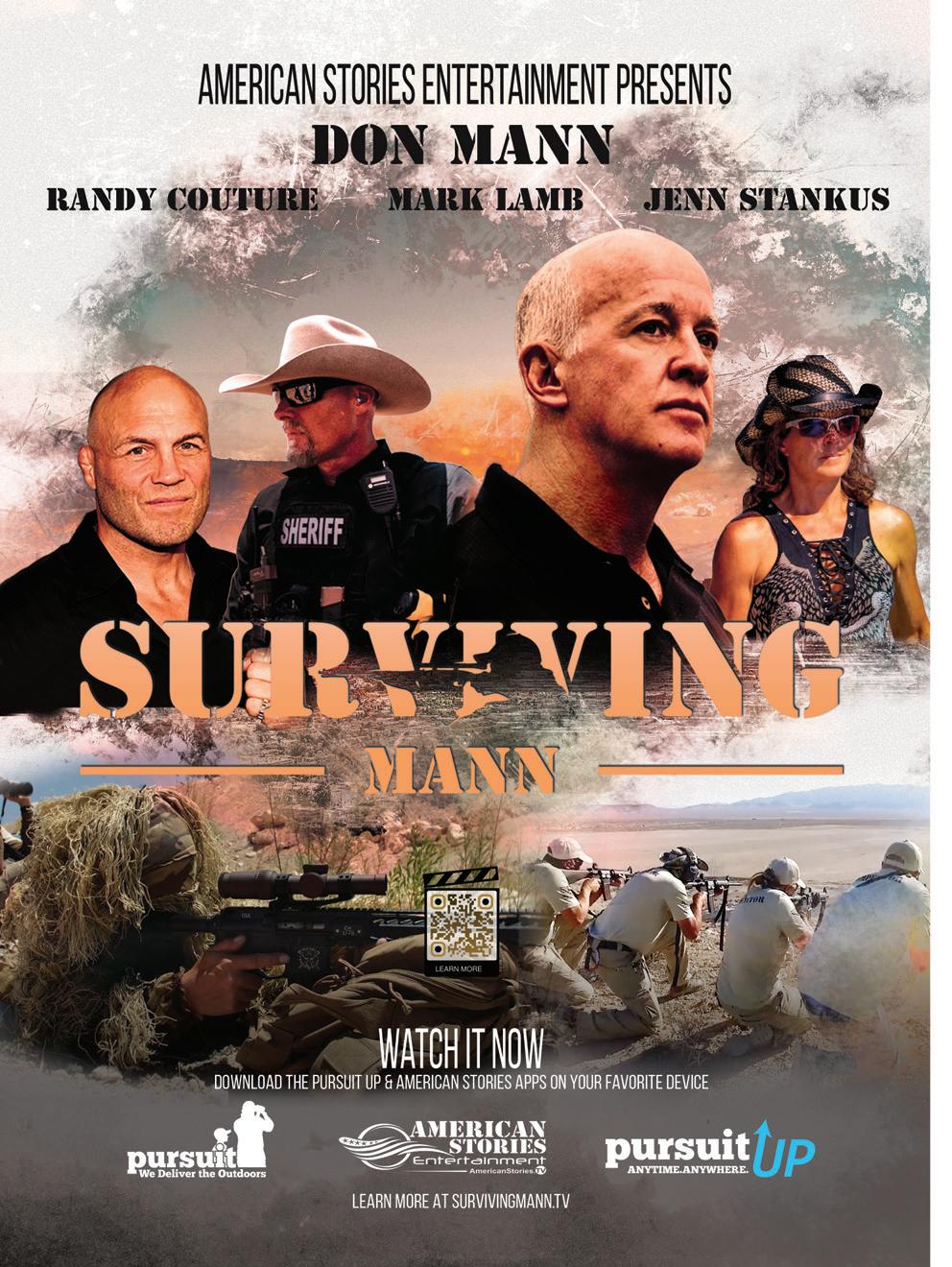




Volume 13 // Issue 9 // June 2024
PUBLISHER
James R. Baker
GENERAL MANAGER
John Rusnak
EDITOR-IN-CHIEF
Andy Walgamott
OFFICE MANAGER / COPY EDITOR
Katie Aumann
LEAD CONTRIBUTOR
Frank Jardim
CONTRIBUTORS
Brittany Boddington, Graciela Casillas, Scott Haugen, Ash Hess, Phil Massaro, Fred Mastison, Mike Nesbitt, Paul Pawela, Nick Perna
SALES MANAGER
Paul Yarnold
ACCOUNT EXECUTIVE
Tom St. Clair
DESIGNERS
Gabrielle Pangilinan, Lesley-Anne Slisko-Cooper
PRODUCTION ASSISTANT
Emily Baker
WEBMASTER / INBOUND MARKETING
Jon Hines
INFORMATION SERVICES MANAGER Lois Sanborn
ADVERTISING INQUIRIES ads@americanshootingjournal.com
ON THE COVER
Donald Trump Jr. and sons Spencer (left) and Donnie enjoyed good hunting for ptarmigan in Alaska last September, part of a cast-and-blast adventure with Don Jr.’s buddy Scott Haugen. (SCOTT HAUGEN)



Website: AmericanShootingJournal.com Facebook: Facebook.com/AmericanShootingJournal X: @AmShootingJourn
MEDIA INDEX PUBLISHING
6 American Shooting Journal // June 2024
SHOOTING JOURNAL AMERICAN
GROUP 941 Powell Ave SW, Suite 120, Renton, WA 98057
382-9220 • (800) 332-1736 • Fax (206) 382-9437
(206)
media@media-inc.com • www.media-inc.com

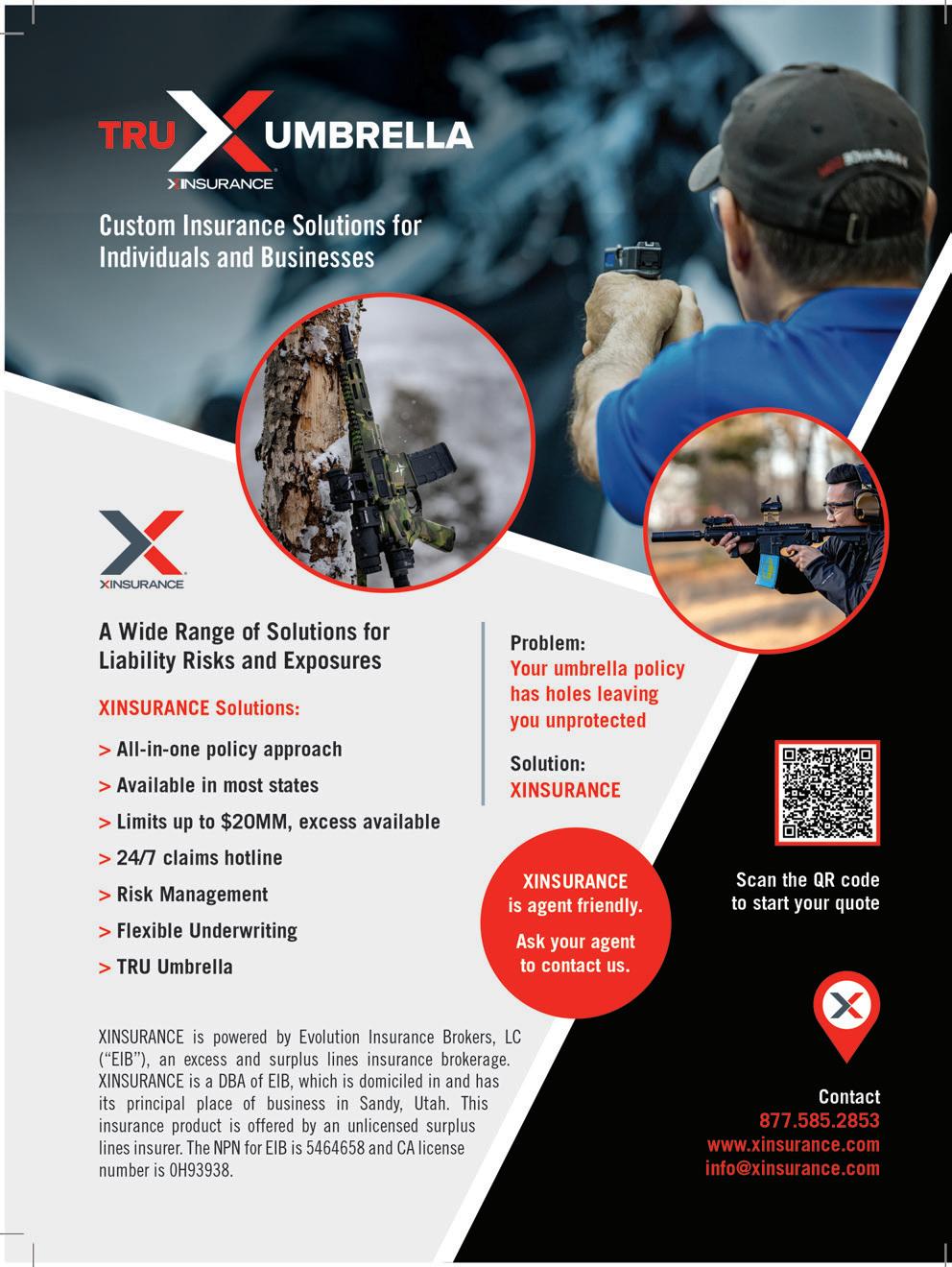
PTARMIGAN WITH THE TRUMPS
The weather didn’t always cooperate there in southwest Alaska, but when it did, Donald Trump Jr. and sons Donnie and Spencer had a heyday hunting ptarmigan on the tundra. Longtime contributor Scott Haugen recounts he and his friend’s September cast-and-blast far away from the white-hot glare of national politics.
46 GUN REVIEW: MARLIN 1894 .44 REM. MAG.
Fred Mastison was excited to hear that Marlin had released a longtime favorite lever-action in a new caliber. Our gun reviewer puts the rifle chambered in .44 Remington Magnum through its paces and offers up some thoughts.
76 SPOTLIGHT ON SURVIVING MANN
With season three of Surviving Mann set to air this summer, Paul Pawela takes a closer look at eponymous show host Don Mann, a veteran of SEAL Team 6, and what his eight contestants face in their grueling physical, mental and teamwork challenges.

93 POSITIONAL SHOOTING
Seated on a bench with the support of a table and bipod might be the most stable way to shoot a rifle, but it’s rare to enjoy such steady rests in real life. That makes Army and law enforcement vet and hunter Nick Perna’s ranking of the best shooting positions good to know.
108 GUN REVIEW:
SAR9C: THE COMPACT 9MM THAT CAN SAY, ‘MY DAD’S IN NATO’ You can spend a lot more on similar scaled-down semiautomatic pistols from bigger names, but SAR USA’s Turkish-made SAR9C “delivers the most value for the money,” argues our lead contributor Frank Jardim.
americanshootingjournal.com 9
CONTENTS AMERICAN SHOOTING JOURNAL is published monthly by Media Index Publishing Group, 941 Powell Ave SW, Suite 120, Renton, WA 98057. Display Advertising. Call Media Index Publishing Group for a current rate card. Discounts for frequency advertising. All submitted materials become the property of Media Index Publishing Group and will not be returned. Copyright © 2024 Media Index Publishing Group. All Rights Reserved. No part of this publication may be copied by any means, electronic or mechanical, including photocopying or recording by any information storage or retrieval system, without the express written permission of the publisher. Printed in U.S.A. VOLUME 13 • ISSUE 9 COVER STORY
FEATURES
16
(SCOTT HAUGEN)
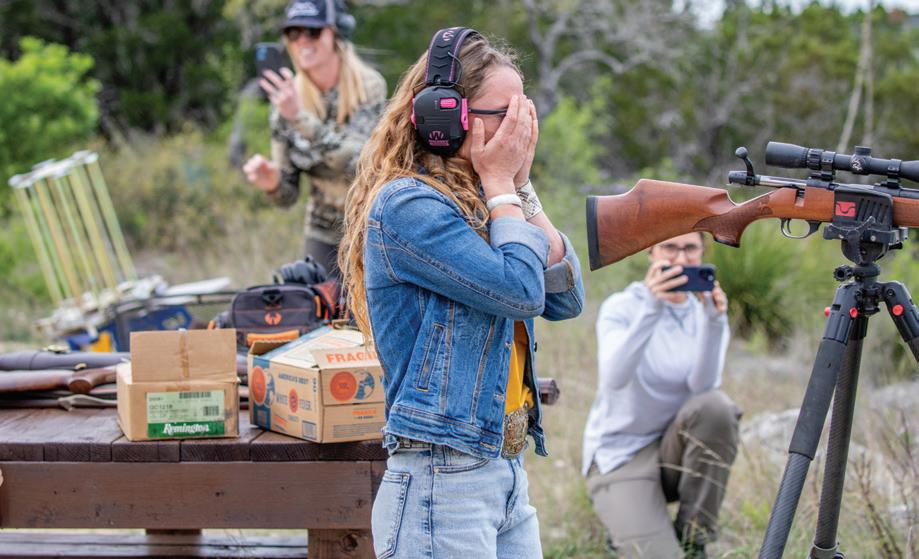
SHE HUNTS: A MEMORABLE SPRING CAMP SEASON
It wasn’t all fun and learning about big game at She Hunts Skills Camp this spring. There was also a very unique marriage proposal for one attendee, while a graduate gained the confidence to take the field alone for her first harvest! Brittany Boddington shares their stories.
MORE FEATURES
37 R OAD HUNTER: FOR THE LOVE OF VELVET
True, you can’t eat velvet, but you can sure eye it up for later. With big bucks at their most visible in summer, now is a great time to begin patterning deer for fall. One expert details how he makes the most of hot-season scouting.
55 BULLE T BULLETIN: THE PROJECTILES OF THE .45-70 GOVERNMENT
Despite being 150-plus years old, the .45-70 Government remains a viable and effective hunting cartridge. So states our professor of projectiles, Phil Massaro, who shares an appreciation and all the available options, from cartridges to components, on tap in the market.
69 BL ACK POWDER: FIRST THOUGHTS ON THE NEW 1ST SERGEANT
Ever imagine getting your hands on the very first model of a new firearm? That’s what Mike Nesbitt fell into with the 1st Sergeant, a .45-70 from C. Sharps Arms that honors a sharpshooting Battle of the Little Bighorn survivor. With this month’s Matthew Quigley Buffalo Rifle Match on his mind, Nesbitt and a buddy take it to the range for his report.
87 TACTICAL TRAINING: STABILITY IS KING
Look, Ash Hess is not calling you fat, but to be a better shooter, our marksman instructor wants you to think of yourself as a tank. It will all make sense after you read his spot-on advice – and have you running like an Abrams.
99 TACTICAL TRAINING: BETWEEN THE BATTLEFIELD AND THE BOARDROOM
Graciela Casillas interviewed military and nonmilitary executive protection specialists who also serve as instructors to get a better understanding of how the military process differs from that of civilian training.
117 NEW COLUMN! MAKING THE CUT: KERSHAW’S TACTICAL FOLDING KNIVES
A good knife has been a critical tool and/or self-defense weapon for ages and in his new column, Paul Pawela will detail all things sharp-edged that meet the task. He kicks things off with a look at Kershaw’s Helitack and reverse tanto Iridium knives.
125 L AW ENFORCEMENT SPOTLIGHT: IN PRAISE OF PROACTIVE POLICING
There was a lot going on that April 1995 morning, but a missing license plate spotted by a sharp-eyed Oklahoma State Trooper ensured a domestic terrorist would receive justice. Nick Perna shares praise for proactive police like Charlie Hanger keeping America safer.
DEPARTMENTS
13 Gun Show Calendar 15 Competition Calendar
10 American Shooting Journal // June 2024 CONTENTS 99
(BRITTANY BODDINGTON)
27



Coffee for the Crayon Eater that wants to make something special (Roasted in a peanut/tree nut FREE facility)






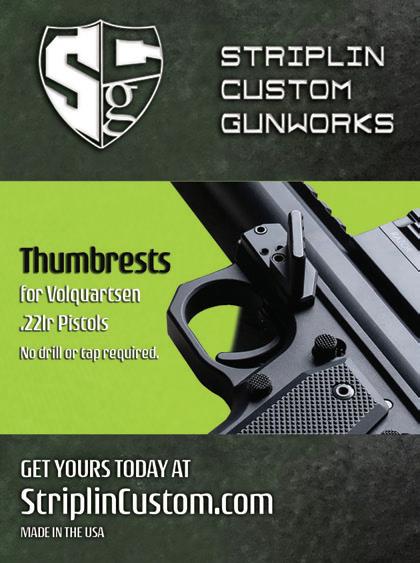
12 American Shooting Journal // June 2024
crayoneatercoffee com
June

SHOW
americanshootingjournal.com 13 PRIMER
Fayetteville, N.C. Crown Expo Center
15-16 Raleigh, N.C. NC State Fairgrounds
Hamilton, Ohio Butler County Fairgrounds
22-23 Dayton, Ohio Montgomery County Event Center July 20-21 Roanoke, Va. Salem Civic Center
22-23 Mesa, Ariz. Centennial Hall
13-14 Phoenix, Ariz. Arizona State Fairgrounds
20-21 Reno, Nev. Reno Convention Center
GUN
CALENDAR C&E Gun Shows cegunshows.com June 8-9
June
June 15-16
June
June
July
July
8-9 Fort Myers, Fla. Lee Civic Center
29-30 Palmetto, Fla. Bradenton Convention Center
13-14 Orlando, Fla. Central Florida Fair Grounds
20-21 Miami, Fla. Miami-Dade Fairgrounds
Tucson, Ariz. Tucson Expo Center June 14-16 Glendale, Ariz. Glendale Civic Center
8-9 Lawrenceville, Ga. Gwinnett County Fairgrounds
8-9 Cape Girardeau, Mo. The Osage Center
15-16 Knoxville, Tenn. Knoxville Expo Center June 15-16 Kansas City, Mo. KCI Expo Center
22-23 Lexington, Ky. The Lexington Ice Center June 22-23 Marietta, Ga. Machinists Aerospace Union Hall June 29-30 Springfield, Mo. Ozark Empire Fairgrounds June 29-30 Chattanooga, Tenn. Camp Jordan Arena June 8-9 Taylor, Texas Williamson County Expo Center July 6-7 Belton, Texas Bell County Expo Center June 14-16 Colorado Springs, Colo. Norris Penrose Event Center
8-9 Redmond, Ore. Deschutes County Expo Center June 15-16 Centralia, Wash. Southwest Washington Fairgrounds Crossroads Of The West Gun Shows crossroadsgunshows.com Florida Gun Shows floridagunshows.com GunTVShows.com guntvshows.com To have your event highlighted here, send an email to kaumann@media-inc.com. Real Texas Gun Shows therealtexasgunshow.com Tanner Gun Shows tannergunshow.com Wes Knodel Gun Shows wesknodelgunshows.com RK Shows
June
July
July
June 8-9
June
June
June
June
June
rkshows.com


COMPETITION CALENDAR

usashooting.org
June 23-29
Para Trap World Cup Hillsdale, Mich.

uspsa.org
June 6-9
Area 8 Championship Bulger, Pa.
June 6-9
Nor Cal Section Golden Bullet Championship Richmond, Calif.
June 24-30
2024 Rifle and Pistol National Championship Fort Moore, Ga.
June 14-15
Treasure State Championship Billings, Mont.
June 15-16
Inland Empire Sectional Benton City, Wash.
July 19-28
2024 Shotgun National Junior Olympics Hillsdale, Mich.
June 26-30
Sig Sauer Carry Optics Nationals Marengo, Ohio
July 17-21
Federal USPSA Multigun Nationals Forest Lake, Minn.

gssfonline.com

cmsaevents.com
June 8-9
Glock Fire on the Mountain Johnstown, Pa.
June 8-9
Beaver State Ballistic Challenge Dundee, Ore.
June 8-9
Virginia State Championship Doswell, Va.
June 14-15
South Carolina State Championship Pendleton, S.C.
June 7-9
Alabama IDPA State Championship Birmingham, Ala.

idpa.com
June 8
Wisconsin IDPA Championship Ripon, Wis.
June 15-16
Garden State Regional Classic Jackson, N.J.
June 22-23
Bourbon Country Classic Lawrenceburg, Ky.
June 15-16
Oregon State Shoot Prineville, Ore.
June 22
Mid Mountain Regional Eaton, Colo.
June 20-22
Illinois State IDPA Championship Sparta, Ill.
June 20-22
Delaware State IDPA Championship Bridgeville, Del.
June 22-23
Montana Glock Classic Missoula, Mont.
July 13-14
Buckeye State Ballistic Challenge Wingett Run, Ohio
June 29
Maine State Championship Litchfield, Maine
July 6
Colorado State Championship Pueblo, Colo.
July 12-14
Pennsylvania State IDPA Championship Hunlock Creek, Pa.
americanshootingjournal.com 15 PRIMER
To have your event highlighted here, send an email to kaumann@media-inc.com.
PTARMIGEDDON WITH THE TRUMPS
SCOTT HAUGEN
Four of us spread out across the open tundra. We hunkered down as if it would somehow conceal us in the bootlace-high cover. Ahead were willow ptarmigan. Lots of them.
Some of the mottled birds scurried into the nearby willows for safety. Others stood on alert, not sure what we were, likely having never before seen a human. A few of the tundra chickens even fed closer to us, but they were just out of range.
We kept inching closer. We were in no rush. Minutes later, the birds were finally in range.
“Spencer, keep walking right at that bird and when it lifts its head or flies, shoot it,” whispered Spencer’s dad. It was Spencer’s first time in Alaska.
I watched Spencer carefully stalk closer. The birds on my end of the flock grew nervous and sauntered out of range. That’s when I put down my gun and pulled out the camera. Tracking Spencer through my telephoto lens, I could feel the tension in his body. I could almost read his mind. Though he was just 9 years old, it was obvious Spencer had handled a gun since an early age. He also knew how to read the birds’ body language and anticipate their moves.
When a mature ptarmigan on the
Afield in Southwest Alaska with Don Jr. and his sons
Donnie and Spencer.
edge of the flock stacked its feathers and stood upright, Spencer shouldered the 20-gauge and fired. Donnie, Spencer’s 14-year-old brother, emptied his double-barrel. Their dad dropped a pair of ptarmies too.
I snapped photos as the three hunters gathered birds – we had no dog – then just watched the trio by using my lens as a monocular. Smiles widened and anticipation mounted as father and sons came together, holding their birds. I could tell they were reliving stories of what had just happened. I gave them space. I had the best seat in the house on this August day.
They looked at the birds, chatted some more, then simultaneously looked at me, as if on command. Cameras are a part of their life back home, or wherever they go. I captured the moment, and though posed, the smiles were sincere.
They stuffed the birds in their vests and kept going. There were more ptarmigan on the horizon. A lot more. Rather than join them, I stayed back. They relished their time together, something I could appreciate having raised two boys of my own in the public eye. I enjoyed capturing it in photos.
Over the course of the next two

16 American Shooting Journal // June 2024
STORY AND PHOTOS BY
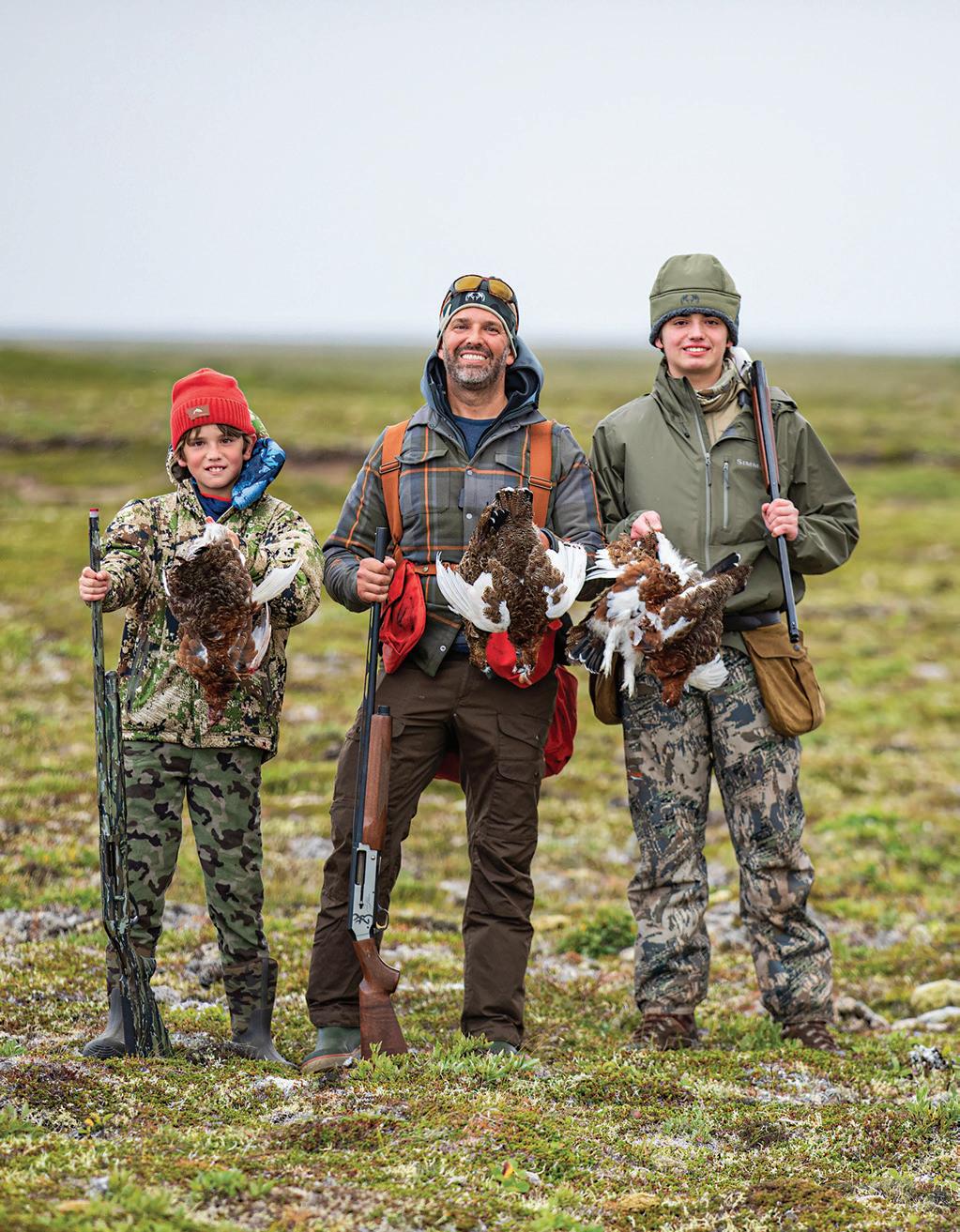 Spencer, Don Jr. and Donnie Trump start a morning off with smiles and fists full of feathers.
Spencer, Don Jr. and Donnie Trump start a morning off with smiles and fists full of feathers.
hours, we covered 8.5 miles. The boys were happy – they’d both just shot their limit of ptarmigan. Their dad, Donald Trump Jr., was proud. He was smiling. He’s always in a good mood when in the outdoors, no matter the situation.
OUR COMING TOGETHER on this cast-andblast adventure wasn’t by chance. Don Jr. had visited me in my home state of Oregon a decade prior, where we hunted black bear together. Our relationship goes back to my TV show hosting days. We’d been trying to get his boys to Alaska for the past few years, but a few things got in the way on their end.
Don and I are in touch on a regular basis, and he’d been wanting to get Spencer and Donnie to Becharof Lodge on Alaska’s Egegik River. I first learned of this river 16 years prior, when hosting TV shows. I book fishing trips for the lodge and in my more than 30 years of traveling throughout Alaska – and having lived there for nine years – it’s the best coho salmon stream I’ve seen.
Unfortunately, the coho fishing was slow last season. No one is sure why. Coho go in cycles throughout their range, something even the best rivers succumb to from time to time.
“That was one of the funnest things I’ve ever done. Can we do it again tomorrow, and the next day?” smiled Spencer, as we huddled on the tundra cleaning ptarmigan, feathers being carried away in the brisk wind. I assured him we’d get back after the birds. It was the most ptarmigan I’d ever seen on this part of the upper Alaska Peninsula. Seeing 500 birds a day was common, and if you were willing to walk, securing a 10-bird limit wasn’t hard.
“How about if we do a flyout tomorrow, then hunt ptarmigan the next day?” Don Jr. suggested. Spencer fired right back: “How about you go on the flyout and I’ll stay back and hunt ptarmigan with Scott?” We all laughed. Spencer was serious.
The next morning we awaited the floatplane’s arrival. We’d planned a flyout for Arctic grayling and char. After four hours of waiting and
communicating with the bush pilot in King Salmon, we finally called it off. The weather was either too bad at Becharof Lodge or in King Salmon to fly. Fog came and went. It was too dangerous to chance it.
We all sat in the lodge, eating Goni’s homemade cookies, bread, brownies and anything else she whipped up for us. I’ve been in a lot of camps around the world, and Goni is one of the best cooks I’ve ever met. The sister of one of the lodge owners and the main chef, Goni eased the pain of waiting for a trip that didn’t happen.
YOU LEARN A lot about a person when the fishing is slow. You learn even more about them when you’re stuck in a remote camp with no way to get to where you want to be. There was never a quiet moment when the Trumps and I were on standby. We shared stories, laughed, told more stories and ate more of Goni’s sweets. Everyone who is reading these words would love hearing the stories of Don
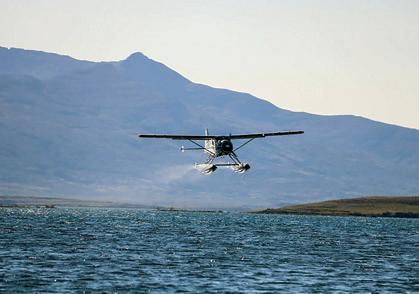


18 American Shooting Journal // June 2024
Long spot-and-stalk approaches are the norm when ptarmigan hunting on Alaska’s vast tundra, and the Trumps never missed a beat.



Remote, Comfortable & Affordable
Our remote Alaskan fishing lodge is situated on the upper stretches of the beautiful Egegik River. You’ll watch some of Alaska’s most stunning sunrises, complete with a distant, active volcano. We are a fishing camp specializing in coho fishing, brown bear viewing, and flyout fishing adventures to even more remote destinations in the Last Frontier.
Coho Fishing The Egegik River
The Egegik River is touted by many experienced anglers as the best silver salmon stream in all of Alaska. Becharof Lodge On The Egegik River was the first fishing lodge to become established on the breathtaking Egegik River, and is less than a 5 minute boat ride from some of the best fishing holes on the entire river.

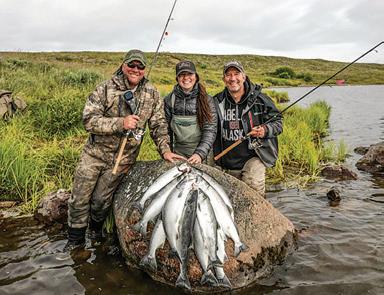
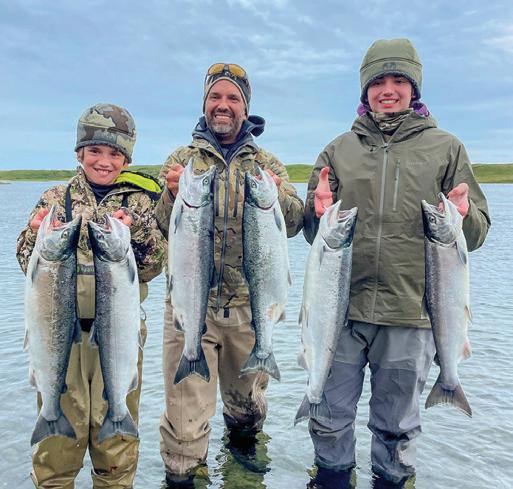
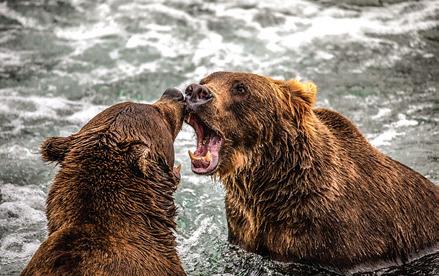
Now Booking for 2025 Coho Fishing Trips
Included in your fishing trip:
• 6 days fishing/5 nights stay in camp
• Experienced, fully guided fishing.
• Comfortable cabins furnished with beds, cozy comforters & bedding.
• Home cooked meals, snacks, and nonalcoholic beverages.
• Transportation from the lodge to prime fishing holes on the Egegik River.
• Freezing and vacuum sealing of your fish, up to 50 lbs., per angler.

$4,850per person Includes round trip charter from King Salmon. Call for more details.
becharoflodgefishing.com Book Your Trip Today! Mark Korpi: 503-741-1333 or 503 298 9686 George Joy: 360-562-7701 Email: becharoffishing@gmail.com

Jr. and the excitement and depth of knowledge in which they’re told. He’s just like us when it comes to loving everything hunting and fishing.
“Why don’t you guys go ptarmigan hunting?” Mark Korpi, co-owner of Becharof Lodge, chimed in. “All our boats are out, but you can just walk from here.” Spencer was out the door before the rest of us even stood up.
Becharof Lodge is situated on Native land, near Becharof National Wildlife Refuge. No hunting is allowed on the private land or within 2 miles of the river or Becharof Lake, Alaska’s second biggest lake. This is a do-ityourself bird hunt, as there are no licensed hunting guides at the lodge. It’s easy. The ground is rolling tundra, simple to walk on and flat, making navigation straightforward.
“Let’s go, you guys, what’s taking so long?” hollered Spencer, who was already dressed and ready to hike. The rest of us were still enjoying our

20 American Shooting Journal // June 2024
The Trump trio heads out from Becharof Lodge on Southwest Alaska’s Egegik River to chase ptarmigan on the tundra. “... (The) fact the boys had to work at it this week was the best thing for them,” said Trump Jr. of the miles Spencer and Donnie put in hunting the upland birds.
Trump Jr. displays one of many ptarmigan from the day.


Get ready for the Get ready for the FALL HUNT! FALL HUNT! Join our duck club for the ‘24-25 season Join our duck club for the ‘24-25 season siducks.com Our club sits in the middle of a premier waterfowl flyway, and is a mallard haven! We have several blind areas to capitalize on weather conditions and minimize member contact. Contact Ron Spada at 503-539-5396 with any questions or to set up a time to tour the club.
coffee and snacks.
But hurry, we did. Spencer’s enthusiasm was contagious. The sandy, rocky soil made for the easiest walking I’ve ever done on tundra, and I’ve covered a lot of ground throughout the state.
Soon we were in a huntable area and ptarmigan were everywhere. It was windy and this kept birds in big flocks, close to alder patches. It made the stalking and jump-shooting fun and exciting.
Along the way we encountered red fox and brown bear. A sow and two cubs skirted us all afternoon. The grinding calls of sandhill cranes could be heard in the distance. Fresh
wolf and moose tracks pocked sandy stretches of soil. We found caribou sheds but left them. I shared stories of how the very spot we stood was once home to hundreds of thousands of caribou. We saw one bull that day. They’re gone now, but you could see in the boys’ eyes that they were imagining what it must have looked like to see that many animals on the open tundra. We covered just shy of 6 miles that day. The ptarmigan were concentrated, and the shooting was fast with few misses.
THE
NEXT
DAY,
Don Jr. and his boys went with George Joy, the other co-owner of Becharof Lodge, to visit the village

of Egegik. The tiny community of less than 30 residents sits at the mouth of the Egegik River, 30 miles downstream of the lodge. They saw pods of beluga whales hunting salmon and got a taste of what commercial fishing is like. They met some of the elders too, including Scovi, the mayor of Egegik. I love Scovi and her family. I love the village of Egegik. I could live there.
While the Trumps toured the tiny town, my hunting buddy from home, Austin Crowson, and I stayed back to hunt ptarmigan. We hiked in a different direction than the prior two days. We covered over 11 miles but got our birds. It was a beautiful day on the tundra. Good exercise too. We took home lots of ptarmigan, my favorite eating of all upland birds.
The next morning, we watched as the sunrise glowed red on the horizon. “The bushplane will be here in 30 minutes, so be ready,” smiled Korpi. The Trumps, myself and head guide David Stumpf were soon in the air, headed to a remote stream. It poured all day. The creek was high, far from easy to navigate. Because of the high water, we had to get dropped off at a lake and hike over 2 miles in waders to reach the fish. It was the same hike on the way out, only uphill. It wasn’t easy. The boys never complained one time. The char and grayling fishing was exceptional, which eased the pain. We made it back to the lodge just before dark.
We were tired, cold and hungry. Goni’s cooking never tasted so good. “Dad, can we go ptarmigan hunting in the morning?” Spencer asked. It was obvious what Spencer’s first love was. He was a good little angler. He worked hard and caught coho. But the kid loves bird hunting.
The next morning I stayed back. It was our final day in camp and I wanted the Trumps to enjoy their family time, a rarity with their lifestyle.
DON JR. AND I never talk politics. We don’t discuss the world’s problems. We focus on the now. All conversations are about hunting, fishing and family –things we enjoy most and are in control of, at least to some degree.
On this trip to Alaska, the
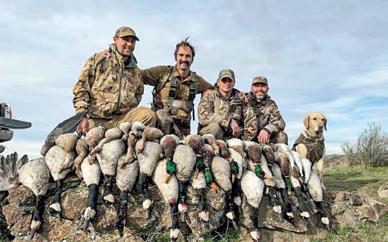

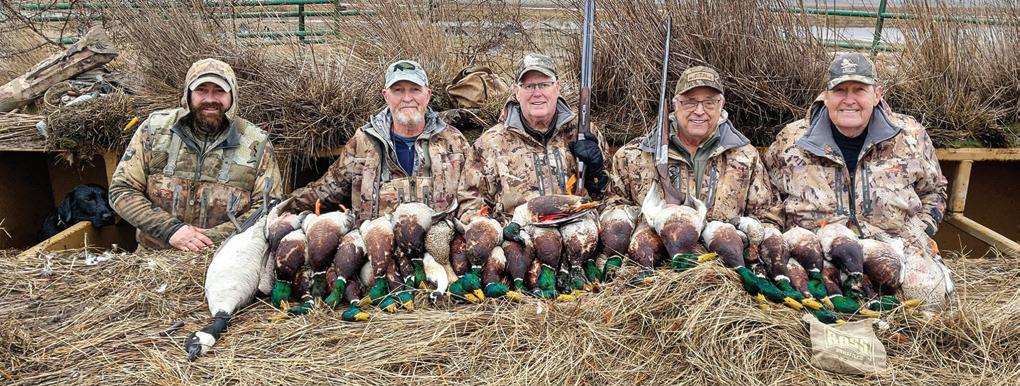
22 American Shooting Journal // June 2024
Author Scott Haugen and Trump Jr. have shared some fun times in the outdoors, including their most recent trip to fish for coho salmon and hunt ptarmigan on the upper Alaska Peninsula.








Also Available: Hunts in Saskatchewan, Canada! Mallard Corn Pond Hunting - In the ’24-25 season we are adding 12 more flooded corn ponds in addition to our existing ponds E. Washington Columbia Basin • 509-967-2303 • pacific-wings.net We normally average 6 ducks per person per day during the hunting season 7 mallard limit per person per day and 107 day season in Washington See our videos on YouTube @PacificWingsHunting and Jay Goble Check Us Out On

ptarmigan hunting saved the day. Multiple days.
“You know, everyone thinks just because you’re in Alaska that everything will come easy,” shared Don Jr. “That you’ll catch fish on every cast and see moose around every corner. That’s not the reality, and the fact the boys had to work at it this week was the best thing for them. That’s what Alaska teaches you. This was a great experience!”
As always, we enjoyed our time together. There’s always something to do at Becharof Lodge, be it fishing, ptarmigan hunting, wildlife watching, berry picking, beachcombing or sitting inside with a hot cup of cocoa and eating Goni’s fine food. It’s a magical place, one I keep going back to and one I was honored to share with Donald Trump Jr. and his two sons. ★
Editor’s note: To book your cast-andblast adventure at Becharof Lodge on the Egegik River, email Scott Haugen at sthaugen@yahoo.com. Learn more about this trip at scotthaugen.com.
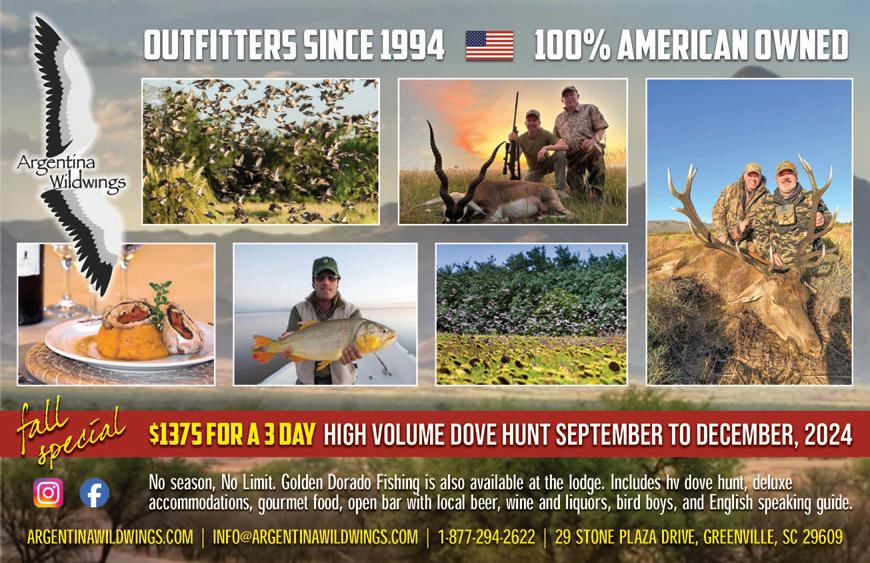

24 American Shooting Journal // June 2024
Austin Crowson, Haugen’s hunting partner from Oregon, got his first taste of ptarmigan hunting and can’t wait to get back to the open tundra of remote Alaska.


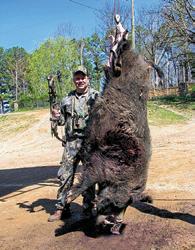

A Unique Big Game Hunting Ranch
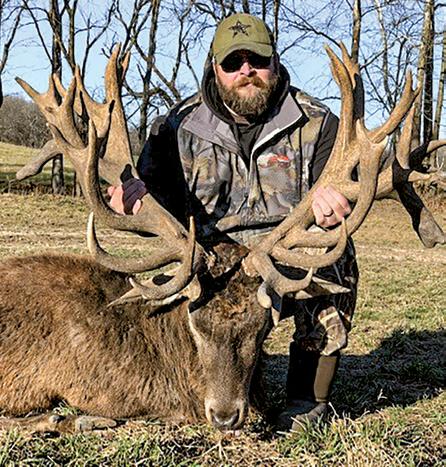
Nestled in the foothills of the Ozark Mountains in Missouri, High Adventure Ranch offers all of the excitement of western big game hunting without the costs and hassles.
Be prepared for a fair chase hunt! With over 3 square miles of prime natural habitat, our ranch provides challenges to even the most seasoned hunter, but our experienced guides and “No Game, No Pay” policy practically ensure that you won’t go home empty handed. In addition, High Adventure’s hunting season is year-round, allowing ample time to fit the most demanding schedule.
While our whitetail, elk, wild boar and red stag hunts top our hunter’s most popular lists, hunters from around the world have visited our ranch, hunting everything from American bison, black buck, fallow deer to Spanish goats and African game.
So, whether you desire a 10-point whitetail mount for your trophy room or simply the thrill and challenge of taking down one of our many elusive big game animals, High Adventure Ranch guarantees memories of an unparalleled hunting experience that will bring you back again and again.
We have a “No Game, No Pay” policy. You can’t get that out West or anywhere else. Call Brad 314-578-4590 bpuff@highadventureranch.com highadventureranch.com We are 8,000 miles closer than New Zealand. We are in Missouri and have red stag. Red Stag
Red Stag
Wild Boar
Whitetail
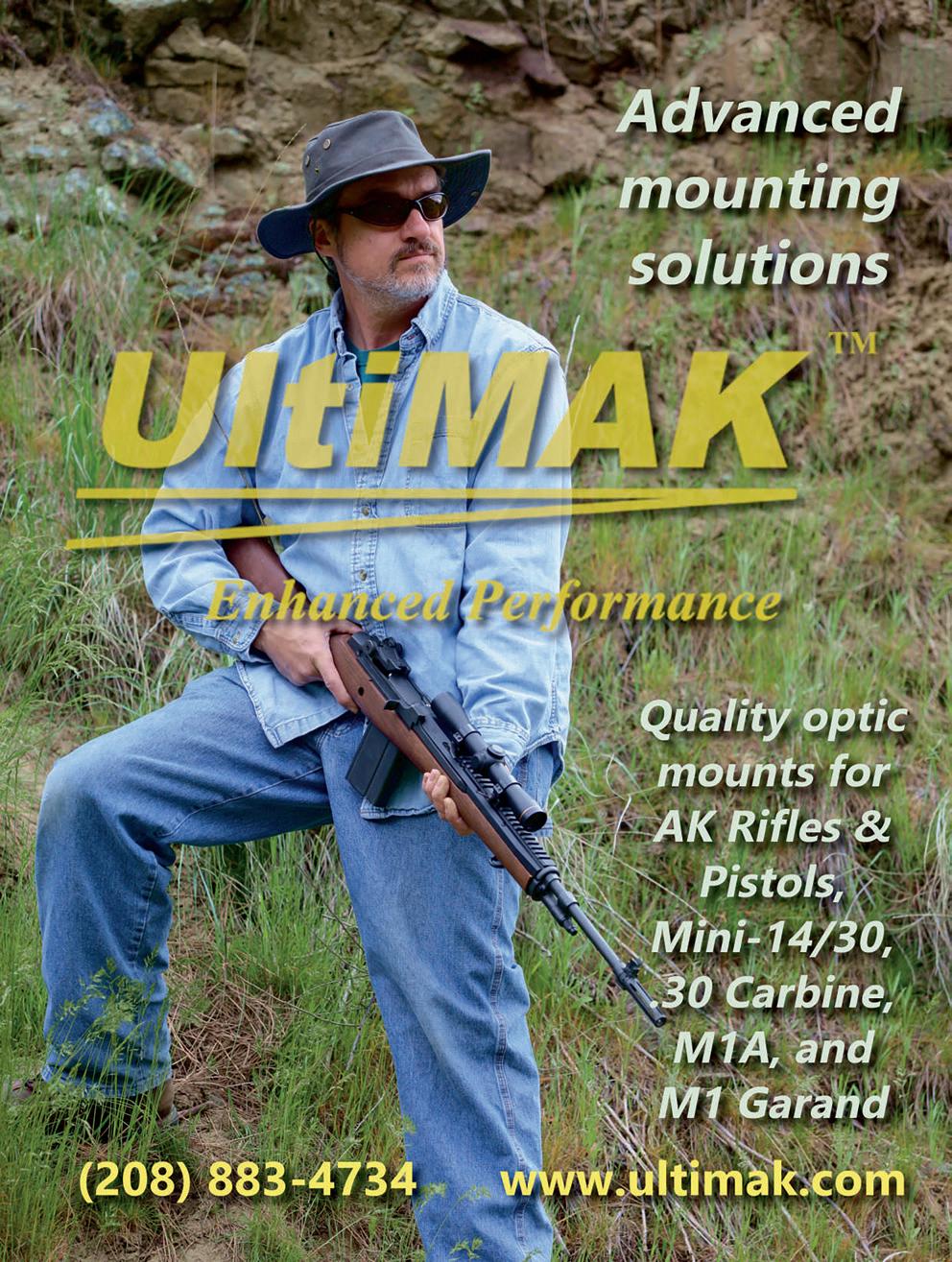
she HUNTs

A MEMORABLE SPRING CAMP SEASON
Unique marriage proposal, confidence gained to take the field alone highlight She Hunts skills courses.
We just wrapped up our spring camp season with another batch of amazing ladies who came through camp. We had a lot of first-time hunters take their first animals at this year’s camps, as well as some who waited until afterwards and hunted on their own. We could not be more proud of the ladies’ accomplishments. There are two very memorable moments that I’d like to share with you.

DURING OUR VERY first camp of the year, we had a fabulous group of ladies, one of whom is actually an employee of our family ranch. She is an avid outdoorswoman but wanted to gain more firearms handling knowledge in order to be more confident as a guide on the ranch. Her name is Dakota and she just turned 24. Her boyfriend Ethan also works for us and is very supportive of her building up her knowledge in the outdoors. He had mentioned to me months prior that he was having a ring made and wanted to figure out a special
way to propose to Dakota. We started brainstorming and came up with the idea to do the proposal at camp since they had friends who worked at RecordBuck Ranch and our additional staff would also be present to support them. Ethan and Dakota had been together for years and are the cutest couple ever, so we were very excited to help them any way we could.
Ethan suggested that we do the proposal at the shotgun range up on the top of the beautiful Texas Hill Country landscape. Not only would it be perfect for photos, but it happens to be where
americanshootingjournal.com 27
STORY AND PHOTOS BY BRITTANY BODDINGTON
Dakota faced some serious pressure to make this special shot at author Brittany Boddington’s hunting skills camp in Texas, but she did a great job.
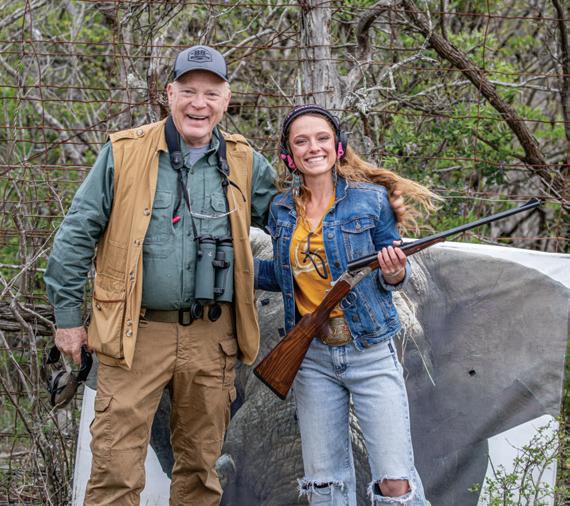
they shared their first dance on a hilltop date early in their relationship. Ethan got to work making a giant wooden sign that he would later hide in the valley below the hill for her to shoot at. The sign read, “Dakota Rae, will you marry me?” and had a tiny spot to shoot at that
read “No” and a giant spot complete with a hefty container of Tannerite for her to shoot at that read “YES.”
We devised a plan to do the proposal at the conclusion of our seminar on hunting dangerous game taught by my dad, Craig Boddington. In this seminar,
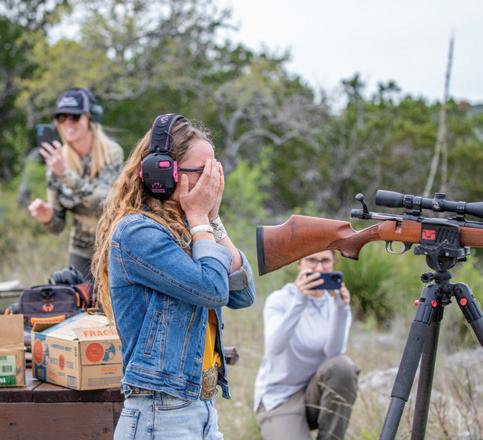
each of the girls goes on a mock stalk and gets to shoot at a life-size dangerous-game target. It might sound boring, but my dad is a great actor and makes it suspenseful and tons of fun. I had Dakota go last for the hunt and once she was out of sight on the other side of the hill, Ethan set up the target and hid in the bushes, where he had been waiting for hours so she wouldn’t know he was even on the ranch.
When Dakota finished the mock hunt with my dad, I walked her back over to the top of the hill and told her she had one more thing to shoot. We had a rifle on a tripod pointed at the sign. Looking confused, she started to approach the gun, and that’s when one of the jeeps parked nearby started playing the song she and Ethan had first danced to. She immediately caught on and started to tear up. She got on the gun and saw the sign and when she took her head off the rifle and looked around, Ethan had come up beside her and was down on one knee. She cried and she shot and she cried some more and she said yes. We had stashed champagne up on the hill in a cooler, so after the shooting was finished, we all celebrated with a champagne toast. We utilized our
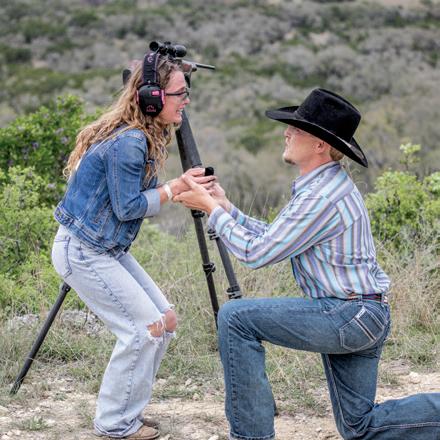
28 American Shooting Journal // June 2024
SHE HUNTS
The moment the music started, Dakota saw the sign and figured out exactly what everyone was up to.
When Dakota turned around, boyfriend Ethan was down on one knee with the custom ring he’d had made.
Dakota’s big surprise would come after the seminar on dangerous game taught by the author’s dad Craig Boddington.
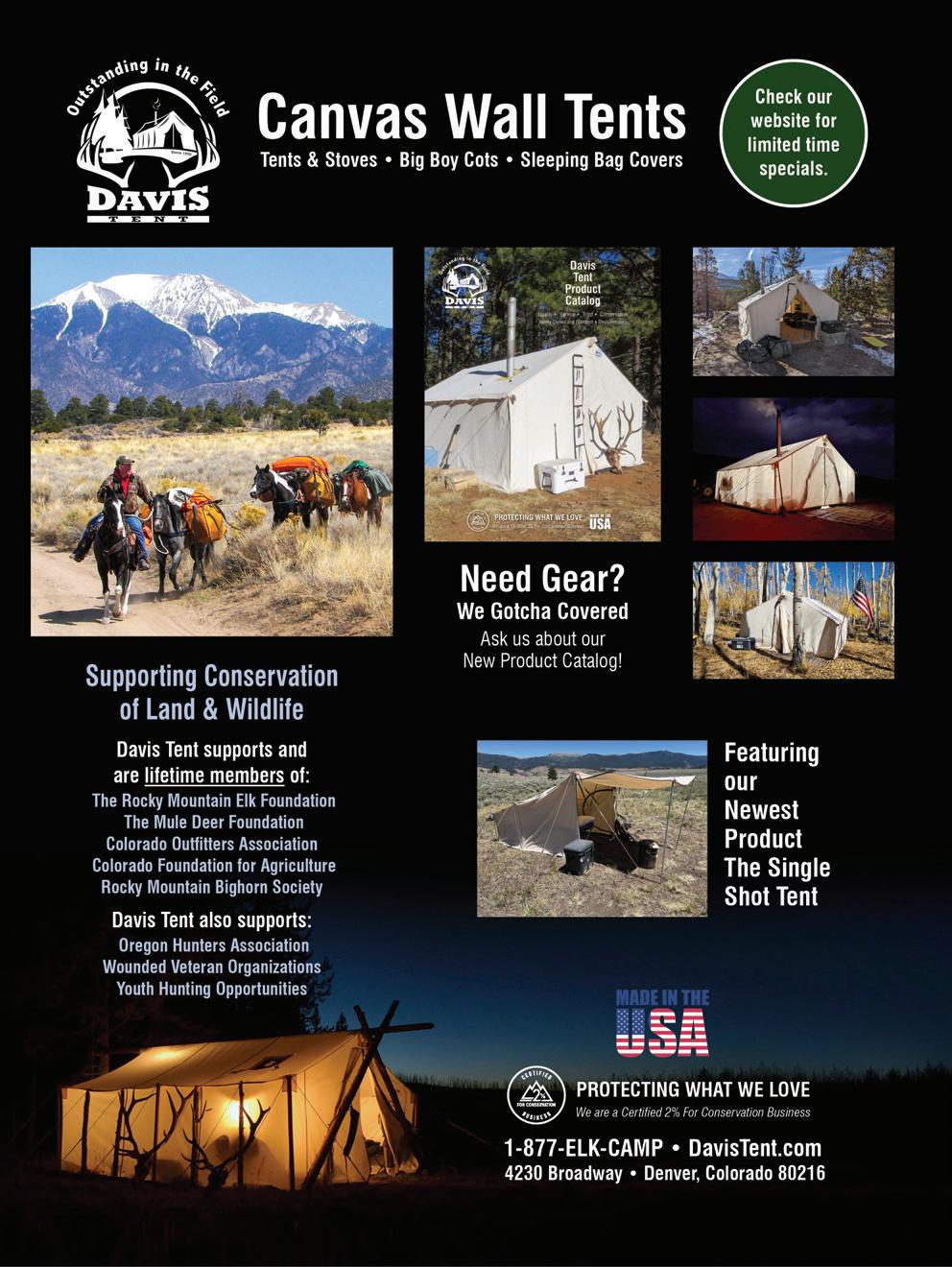
SHE HUNTS
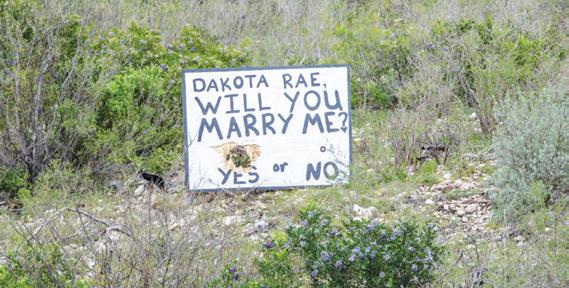
resources at hand and our She Hunts camp photographer to get fabulous engagement photos.
It was such a special experience to be part of and all the campers celebrated with Dakota and Ethan that evening. The really special thing that is also hard to describe about our camps is the bonds that are created here. It really is a sisterhood and we were so happy to share this special day with Dakota while she was in camp.
IT’S NOT AN easy task to follow something like an epic engagement, but one story really sticks out to me from the second camp this year. I had a lady walk by our booth in Nashville at Safari Club International’s Annual Convention and stop. She stood there for a moment while we were talking to other clients and then walked over and asked us what we were all about. Kayla Stevens was a bit hesitant to book and wanted to know all the details about the ranch, the staff
and the logistics. I could sense that she was nervous, so I left the booth with her and walked her over to the RecordBuck Ranch booth, where I introduced her and her husband to the managers there. They chatted while I scurried back to my booth and, sure enough, Kayla made her way back over and booked with us.
When Kayla came to camp, I made sure to assign her an awesome roommate. One of our personal friends was also in that camp and happened to have the same first name, so my pair of Kaylas made for perfect roommates. Kayla’s husband is a big hunter and up until that point she had been convinced that hunting was very much his thing and not hers. She was interested in going with him to some of the exotic places that he traveled to hunt and wanted to be able to share those experiences with him but didn’t feel comfortable around the guns or the hunting ... yet.
Kayla had never pulled a trigger before she arrived in camp. The first time

30 American Shooting Journal // June 2024
Dakota and Ethan with the author’s “ranch family.”
Ethan’s sign for Dakota to shoot at to give her answer to his marriage proposal. Looks like it was a yes!
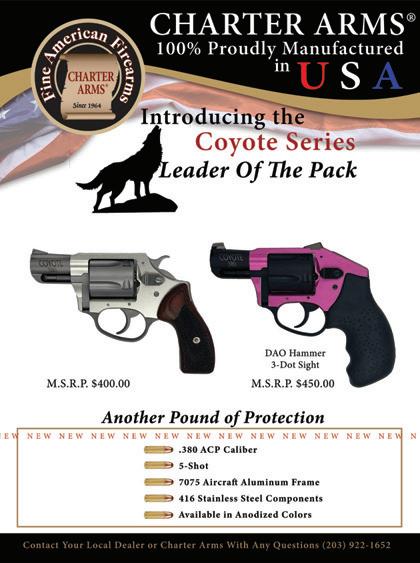
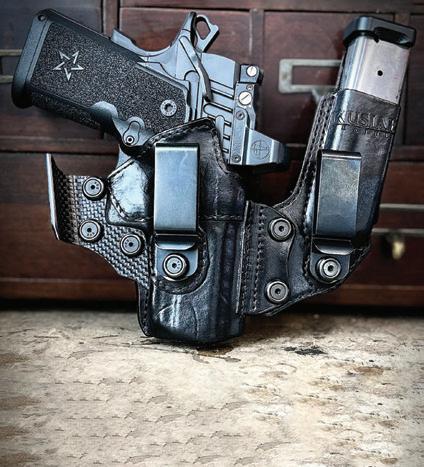



americanshootingjournal.com 31 kusiakleather.com 210.729.2777 TEXAN 2.0 IWB HOLSTER use code #TEXAN for 5% off your purchase
SHE HUNTS
at the range, I could tell she was nervous, so I had her come to my coaching station and we talked everything through. We did a few dry fires and I explained the mechanics of what would happen when a bullet was in the gun. She had initially walked up to me saying softly that she did not want to do this, but when I asked her now if she was ready for a bullet to shoot, she just said, “Yes.”
Kayla was shooting a Weatherby Camilla in .223 caliber. I made sure to get her nice and comfortable on the bench and she took to it easily. The first shot was only an inch off the bull’s-eye and the second shot hit it squarely. She was a natural and started to really enjoy the precision in shooting. By day three, she was shooting targets out to 200 yards from all different shooting rests and starting to feel confident doing it. The most fun part to watch was how rapidly her interest in hunting was growing.
Kayla asked a lot of questions in all of the seminars and wanted to know everything about each animal she saw on the ranch. She partnered with another camper who was going out for her first animal and accompanied her while she successfully hunted her first trophy. She started telling her husband about all the adventures they could now go on together and all the dream hunts she was starting to plan for. Kayla did not shoot an animal in camp, but it was clear by the end of her stay that she was going to be a hunter.
A few weeks later, Kayla booked herself a sheep hunt in Texas that she could do on her own. She felt like her first harvest was something she wanted to accomplish independent of her family, just to prove to herself that she could do it. It was a guided hunt in the sense that the guide took her out and they walked in the sweltering Texas heat for two and a half hours until he took her to an open tripod high seat and left her to hunt on her own. This was not the original plan but seemed like the best option; after all that walking, daylight was running out, so Kayla agreed to sit alone. She said the guide told her, “I want you to see from the top, but if you

go up there, you’re gonna have to take the shot completely alone.” She said she just looked at him and thought, “That’s not how I was expecting it to go.” She was thinking that for safety and security the guide was going to tell her when to take the shot. The guide asked her, “Are you comfortable with that?” and she responded, “I’m comfortable. I can do it.”
Kayla told me that in her head she
just kept replaying her shot placement seminar from She Hunts camp. She waited 10 feet off the ground in her oneperson tripod for around 30 minutes until the brush below her started to rumble and a herd of sheep appeared. One sheep was standing off by himself in a perfect broadside stance as if he had seen the shot placement seminar and was playing his part. She took her
32 American Shooting Journal // June 2024
Kayla Stevens with her first blood.
THE PREMIER SPORTING GOODS STORE ON PRINCE OF WALES ISLAND FOR ALL YOUR FISHING, HUNTING, AND CAMPING NEEDS!
KNOWLEDGEABLE STAFF WILL LET YOU KNOW WHERE, WHEN AND HOW!


SHE HUNTS

L et Freedom Ring...
shot and the sheep went backward about 10 yards, then straight up in the air and fell over dead. She texted “Jackpot” to her guide and he returned. They approached the animal and he proudly told her that her shot was perfect. From photo evidence, I can tell you that it was textbook perfect.
Kayla is excitedly awaiting her next hunting adventure in Prague in July and we at She Hunts could not be more proud!
Editor’s note: Brittany Boddington is a former outdoor television host and journalist with 15 years’ experience hosting shows about various hunting adventures around the globe. She has hunted on six continents and collected just under 100 species. With her father Craig’s help, Brittany discovered a love for the great outdoors and has become a passionate hunter and conservationist. Follow Brittany’s adventures on Facebook, Instagram and X.
L et Freedom Ring...


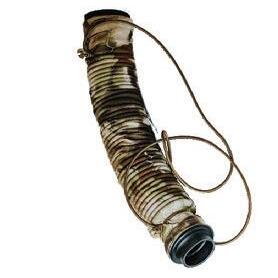

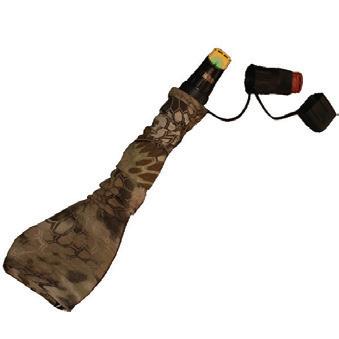

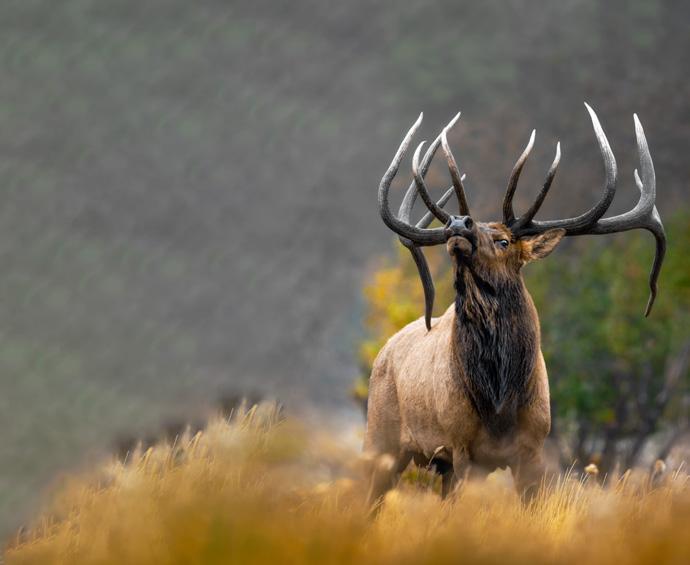
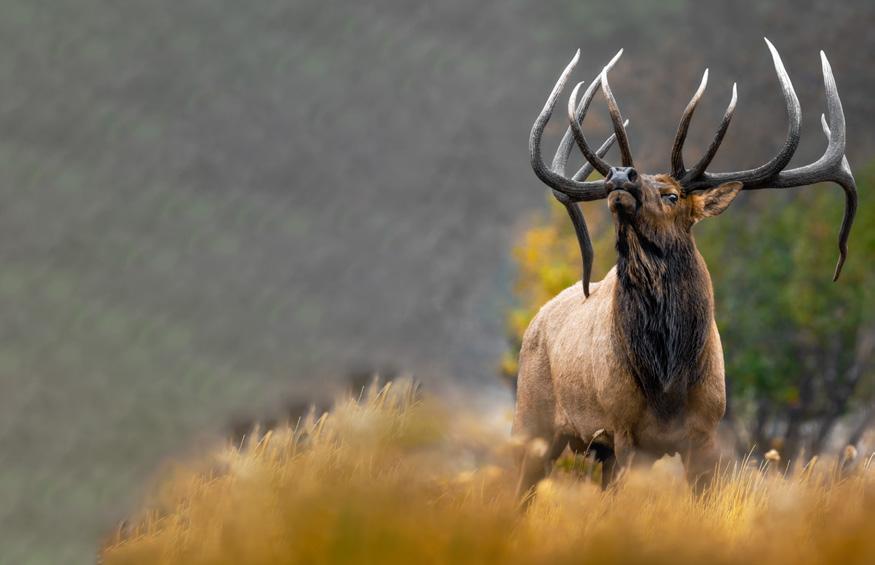

34 American Shooting Journal // June 2024
Quality elk calls made from softer materials to better mimic real elk vocals libertygamecalls.com
This is what success looks like for first-time hunter Kayla.

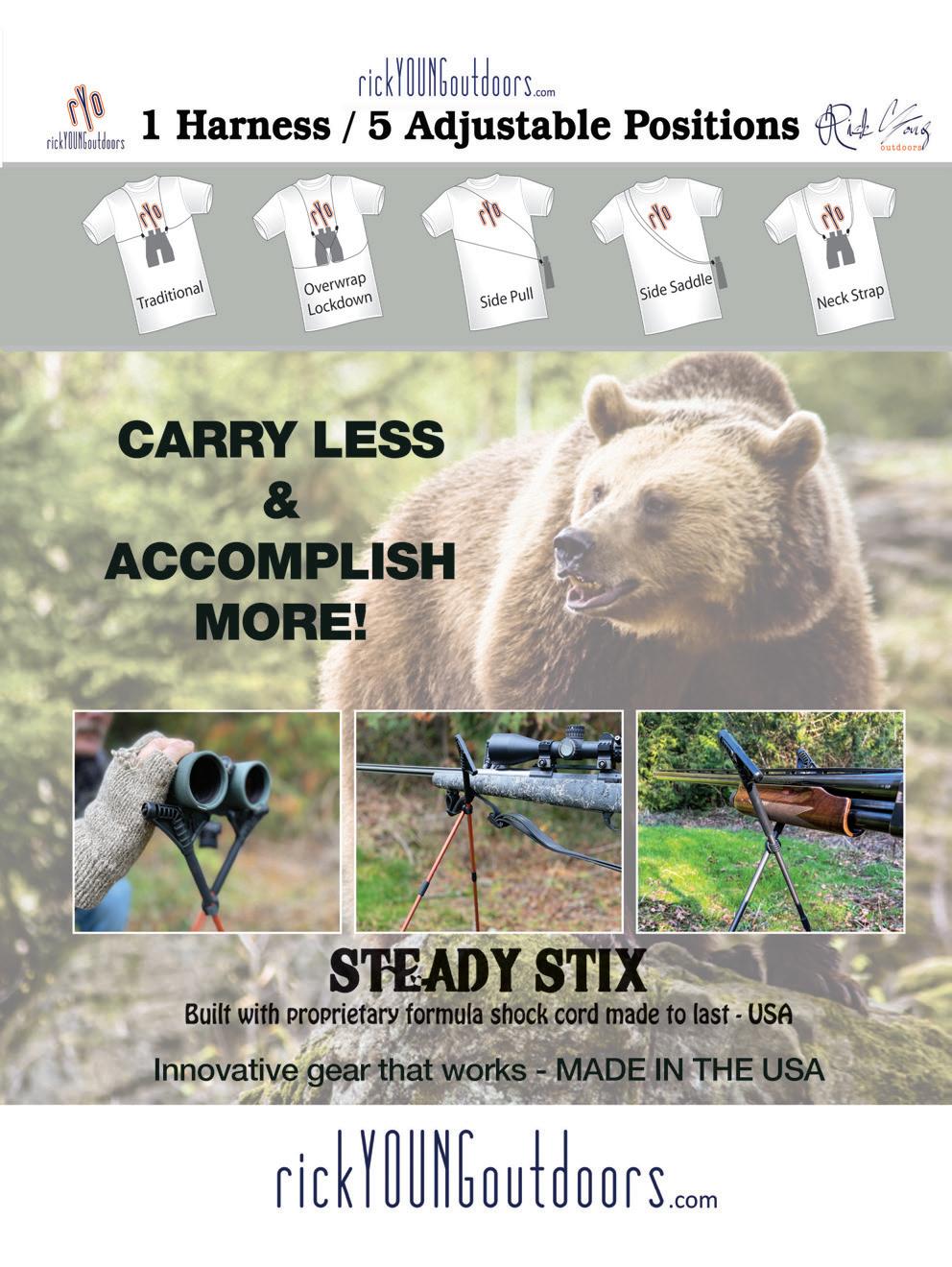
ROAD HUNTER

FOR THE LOVE OF VELVET
Big bucks are at their most visible in summer, making it a great time to scout for fall hunting seasons.
STORY AND PHOTOS BY SCOTT HAUGEN
seriously begin scouting for bucks around the Fourth of July. By this time you can tell how big their velvetcovered racks will be and what herd populations are like.
IOn my first day of scouting the place where my dad shot a nice blacktail two seasons ago, I saw 23 bucks, mostly mature

ones. More than a dozen times I saw the buck Dad eventually tagged. Whether you hold an early-season archery tag and are looking to tag a velvet-racked buck, or you’ll be hunting this fall’s general rifle season, July is the time to get out and scout. When bucks are in velvet, they’re visible. Bucks don’t want to damage their valued headgear, which is not only used as protection against predators, but also for fighting with other bucks during the rut and as a
status symbol.
Velvet racks are engorged with blood, sensitive and easily damaged from May through mid-August. This is why bucks hang out in the open during the summer more than any other time of the year. I like glassing the first few hours in the morning, when bucks are most active. I also like looking for velvet bucks in the late afternoon, as soon as draws and hillsides become shaded. It doesn’t take a big drop in
americanshootingjournal.com 37
Summer scouting is the time to catch big bucks in velvet lurking in the open, like this monster blacktail deer. Doing so will give you a good starting point come hunting season.
ROAD HUNTER
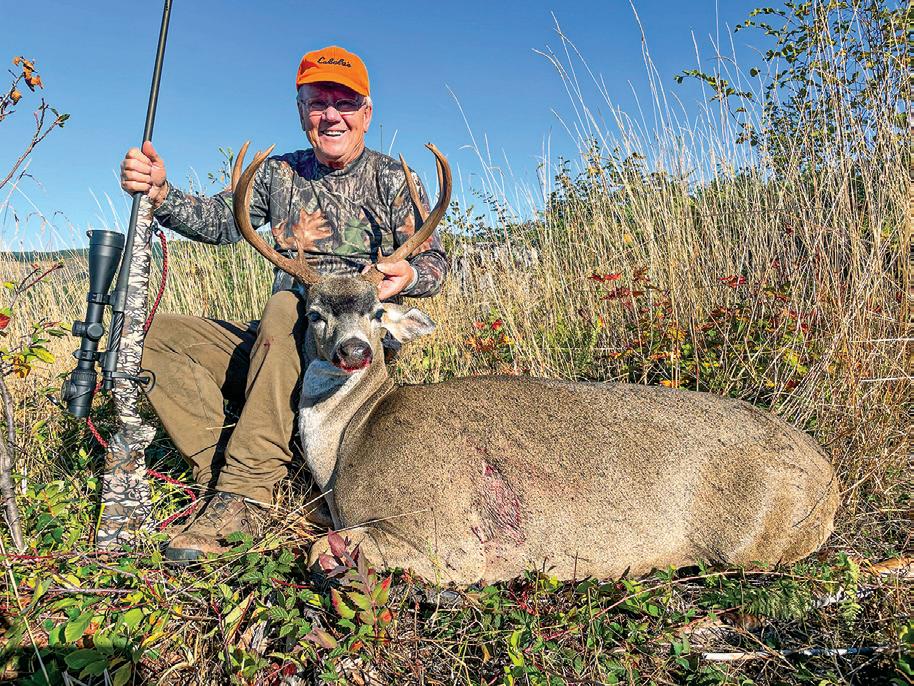
temperature for bucks to start moving and feeding in the hot summer months. Scouting during the hottest part of the day can also be productive. This is because as the sun hits a bedded buck, it will get up to re-bed in the shade. Bucks bedding in open habitat will often change beds multiple times a day, be they blacktails, whitetails or mule deer.
WHETHER YOU’RE HUNTING areas that are familiar to you, or heading to a new place this season, there are certain keys to consider when scouting in the summer. Once you’ve located a buck, study the land. It’s critical that you intimately know the lay of the land so when hunting season comes you can anticipate where a buck might be and know how to get to it.
While hunting bear in early September in Idaho one year, I saw a giant whitetail that had just stripped its velvet. Every evening for four nights in a row, I saw that buck in the same spot. I drew a November deer tag for the unit and hoped to find the buck during the rut. After three days, I finally found it. It was giant and unmistakable. But at over 800 yards away, I couldn’t get a shot. I tried getting closer but ran out of daylight. For two days I looked for the buck with no luck, but I did shoot another dandy I’d also seen in late summer. Because I knew the area, and where those bucks lived, I filled a tag.
A great deal of learning takes place when scouting in the summer. The more you know the land, the better you’ll be able to predict where bucks will be, and
most importantly, understand why. When hunting new land for the first time, try to scout it in the summer when bucks are most visible. So many times and in so many different states, I’ve found more bucks in a single day of summer scouting than I’ll see during the entire time I’m hunting them in the fall and winter months. On July 10 one summer, I saw 17 bucks. I hunted that area for 28 days and saw one legal buck the entire season. I blamed hunting pressure for keeping bucks in deep cover, moving only under the cover of darkness. Had I not seen them in the summer, I wouldn’t have thought there was a deer within miles because sign was sparse in the thick habitat.
Summer scouting reveals how many bucks are in an area and how big they
38 American Shooting Journal // June 2024
Author Scott Haugen’s 81-year-old father Jerry Haugen with a nice blacktail taken on opening morning two years ago. Summer scouting paid off on this hunt.
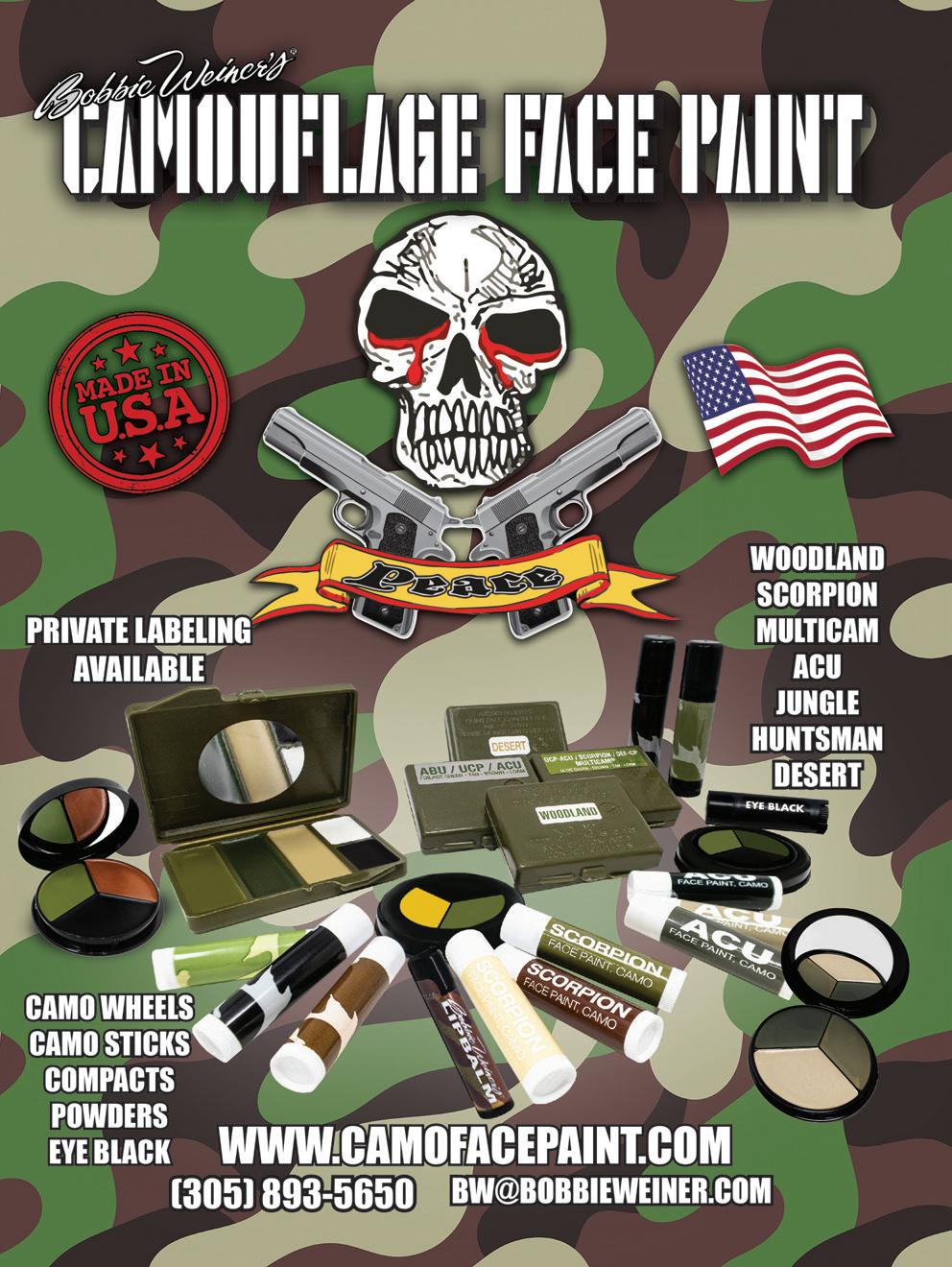
ROAD HUNTER

are. It provides a confident starting point come hunting season.
One July, I was scouting out of state. I found some nice bucks – one whopper – and felt confident they’d be there come the archery opener on September
1. I went back into the area three days before the season and spent hours poring over trail camera footage and scouting. The target buck I’d hoped for showed up nearly every day on one camera or another. Then, the day
before the season, the buck stripped its velvet. I hunted from a ground blind on opening morning, but the buck failed to walk the trail it had been using every day for the past two weeks.
Figuring the buck would soon be nocturnal, I made a bold move and relocated my popup blind very near to where I thought the buck’s core bedding area was. Sure enough, in the closing minutes of legal shooting light, the big buck came down the trail and I arrowed it. Had I stayed hunting where I was, it would have been too dark by the time the buck reached me to get a shot. In this situation, locating the buck in summer when it was in velvet, reading sign during the time of the hunt and understanding the habitat and buck’s behavior all helped me fill a tag.
I’ve had good success over the years scouting wintering grounds in the summer, then returning to hunt in October and November. This is where summer scouting is all about
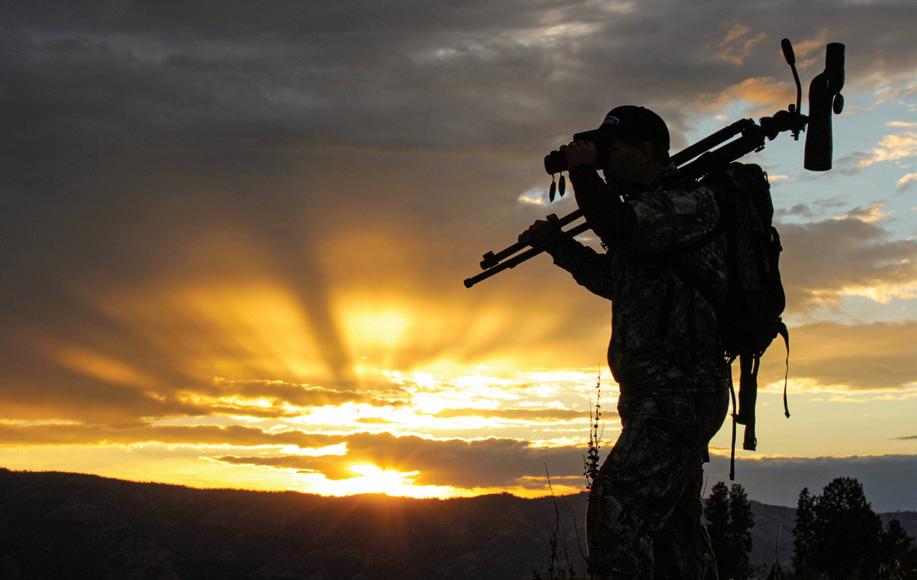
If you want to take your deer hunting success to the next level, summer scouting is one of the best ways to do it.
40 American Shooting Journal // June 2024
Trail cameras are a great way to scout in the summer – and the more, the better, as they’re your eyes in the woods.

ROAD HUNTER
learning what you can about the land, not necessarily looking for deer. Look for old rubs that reveal buck movement in the area during the rut, along with worn trails and does. I’ve filled a lot of deer tags over the decades thanks to does I found while scouting in the summer. A lot of homebody does are visited by migratory bucks, so don’t overlook the value of finding does.
SCOUTING
UNFAMILIAR LAND helps you learn it, but sometimes you show up to hunt familiar places and are caught by surprise. Recently, I encountered a drastic change in vegetation due to extreme summer heat and drought. Rather than massive stands of thriving blackberries – the deer love feeding on the soft vines in late summer and early fall – the ground was overrun with tall grass and noxious weeds. Though the new vegetation was good for bedding cover, it choked out the food. With so little food and no water in the little creek at the bottom of the draw, the deer left. True, I killed a buck that
season, but it was also 3 miles away from where I normally hunted.
Clearcut logging has also surprised me more than once when I’ve rolled into familiar hunting grounds and found the stands of timber gone. A change in such landscapes not only forces deer to relocate their bedding areas, but it can also impact where they feed, thus what trails they use that connect the new bedding areas to feeding zones. It can take some time, even years, to learn where deer go during such a disruption. Mind you, it’s not a bad thing. I’m all for logging because it creates the best deer and elk habitat where I hunt, but learning new land and finding deer amid such changes can be challenging.
A couple winters ago, one of my hunting areas was obliterated by an ice storm. So many trees and big branches fell that it impeded deer travel routes. In fact, it shut down deer travel to the point that they had to relocate to another drainage.
Sometimes natural disasters like
snow and ice storms, even high winds or tornados, can influence where deer live and how they move. It’s no secret that many old whitetail and blacktail bucks live in a very small area, and if that habitat’s devastated by sudden environmental changes, the deer will move, sometimes miles.
Wildfires have greatly changed the face of the land in recent years. Today, large-scale wildfires are commonplace, and I’m learning a lot about deer movement based on burns, the intensity of burns, and where deer are moving in response to them. But most importantly, I’m understanding why deer are choosing to live where they do in their respective habitats, and it’s helping me find more bucks.
In your summer scouting efforts, be sure to track wildfires if looking to head on a hunt out West. Big fires are easily tracked on the internet, as well as by making calls to regional forestry and wildlife offices. If planning on hunting an area that’s near a wildfire – or in a region where wildfires have

42 American Shooting Journal // June 2024
Haugen with a double-drop-tine mule deer that was caught on trail camera – in velvet – several times in the summer, and which he found on opening day of Wyoming’s general rifle season.
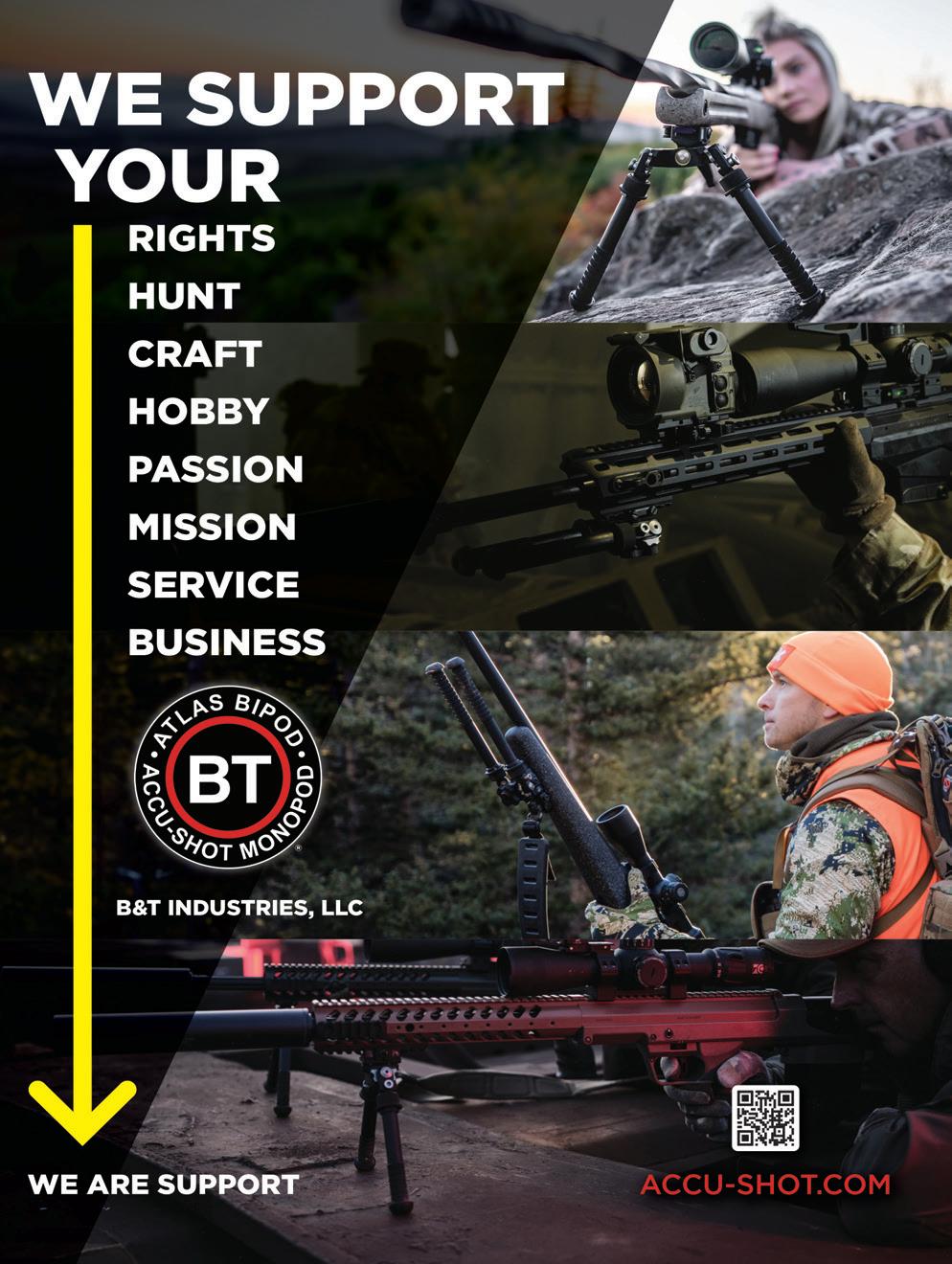
ROAD HUNTER
occurred – be prepared with a backup plan. Every fall in recent years, areas have been closed right before – and even during – hunting season. Having another place to hunt is wise. Due to so much land being shut down by wildfires, more hunters are being forced to hunt in closer proximity to one another. Hunting pressure will impact buck movement. Most bucks will go nocturnal with the onset of human intrusion, often in a matter of hours, and killing such bucks becomes nearly impossible.
THE NUMBER OF bucks that I’ve found when scouting in the summer, and then actually killed, is surprisingly low. That’s because I’m mostly hunting blacktails in thick cover, Western whitetails in big country and mule deer that migrate. Though I may not find a target buck, I’ve still filled a lot of tags in the same areas where I’ve seen big bucks when scouting in the summer.
This is because I’m hunting where big bucks want to be.
Two things I’ve learned over the years when targeting big bucks. One, a mature buck is never anywhere by mistake – except during the rut, when they seem to lose all common sense. And two, when a big buck is taken out of an area, another mature buck will move in. When you see this scenario unfold, take time to closely study the area to see what it is that’s attracting mature bucks. It’s likely a combination of prime feed, cover, multiple escape routes from bedding areas, multiple trails connecting bedding and feeding areas, and does.
If you kill a big buck you’ve never before seen, figure out what brought it there. It could be feed, cover, predators, hunting pressure – even a severe storm could have pushed it. At the very least, plan on hunting that same spot at the same time the next season, for if all factors remain constant, another big
buck will be there. Maybe you’ll even find it when scouting in the summer.
One July, a buddy from Wyoming called, excited about a double-droptine mule deer that had just run in front of his truck in the middle of the night. I’d drawn a tag for the area and planned to hunt with him. He set out trail cameras and caught the buck on film many times, always at night. Then in September, it disappeared for over a month. We eventually found the buck and I shot it on opening day, less than a mile from where it hung out all summer.
If you want to take your deer hunting to the next level, this is the place to start. Big deer are smart, and they’re most visible in summer, which means now is the time to find them.
Editor’s note: For signed copies of Scott Haugen’s bestselling book, Trophy Blacktails: The Science of the Hunt, visit scotthaugen.com. Follow Scott on Instagram and Facebook.
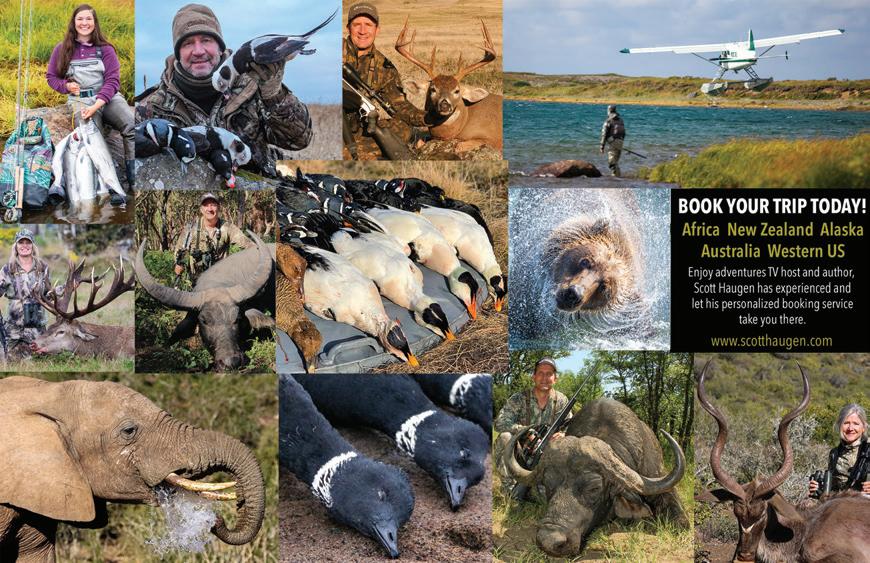
44 American Shooting Journal // June 2024


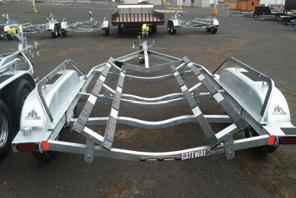
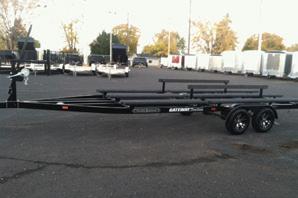

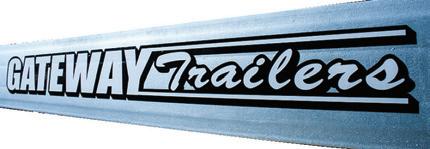
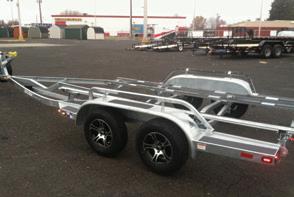

Reliable Quality Service & Craftsmanship For Over 50 Years! Custom Boat Trailers 343 Thain Rd., Lewiston, Idaho www.gateway-materials.com 208-743-0720 • NMMA Certified • All Steel Weld Frame, Fenders & Bunks • 2 YEAR WARRANTY


46 American Shooting Journal // June 2024
Author Fred Mastison was excited to hear that Marlin had released a longtime favorite in a new caliber. He was able to enjoy the 1894 lever-action rifle chambered in .44 Remington Magnum.
gun review
MARLIN 1894 .44 REM. MAG.
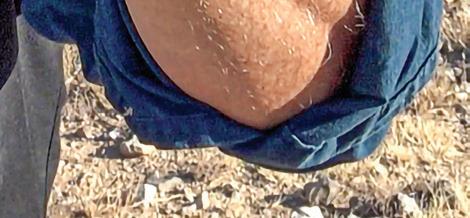
Famed lever-action rides again, proves a joy to shoot.
The name Marlin has been synonymous with quality rifles for over 145 years. Even with a small corporate hiccup in the mix, Marlin has managed to return to the market once again under the Ruger flag and rise back to the top. While countless young shooters fell in love with shooting their rimfire guns, the lever gun is where the real Marlin magic happens. That is why I was excited to hear that they were releasing a longtime favorite in a new caliber. Today we get to enjoy the 1894 lever-action rifle chambered in .44 Remington Magnum.

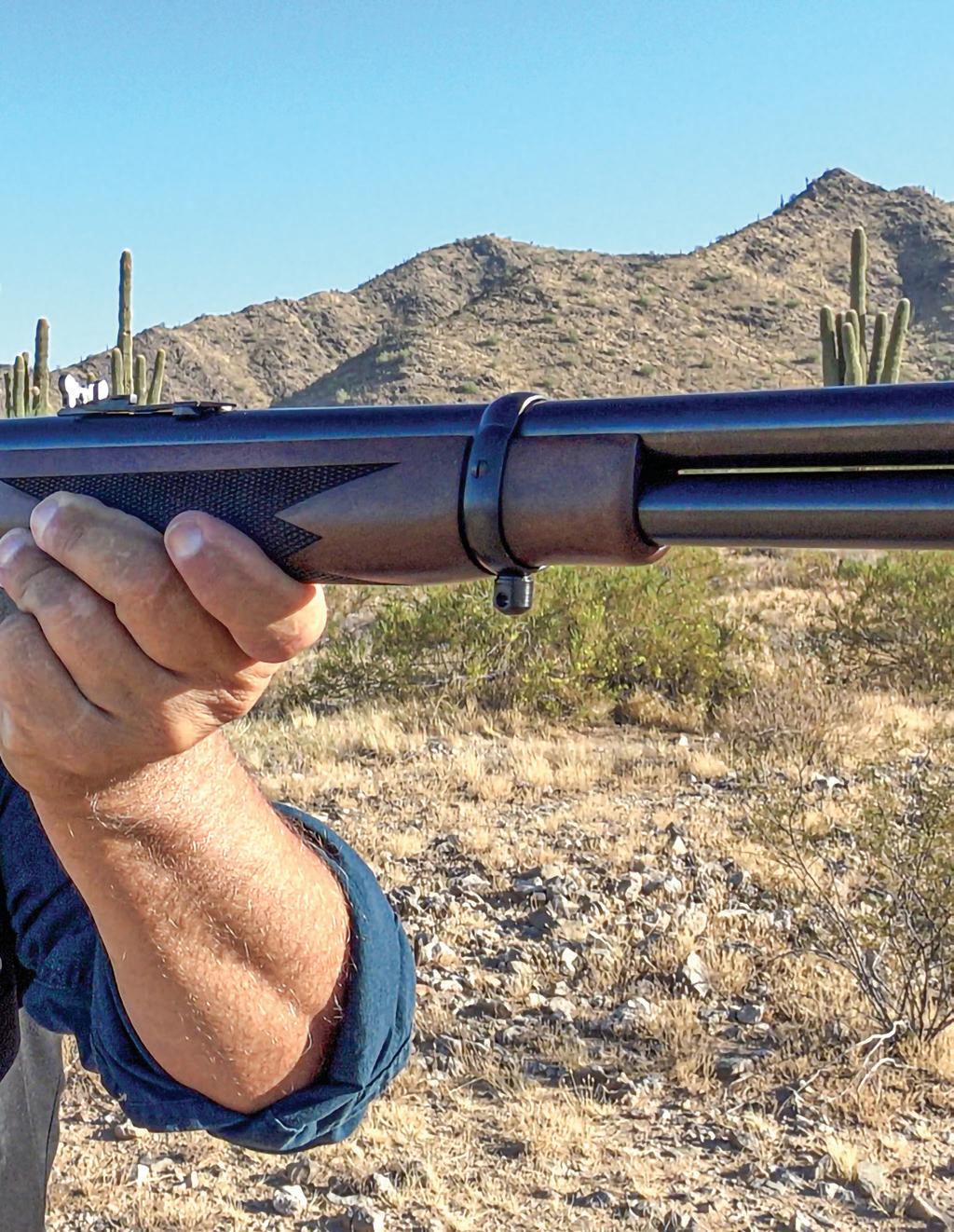
Like so many classic guns, the history begins with the name. Since its launch in 1894, shooters have enjoyed the rifle in a variety of different configurations including stainless steel and with 16- and even 24-inch barrels. We have seen it chambered in a dozen different cartridges over the years. This newest version is the most traditional version of the 1894, chambered in .44
americanshootingjournal.com 47
STORY AND PHOTOS BY FRED MASTISON

Rem. Mag. – it is also capable of running the softer-shooting .44 Special – and outfitted with a 20-inch round barrel, straight-grip stock and semi-buckhorn sight. The receiver, lever and trigger guard plate are CNC-machined from alloy steel forgings.
Like so many other Marlin rifles, it is as beautiful as it is functional. It comes with an American black walnut stock with a 13.63-inch length of pull. I found this to be very comfortable and believe its relatively short LOP will
allow it to fit a wide variety of shooters. The stock is finished at the butt with a thin recoil pad that I believe is more of an aesthetic than anything else. While the gun is chambered in .44 Rem. Mag., it also weighs north of 6 pounds, which helps soak up any recoil. The 20.25inch barrel is made from alloy steel and is cold hammer-forged, which results in ultra-precise rifling that provides exceptional accuracy and longevity. It has the obvious tubular magazine and will accept 10 rounds (11 of .44 Special).
With an overall length of only 38 inches, it is very easy to wield and run.
WHILE THE GUN is beautiful, it is not designed to just occupy space in the safe. With that in mind, I loaded up, grabbed my cowboy hat and headed to the range. My first impression of the gun was that it was solid. The wood-to-metal fit was excellent and the checkering on the stock felt as good in my hands as it looked. I have always been a fan of walnut stocks, and the
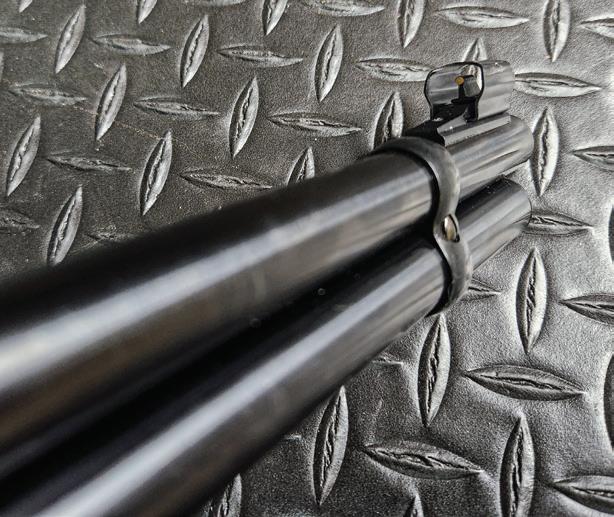

48 American Shooting Journal // June 2024
gun review
The Marlin 1894 is returning to the market once again under the Ruger flag.
The 1894 has a 20.25-inch cold hammer-forged, alloy steel barrel and adjustable semi-buckhorn sights.
Unlike top-ejecting 1894s of old, this one features side ejection, plus a solid-top receiver, bonuses for hunters looking to mount an optic.

1894 had select walnut on this rifle. The bluing was flawless and completely even. The adjustable semi-buckhorn sights proved to be easy to acquire and gave me decent accuracy. While most shooters have become reliant on optics on their rifles, I found these sights to perform well. If I were to change anything, I would add a higher-visibility front sight for quicker acquisition.
Now, in all honesty, if I were taking this into the woods to harvest deer, I would put glass on it, simply because

my eyes aren’t 20 years old anymore. Marlin has anticipated the desire to run even a classic gun with glass and made some modifications. The 1894 has a solid-top receiver and side ejection, unlike the top-ejecting 1894s of old. This provides a flat mounting point on top of the receiver for optic mounts, and the Marlin 1894 comes drilled and tapped for that purpose. The hammer is also rigged for use with optics, as it comes with a side extension installed. I took a minute on the bench to see
if any adjustment was needed on the sights, but found it would work well out of the box. It was really at this point that I began to notice a bit of inconsistency in the trigger. On my trigger gauge, I found it to break anywhere between 4.25 and 5.5 pounds. While not a dealbreaker, it did catch my attention. I won’t pretend to be a trigger snob, but I am not sure most shooters would notice this. Recoil-wise, it was soft shooting. While that seems like an overused cliché, it is the truth with this gun. The

americanshootingjournal.com 49
The tubular magazine will accept 10 rounds of .44 Rem. Mag. or 11 of .44 Special.
gun review
1894 is not a super beefy gun, but it is not a featherweight. That sufficient mass of the steel and wood proved effective at helping to manage the recoil of the .44 Rem. Mag. round.
Control-wise, the rifle has a metal action lever, hammer and cross-bolt safety. The cross-bolt safety is colorcoded and also acts as a hammer block when engaged, preventing the hammer from being able to touch the firing pin. As an added safety feature, there is also a trigger-lock safety that only disengages when the action lever, and thus the action, is fully closed. The hammer itself has three positions, including a half-cock position where the cross-bolt safety can also be engaged. I found loading to be easy. The side loading gate is very easy to depress and burr-free to load the rounds. The action on the 1894 was a pleasure to run. There was no extra play, yet it was not overly

tight. Ejection of spent brass was no joke and built a sense of confidence that I would not have to wrestle with brass barely clearing the chamber.
I did some bench shooting with the gun, but the majority of my range time was spent firing off-hand or with shooting sticks. I did so because that’s the reality of how we would be using this lever-action in the field. Yes, it could be nice to have a lightweight tripod with a clamping head to shoot off, but they are a luxury. I found the 1894 to be exceptionally easy to run off-hand.
WHILE I WAS excited to get some range time with this classic lever gun, I had some hesitation. History has shown me that many .44 Rem. Mag. lever guns can get an attitude about what you feed them. After all, the round was originally designed to be run in a revolver, so I get it. I ran the Hornady
200-grain Monoflex in the 1894 and did not flinch all day long. Kudos to the design team for understanding this issue and solving it. Speaking of the actual round, I found it very satisfying to shoot on steel. There was no question of whether the 200-grain bullet had made solid contact with the steel, as it flew at over 1,300 feet per second to its destination. The loud “clang” was a reminder that while it is a round initially designed for revolvers, it is an exceptional round in a rifle.
In his classic handbook, Cartridges of the World, Frank C. Barnes describes the .44 Rem. Mag. as “one of the few commercial handgun cartridges that can be considered fully adequate for big game hunting.” He declares the “big 44” as capable of bringing down deer, black bears, elk, moose and even big Alaskan brown bears. Put that round in a rifle with a 20-plus-inch barrel and we
50 American Shooting Journal // June 2024
“The action on the 1894 was a pleasure to run. There was no extra play, yet it was not overly tight,” reports Mastison.
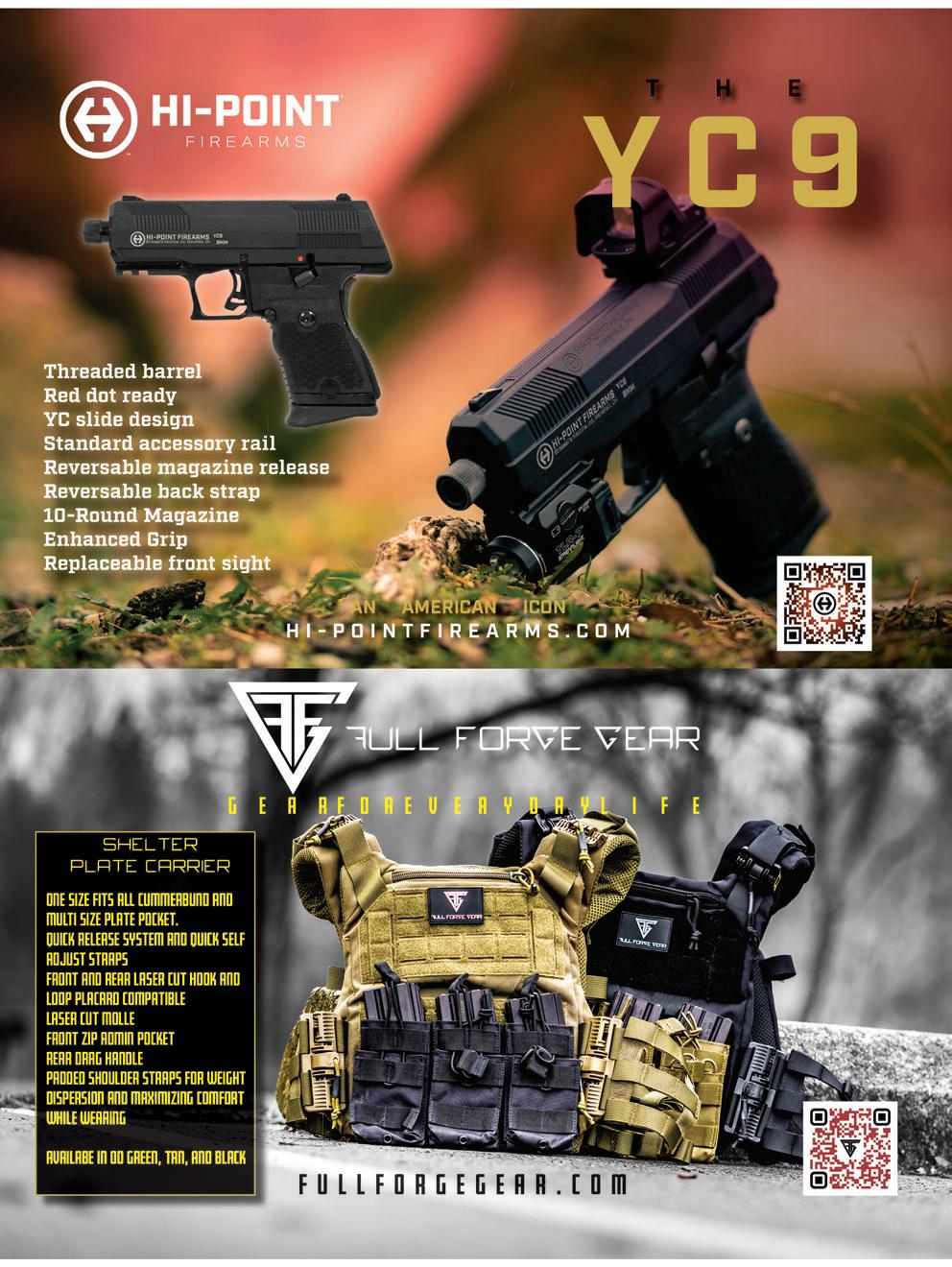
gun review
get even better muzzle velocity. That makes the 1894 a fantastic option across the board. I specifically chose this round because it is something I would hunt with. While some lighter-shooting .44 Special loads would have been a bit more recreational, I wanted to test real application performance.
Without question, I would take this gun not only onto the plains of Kansas for whitetail, but pretty much
MARLIN 1894 SPECS
Caliber: .44 Rem. Mag./.44 Special; Capacity: 10/11; Stock: American black walnut; Material: alloy steel; Finish: satin blued; Sights: front: brass bead with hood; rear: semi-buckhorn; Weight: 6.4 pounds; Overall length: 37.75 inches; Barrel length: 20.25 inches; Twist: 1:20; MSRP: $1,239.
anywhere I was looking to take serious game. It would be a great companion in the backcountry and just as at home in a leather scabbard on a saddle. My personal plan is to take this rifle to the wilds of Texas to help thin out the wild pig population. While not as glamorous as a deer or elk hunt, it is a great way to test a rifle’s performance on a budget.
Many people held their breath when Marlin had its challenges all those years ago. These same people cheered, however, when we learned Marlin would live again under Ruger. The Marlin name has risen to its original glory and the newest 1894 is an example of that.
“Our focus continues to be on quality,” said Chris Killoy, Ruger president and CEO. “We remain committed to making firearms worthy of John Marlin’s legacy. The fit and finish of this rifle is reminiscent of what was produced by Marlin craftsmen in New Haven, Connecticut, many decades ago.”
The new Marlin 1894 is everything
we expect from Marlin, as well as Ruger. While not written in stone, I am pretty sure that other models are in the works for more pistol-caliber rounds. If you are looking for a solid lever gun that can be used across a large spectrum, I would encourage you to get a good look at the new 1894. ★
Editor’s note: Author Fred Mastison has written over 2,000 print articles in dozens of magazines. He is also the founder of Force Options USA, a training company for various uses of force, from hand-to-hand training to all levels of firearms training. Mastison is also one of the country’s top professional firearms and combative instructors and a certified dignitary protection specialist. He has taught for over 30 years and has over 16 law enforcement post-instructor certifications. In addition, he’s taught martial arts for 28 years and holds multiple black belts, including a seventhdegree black belt in aiki jujitsu.
AR Rifle Available In 45 ACP and 10mm




52 American Shooting Journal // June 2024
EXODUS AR45TC
Bishop

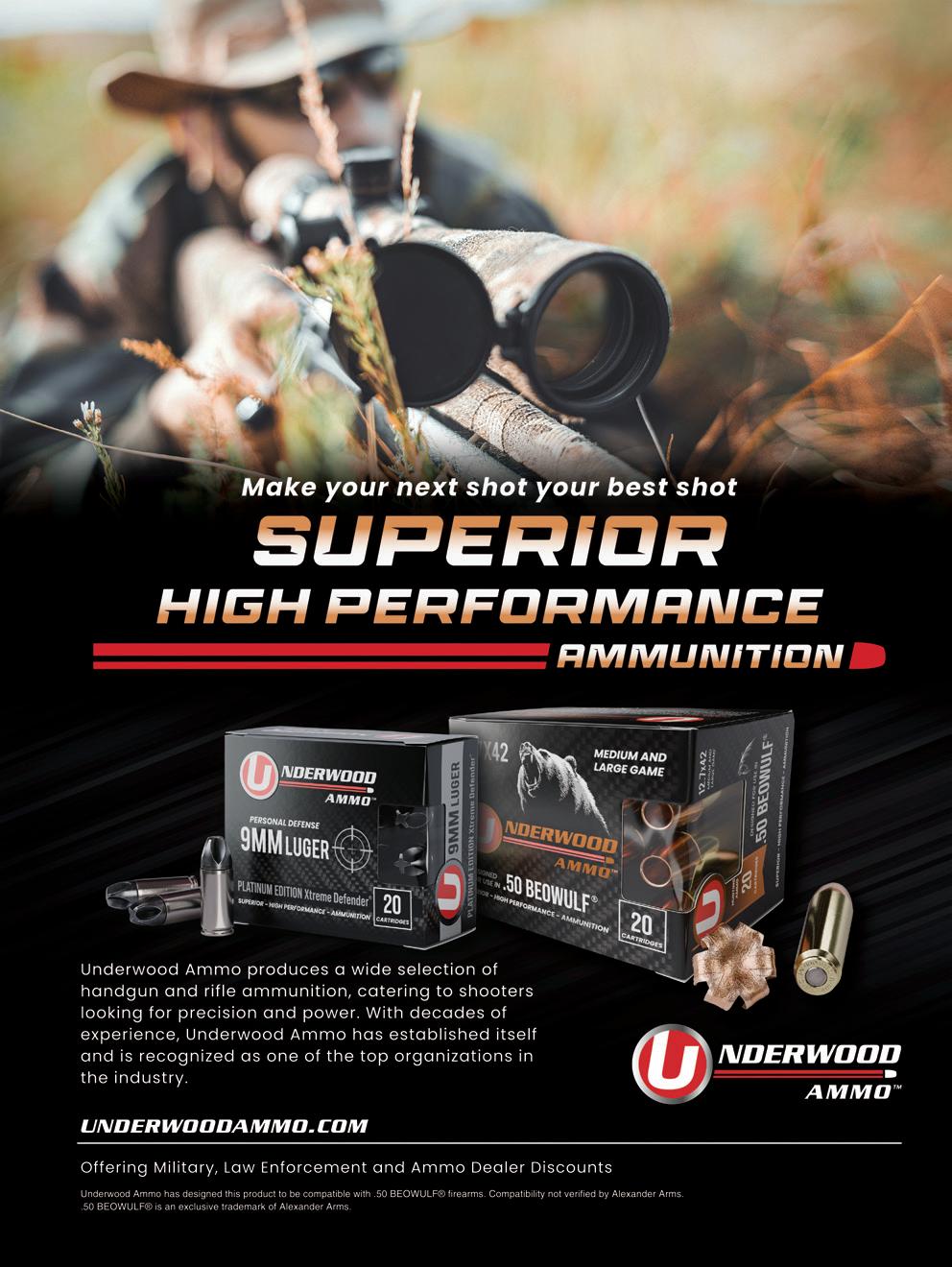


THE PROJECTILES OF THE .45-70 GOVERNMENT
From ancient to modern, the cartridge has seen it all over the past 150-plus years.
STORY BY PHIL MASSARO • PHOTOS BY MASSARO MEDIA GROUP
Sitting in a favorite spot in the northern Catskill Mountains on a frosty November morning, I was watching the junction of old logging roads, where the new brush met the overmature evergreen forest. With the slight breeze blowing in my face, I heard the all-too-familiar

cadence of a deer walking through the frozen leaves and needles from my right and slightly behind me. Staying perfectly still, I caught the outline of a buck from my periphery; he was walking, nose down, on the trail of something that interested him greatly. I knew the deer run he was on, and a hot doe must’ve come through before light because he cared about nothing else but sniffing that track.
Disengaging the safety catch
on the Heym Model 26B, I waited until the buck’s midsection was clear of the hemlock branches. The Leupold’s crosshair settled just behind his shoulder, and the Federal HammerDown .45-70 bullet put him down almost immediately.
CONSIDERING THAT THE .45-70 Government has a long and storied history – it has been with us for over 150 years – I feel its story is one that
BULLET BULLETIN americanshootingjournal.com 55 BROUGHT TO YOU BY
Despite having turned 150 years old, the .45-70 Government remains a viable and effective hunting cartridge. (JD FIELDING PHOTOGRAPHY)

parallels the history of projectile development. The year 1873 was pivotal in firearms development, as it saw the release of not only the .45-70 Government, but also the .45 Colt and the .44-40 Winchester Center Fire. Sam Colt’s wheelgun made the .45 Colt
famous, and between the Winchester 1873 and the many revolvers, the .44-40 was “America’s 44” and has a nostalgic following to this day.
But the big, rimmed .45-70 Government would become the most famous of the lot, serving the US Army
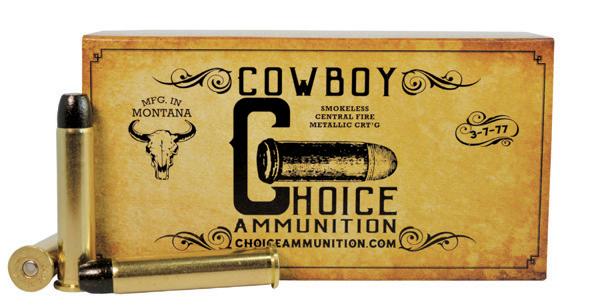
as a replacement for the post-Civil War .50-70 cartridge. Using the late 19th century nomenclature, where the caliber/powder charge weight/bullet weight (and sometimes case length) were used to identify a cartridge, our 45-70 Government was also known as the .45-70-405, the .45 Springfield, and the .45-2 1/10-inch. The 405-grain projectile left the muzzle at 1,350 feet per second, with a carbine variant running 200 fps slower.
The initial projectile used by the cartridge was the simple castlead roundnose bullet. In that era of westward expansion, a rifle was often shipped with a set of reloading dies and a bullet mold, so users could supply themselves with ammunition, so long as they had the raw materials. As black powder was the propellant of the day, the velocities generated by the .45-70 posed no issue to the simple
BULLET BULLETIN 56 American Shooting Journal // June 2024
For older rifles and for those who want the original .45-70 experience, Choice Ammunition’s Cowboy loads are a good option, as they use a traditional lead bullet at a sensible velocity. (CHOICE AMMUNITION)
The classic Winchester Model 1886 (shown here in the Browning variant from 1986) houses the .45-70 Government perfectly.


feet
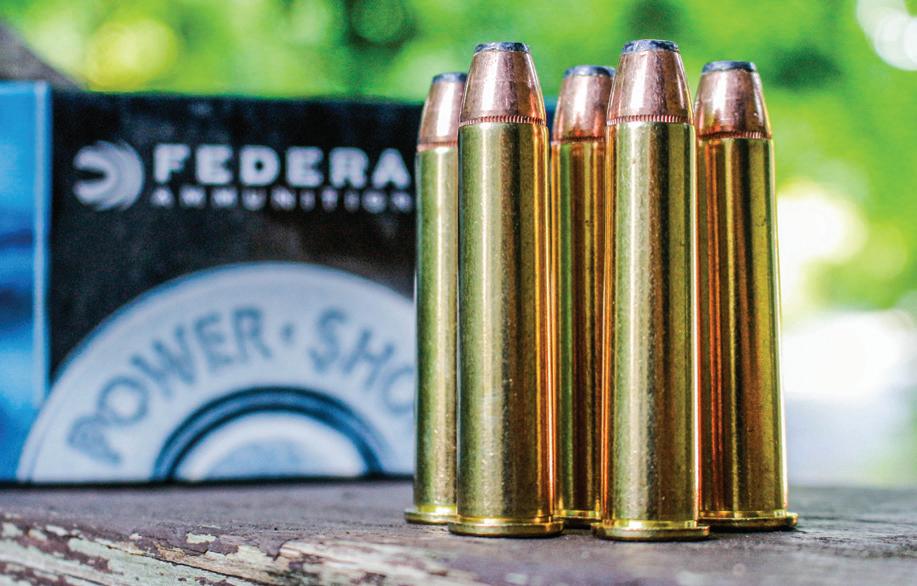
a 300-grain jacketed
relatively
lead projectile.
Where the US Army issued the .4570 in the 1873 Trapdoor Springfield rifle – as well as in the Gatling Gun – the civilian world saw the cartridge chambered for the 1885 Winchester
High Wall, and the 1881 Marlin and 1886 Winchester lever guns. Being a military cartridge, the .45-70 garnered popularity quickly, and the fact that it had the capability to take any and all game animals on the North American
continent aided that popularity, especially among the explorers, prospectors and market hunters.
The .45-70 Government survived the late 19th century transition from black powder to smokeless powder, as

BULLET BULLETIN 58 American Shooting Journal // June 2024
Three modern loads for the .45-70 Government (left to right): Federal’s HammerDown, Hornady’s LeveRevolution and Federal’s Fusion. All improve field performance, either in trajectory or structural integrity.
Federal’s “Blue Box” ammo – which drives
hollowpoint to 1,850
per second – is a
low-pressure load that will handle deer and black bear, as well as larger species.


Swift
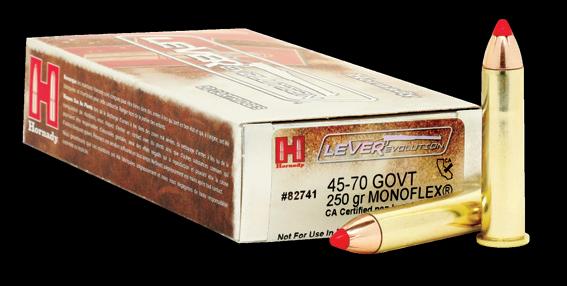
Hornady’s LeveRevolution line uses a pliable polymer tip to make pointed bullets safe in the tubular magazines common to lever guns. Shown here is the 250-grain lead-free MonoFlex load. (HORNADY)
Housed in a light over/under double rifle like the Heym Model 26B, the .45-70 is a wonderful cartridge for deer and bear in the timber. The Federal loads gave more than acceptable accuracy.
well as the transition from lead projectiles to jacketed bullets. Winchester, Western, Peters and Remington all offered both lead and jacketed bullets in their ammunition lines. But that wasn’t to last forever. In the mid-20th century, after the conclusion of World War II and into the 1960s, the popularity of .45-70 rifles dwindled to the point that no new production rifles were available in the venerated cartridge; this actually had a role in the development of the .444 Marlin in 1964, to fill the void left by the .45-70 Ironically, that Marlin rifle/cartridge combination helped fuel a revival in bigbore lever guns, and that – combined with some new developments like the Ruger No. 1 and No. 3 single-shot rifles – saw the return of the .45-70 Government.
IN THE LATE 20th and early 21st centuries, the .45-70 took on an entirely new guise. Remington released a 300-grain jacketed hollowpoint load at just above 1,800 fps (my dad used that load to great effect in his 1886 Browning Centennial rifle) and other companies began to offer bullet weights heavier than the traditional 405 grains. And the new crop of firearms –including Marlin’s 1895, reintroductions of the 1886 Winchester, Ruger’s single-shot


60 American Shooting Journal // June 2024
BULLET BULLETIN
The
A-Frame is undoubtedly a premium softpoint capable of taking nearly all species commonly hunted. Author Phil Massaro handloaded 400-grain .458-inchdiameter A-Frames in the .45-70 for his father’s bison hunt in South Dakota.





Trust HAMMER BULLETS for superior accuracy and better big game terminal performance. polymer tipped hunting bullets 406-261-5102 • 406-261-0010 hammerbullets.com PURE COPPER, LEAD-FREE • PATENTED DESIGN SATISFACTION GUARANTEED OR YOUR MONEY BACK THE NEW HAMMER HHT SIMPLY BETTER BULLETS
BULLET BULLETIN
designs and double rifles produced in the latter half of the 20th century – gave rise to a whole new allowable pressure level for the .45-70 Government. This is, in my opinion, where things get very interesting.
Undoubtedly, the introduction of Hornady’s LeveRevolution ammunition has been an enormous boon to the lever-action crowd, and the .45-70 benefited directly. The vast majority of 45-70 Government ammunition uses roundnose or flatnose bullets, so that when the cartridges are lined up noseto-tail in a tubular magazine – such as that on a Winchester 1886 or a Marlin 1895 – the risk of a magazine detonation is eliminated. If you used a pointed – or spitzer – bullet, the possibility of detonation in a tubular magazine is real. So Hornady developed a pliable material that could be used at the point of a spitzer bullet in order to obtain the higher ballistic coefficient and correlative improvement of downrange performance. The LeveRevolution series and the MonoFlex and FTX bullets flatten the .45-70’s performance, extending the effective range of a cartridge long associated with a rainbow trajectory. Using the 250-grain LeveRevolution load, you can zero your .45-70 at 150 yards, with a rise of only 2.6 inches at 100 yards, while striking 6 8 inches low at 200 yards. Retaining just over 900 foot-pounds of energy, this


is an effective deer and black bear load. Federal Premium’s HammerDown series was released as an ammunition line optimized for lever-action rifles; the edge of the case rims have been chamfered for smoother feeding from the tubular magazines and for equally smooth ejection. These come in nickel-plated cases, using bondedcore jacketed bullets for a balance of expansion and deep penetration, and with a 300-grain bullet at 1,850 fps, I find it a great choice for the .4570. It has proven to be wonderfully accurate in Dad’s Browning 1886, as well as that portable little Heym 26B
62 American Shooting Journal // June 2024
While traditionally associated with leveraction rifles, the rimmed cartridge is right at home on single-shot and double rifles.
Massaro used the highly portable Heym Model 26B in .45-70 to take this Catskill Mountains whitetail buck; the smile is absolutely genuine.
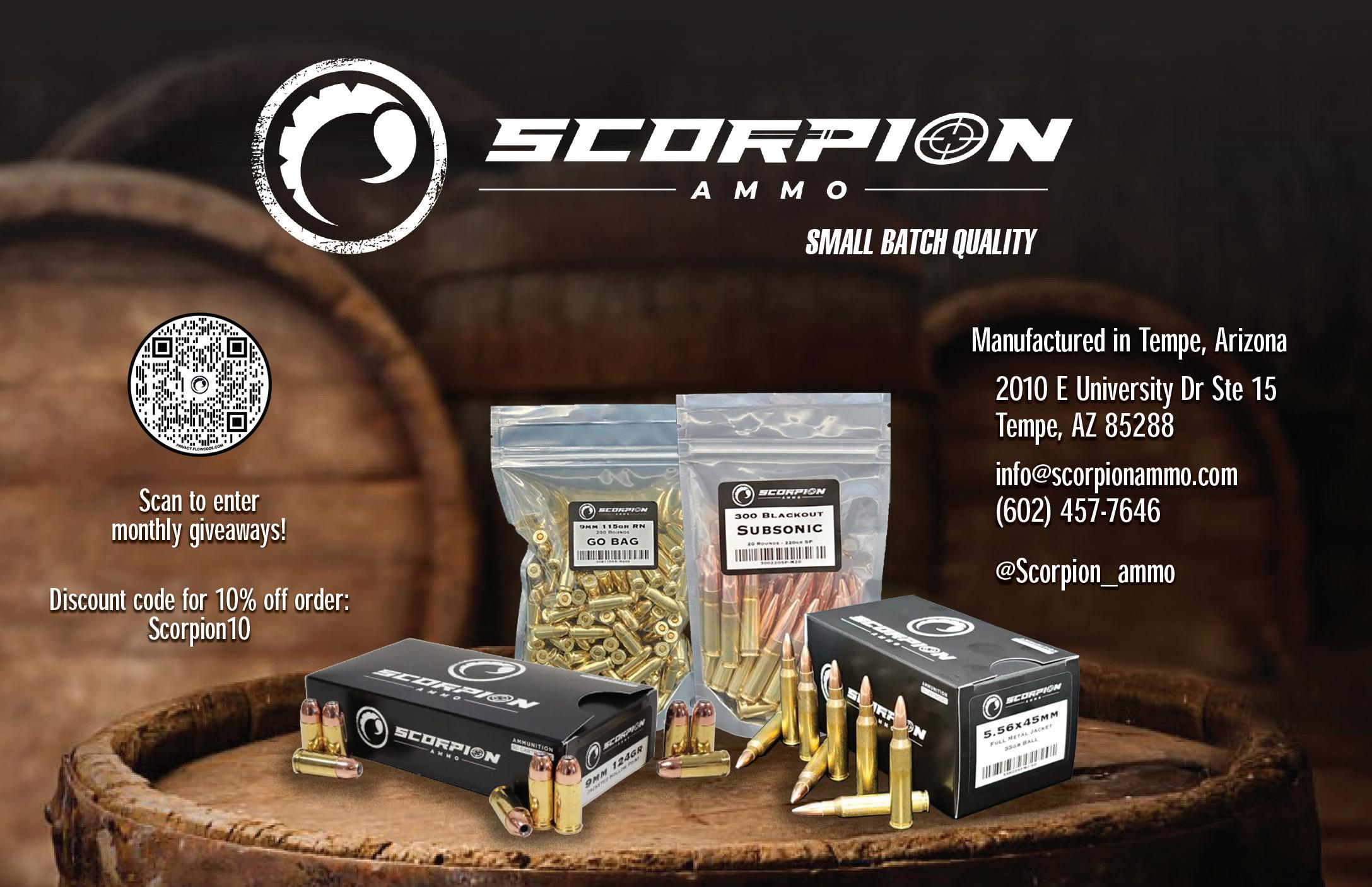


• UNIBODY CONSTRUCTION Fort Knox has folded the edge around the door, making it virtually impossible to pry.
• HEAVY DUTY CORNER BOLTS
Securing the corners of the door to prevent attacks on Guardian,Titan, and Legend vaults.
• DRILL STOP HARD PLATE
Bearings are recessed into the hard plate and will cause drill bits to slip and break.
• 5 TO 1 GEAR DRIVE SYSTEM
Our patented rack & pinion bank locking drive is the most reliable locking system available.
• SUPERIOR FIRE PROTECTION
Fort Knox Vaults will protect your possessions with a Reinforced Fire Liner option.
• POWER SUPPLY INSIDE
All Fort Knox Defender Vaults & above come standard with an internal power supply.
• QUADRAFOLD DOOR FRAME
The Quadrafold Door Frame has been designed to be the strongest in the industry.
• MANIPULATION PROOF LOCK
Our UL Listed Group II mechanical lock resists manipulation & “safe cracking” attempts.

americanshootingjournal.com 63 AZSAFES.COM 480-497-3882
AMERICAN MADE FROM AMERICAN STEEL PROTECT WHAT’S IMPORTANT TODAY THE MOST SECURE AND FIREPROOF VAULTS
BULLET BULLETIN
double rifle I’d spent a season with. It handled that buck in the Catskills very neatly, with surprisingly little meat damage. Designed in conjunction with Henry Rifles, HammerDown is a very dependable line.
Years ago, as we were preparing for a bison hunt in South Dakota – on the Triple U Ranch, where some of Dances with Wolves was filmed – my
dad came across Buffalo Bore’s Lever Gun ammunition, driving a 400-grain bullet at 2,000 fps. This is assuredly for the strongest actions like the 1886, 1895, Ruger No. 1 and similar rifles, and the recoil level is considerably higher than the standard “1800s” load. Shoot that Buffalo Bore stuff in a lever gun with a steel crescent buttplate and it’ll get your attention quickly. Those


Federal uses bonded-core projectiles and nickel-plated cases with chamfered edges in their HammerDown line; the ammunition line is optimized for lever-action rifles.
jacketed bullets are stiff enough for large game, and that speedy load gave impressive accuracy. If you want a bit more, Buffalo Bore offers a 500-grain FMJ load at 1,625 fps, generating almost 3,000 foot-pounds of energy, for the modern, strong actions.
HAND-LOADING
THE .45-70 is a pretty straightforward affair, no different than any rimmed case that requires a heavy roll crimp. Powders like IMR 3031, IMR 4198, H322 and Accurate’s 5744 all have given great results in the past, and there is a wide selection of excellent projectiles for all sorts of applications. Surely the reloader can cast their own lead projectiles with a good mold, but there are also the premium bullets that can really extend the capabilities of the cartridge. For that bison hunt I mentioned, we finally decided on handloaded 400-grain Swift A-Frames,
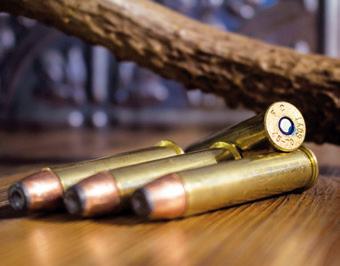
64 American Shooting Journal // June 2024
The .45-70 Government remains an American icon, having served our military and civilians alike.



americanshootingjournal.com 65
BULLET BULLETIN

Federal’s Fusion line uses a bonded-core bullet to prevent premature bullet breakup, and has proven to be a great choice for the hunting fields.
and Dad sorted out a good bull with one shot. Northern Precision Bullets offers a good flatnose bonded-core 400-grain bullet they call their Guide Bullet, designed for use in conjunction with the Marlin Guide Gun, which shot just fine from the Browning ’86 over a load of H322. Nosler lists a 300-grain Partition for the .45-70, and there are plenty of bullets for the .458 Winchester Magnum
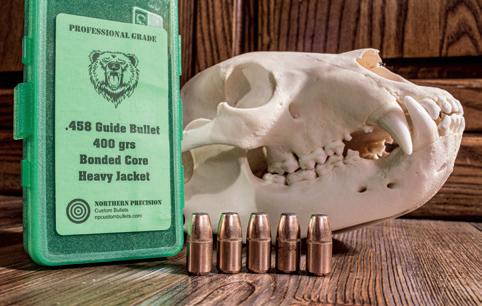
Northern Precision’s Guide Bullet is a bonded-core flatpoint bullet with a thick copper jacket, designed to handle high impact velocities. Available in component form only, they are perfect for handloading the .45-70 Government. The author’s test loads have shown good results at the range.
and .458 Lott that can be adapted for use in the .45-70 Government. Just make sure you use the proper load data for your particular rifle; I highly advise against pushing the pressure envelope, as you can get hurt.
With a good number of both repeating and single-shot rifles on the market, the .45-70 shows no signs of slowing down, despite having recently
celebrated its 150th birthday. Is our American icon going away anytime soon? I highly doubt it, especially with the drastic improvements in projectile technology. Just be aware that there are, in all sincerity, two different 4570s out there, and you as the shooter need to know the difference. When in doubt, consult the manufacturer, but always err on the side of caution.

66 American Shooting Journal // June 2024
Buffalo Bore offers a 400-grain jacketed flatpoint at 2,000 fps for modern and strong rifle actions – not the old Trapdoor guns – and takes the .45-70 Government to a different performance level.
BRASS MASTER
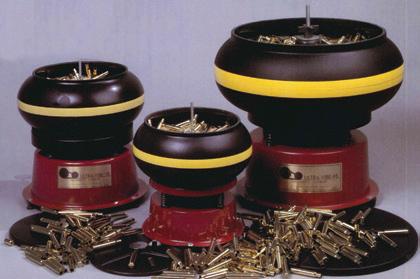
Made of durable steel construction - heavyduty, sealed ball bearing motors - thermally protected - fast, quiet operation - 3/4 to 4 3/4 gallon capacity - industrial and rotary models available. Send for our free brochure!
TRU-SQUARE METAL PRODUCTS, INC.
P.O. Box 585, Auburn, Washington 98071
TEL (253) 833-2310 or Toll Free 1-(800) 225-1017 www.thumlerstumbler.com
t-tumbler@thumlerstumbler.com
“Manufacturers of quality case cleaners, deburring and tumbling equipment since 1959”
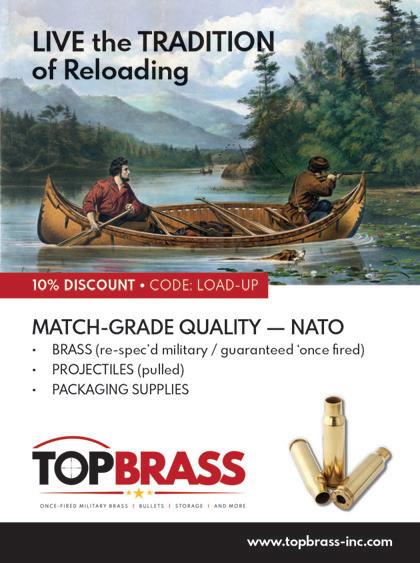

americanshootingjournal.com 67
ULTRA VIBE CASE CLEANERS THUMLER’S TUMBLER

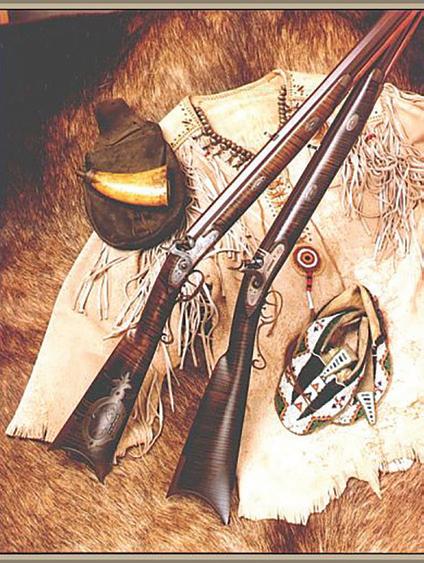

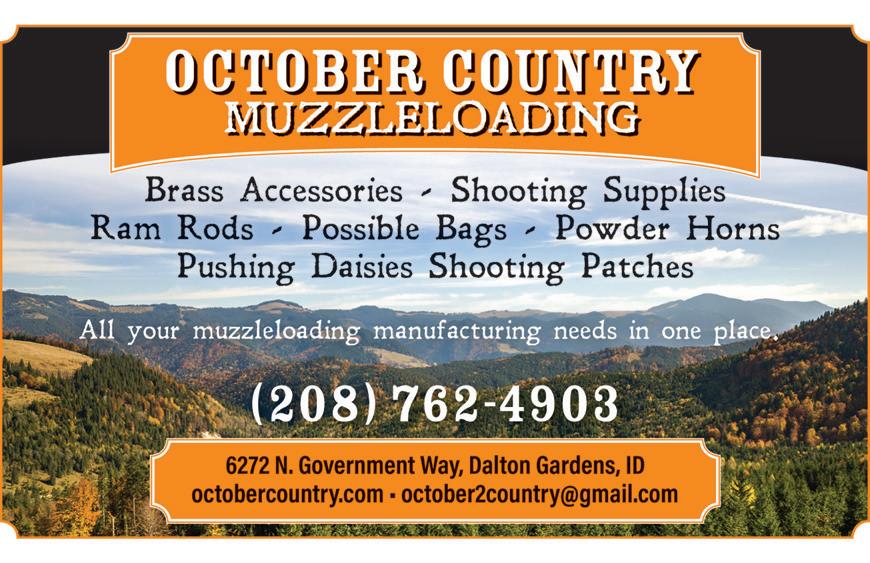
68 American Shooting Journal // June 2024 TheHawkenShop.com Now located in Oak Harbor, WA It’s more than a rifle, it’s history!
BLACK POWDER
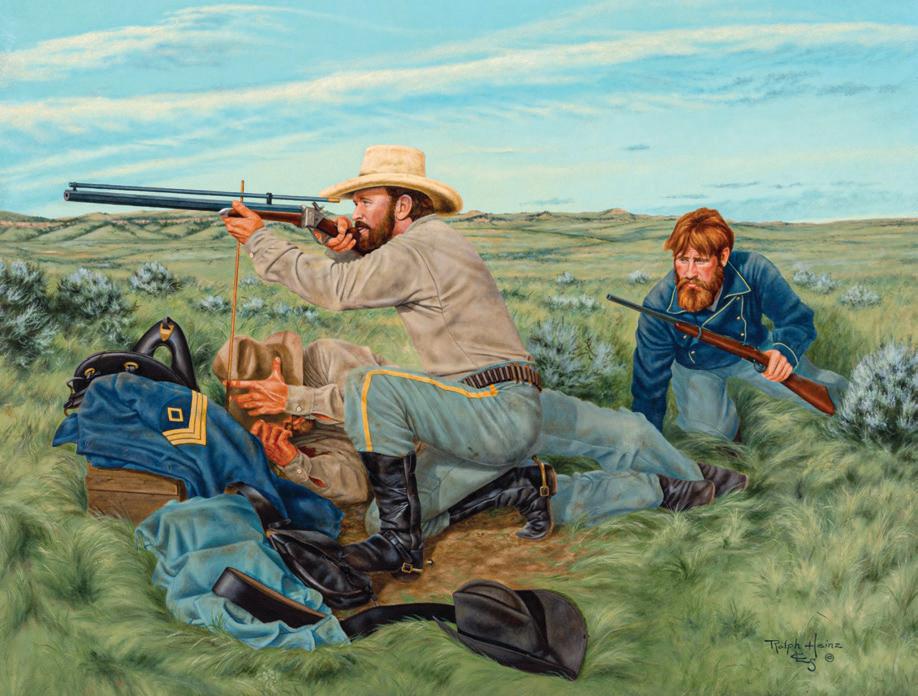
FIRST THOUGHTS ON NEW 1ST SERGEANT
The story about John Ryan, First Sergeant of Company M, 7th US Cavalry, simply can’t be told too often. Company M, commanded by Captain Thomas French, was part of the battalion under Major Marcus Reno at the Battle of the Little Bighorn. In that battle, Ryan distinguished himself
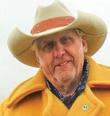
when his company of troopers was under fire from one of the Sioux or Cheyenne warriors who was shooting at them from Sharpshooter Ridge. The Native was using a rifle, presumably captured, that had long-range
capabilities, and the troopers’ .45-70 carbines, using the standard carbine loads with 55 grains of powder, were ineffective at the 400-plus-yard target.
Captain French asked Sergeant Ryan if he could do something about it.
Ryan had a heavy-barreled Sharps in .45-70 with a full-length scope. That was a rifle he “had built” (to use his
americanshootingjournal.com 69
MVA-scoped .45-70 from C. Sharps Arms honors Battle of the
Bighorn sharpshooter.
Little
STORY AND PHOTOS BY MIKE NESBITT
Ralph Heinz’s painting depicting First Sergeant John Ryan at the Battle of the Little Bighorn served as inspiration for a new C. Sharps Arms rifle. (RALPH HEINZ)
BLACK POWDER

own words) in Bismarck, North Dakota, at a cost of $100 shortly before the 7th Cavalry departed Fort Lincoln, heading toward the Little Bighorn. Ryan gave little detail about this gun, but we are blessed by what he did include in his reports about his military career, which ended shortly after the famous battle in 1876. He did mention that he traded his carbine ammunition with members of the infantry who had the .45-70s that used the 70-grain rifle loads.
After Ryan was asked to “do something about it,” he fired a couple of shots in order to find the range. Then,
after adjusting his rifle’s scope for the distance, he fired a few rapid shots into the point where the incoming shots had originated. That ended the sniping being done from Sharpshooter Ridge. One report I read indicated that blood was found in that spot after the battle, which would give evidence that the shooter was hit and wounded, perhaps killed. Ryan did state that when the shooting from Sharpshooter Ridge was stopped, the men in his company gave a roaring cheer. (I think we all would have cheered!)
Shortly after that, the troopers
could see the Natives taking down their tepees while preparing to leave the area. Ryan and French fired a few shots in the direction of the camp with their long-range rifles. French had an 1870 Springfield rifle in .50-70 caliber and more than once he had .45-70 carbines passed to him with cartridge cases jammed in their chambers. French could knock the stuck cases out with his rifle’s ramrod, which, at that time, the .45-70 carbines were not equipped with. Those shots fired by French and Ryan toward the Native camp were the last shots taken at the Little Bighorn battle.
GIVING THAT BACKGROUND about Sergeant Ryan was necessary for this story because C. Sharps Arms is making a rifle honoring Ryan, and the new rifle follows the gun as painted by Ralph Heinz, a notable Western artist. The rifle is a .45-70 with a No. 1¾ Heavy barrel, complete with a Hartford collar and a
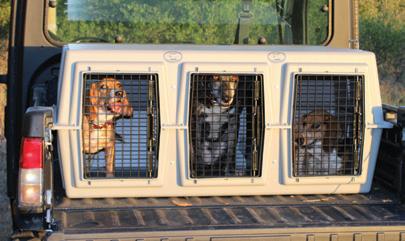

70 American Shooting Journal // June 2024
The first of C. Sharps Arms’ new 1st Sergeant rifles, topped with a Montana Vintage Arms 6x scope.
A close-up shows the special address and serial number of the first new .45-70.
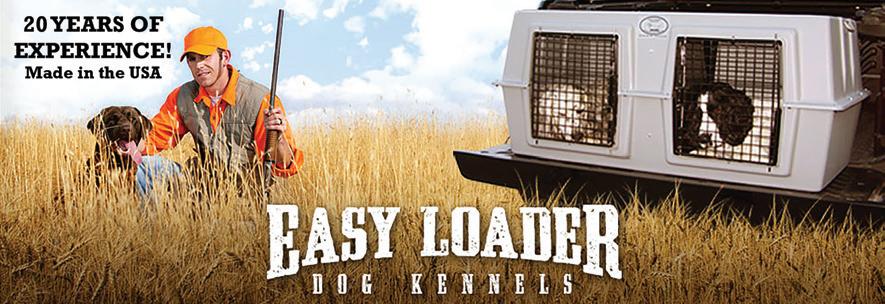
• EZ-XL accommodates 2 dogs over 65 lbs each
• Made from High Density Polyethylene with UV protection
• Easy Loader fits most full size pickups, SUVs & large UTVs

• Deuce fits smaller pickups, SUVs & UTVs
• EZ-XL is for larger breed dogs & full size vehicles
• Vents, cold weather door covers, insulated covers & custom kennel pads available


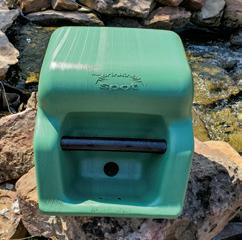

EASY-LOADER Dog Kennels www.easyloaderkennels.com Bartlesville, OK • 800-853-2655
TOUGH • DURABLE • LIGHT Call 800-853-2655 Check out our website for new accessories www.easyloaderkennels.com Easy Lo ader, Deu ce & EZ-XL Models
• Easy Loader & Deuce accommodate 2 dogs up to 65 lbs each
Introducing th e EASY XL. For large breed dogs. 30 Outdoor Gravity-Fed Pet Watering System THE DRINKING SPOT NEW! TRIPLE KENNELS
BLACK POWDER

full-length 6x scope by Montana Vintage Arms. With the scope, the first of the 1st Sergeant rifles (serial number 1SGT-1) weighs 14¼ pounds.
This first rifle was just finished and I’m delighted that I get the chance to try it out at some distant targets later this month at the Matthew Quigley
Buffalo Rifle Match. The targets I expect to shoot at are 400, 530 and 600 yards away from the firing line. And to get a feel for how Ryan did his shooting, I have prepared copies of those old 1876 loads. Both rifle and carbine loads were made with bullets approximating the old 405-grain slugs.
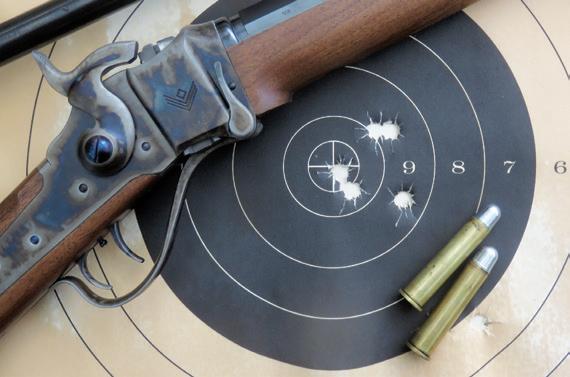
(The 500-grain bullets for the military loads weren’t introduced until 1881.)
For cases, I used new brass from Starline. Those new cases were sized just to be sure of uniformity and then slightly belled at the mouth. Then they were primed using Federal large pistol match primers, hoping those would have closer characteristics of ignition than modern large rifle primers. Primers in the old days simply were not as “hot” as primers today. Powder was added next and I selected Swiss 1½ Fg. Powder for the very early .4570 cartridges was often described as “musket powder” and with that as a guideline, I assume the old powders were not particularly fine in grain size. Bullets, of course, were considered before getting that far with the loads. I used Lyman’s No. 457124 mold, which is a very close copy of the old original bullet. For this set of loads, the bullets were sized to .459-inch diameter and lubricated with BPC Lube from C. Sharps Arms. The early bullets were either pure lead or a very soft lead,
72 American Shooting Journal // June 2024
Limbering up for the long-range Matthew Quigley Buffalo Rifle Match in southeast Montana this month, author Mike Nesbitt put together this five-shot group at 50 yards using 55-grain carbine loads.
The rifle is shown with the 1996 book about Ryan by Sandy Barnard and illustrated with Heinz’s painting.
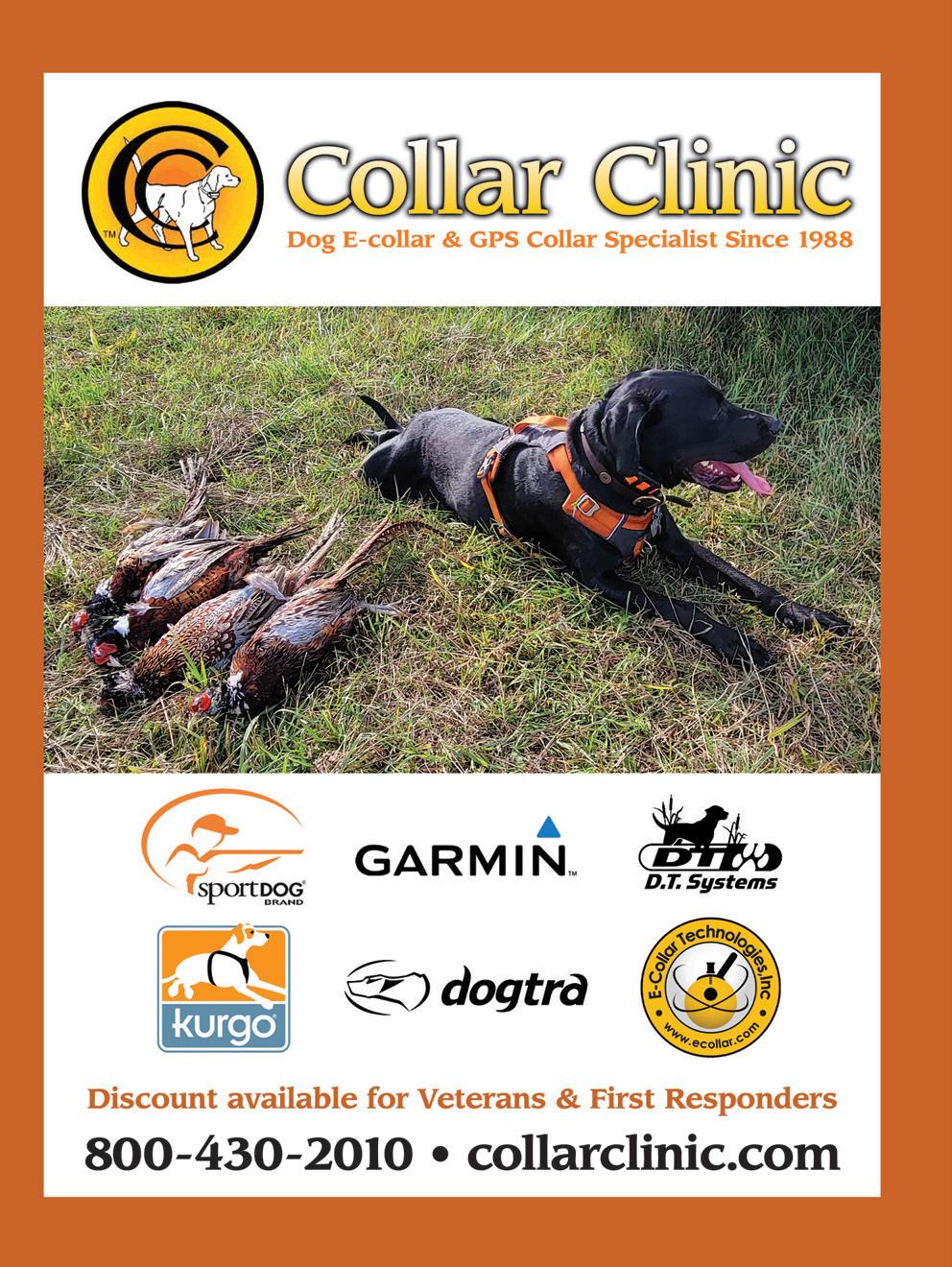
BLACK POWDER
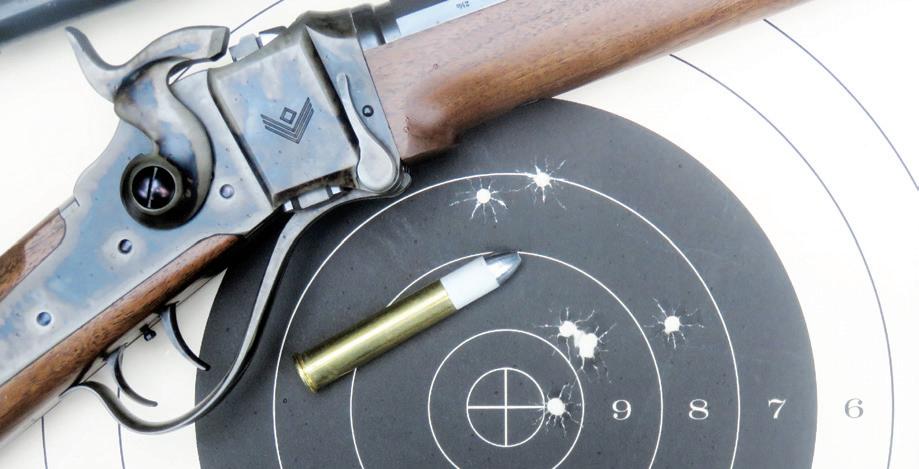
while the bullets I cast and used were made with a 30-to-1 lead-tin alloy. While I hope that is close enough, I can say that the old bullets were listed as 405 grains while the bullets I used weighed closer to 390 grains. That weight difference could primarily be a result from the alloy being used.
Carbine loads, using 55 grains of the Swiss 1½ Fg powder, were loaded and tried first. My first target was posted at just 50 yards and soon enough I had the rifle printing on paper. A very good five-shot group was fired at 50 yards, with a 1 3/8-inch spread, which shows how the carbine loads worked just fine at shorter ranges.
For the rifle loads, which used a full charge of 70 grains of the Swiss 1½ Fg powder, another step was required. The 70-grain powder charge will almost completely fill the case, so over the powder, a .060-inch Walters’ veggie wad was used. With the wad in place, the charged cases were run through the expander die again and readjusted for the right depth in order to compress the powder. Then the bullets were seated down on top of the wad. As a final touch, those loads were also run through the taper crimp die.
THE
is quoted as saying, “I used infantry ammunition, 70 grains of powder, which I procured from First Sgt. Wm. F. Bolton of G Company, 17th US Infantry, before going out on this trip. I gave him some of our carbine ammunition in place of it.” That makes a lot of sense and while I had tried carbine loads in the Ryan rifle previously, my attention was now devoted to shooting the 70-grain rifle loads.
My first “infantry loads” did not perform well; at 100 yards, the group was scattered and the bullets were cutting oval holes in the paper, which suggests they were beginning to tumble. Some corrective tweaking of the loads needed to be done. Also, with 70 grains of Swiss 1½ Fg powder, the velocities were certainly too fast, by at least 50 feet per second, for duplicating the old .45-70 loads.
The next try simply used the same bullets over 70 grains of Swiss 1 Fg powder. But the Swiss 1 Fg powder was also “too hot,” giving velocities higher than the typical 1,330 fps of the old “rifle” loads. So other powders will have to be tried.
Meanwhile, friend Allen Cunniff looked at this rifle and noticed the barrel had been chambered for paper-patched bullets, with a very gentle leade, or distance, to the beginning of the rifling. With such a chambering, this rifle could still perform with the standard style of grease-groove bullets, but it should perform better with paper-patched bullets. So Allen gave those a good try, and his shooting with the paper-patched bullets showed an instant improvement. Allen used a 530-grain paperpatched bullet, cast from a Ballard mold, over 70 grains of Swiss 1½ Fg powder and a .060-inch Walters’ wad. The velocity of those loads averaged about 1,200 fps. On the 100-yard target pictured above, Allen fired the two shots that are high, adjusted the scope, then fired the five-shot group that is just a bit high and right of center.
More shooting will be done but what I really must tell you is that C. Sharps Arms will be making a limited run of these 1st Sergeant rifles, complete with the MVA scopes. The final price of these beauties has not been determined as of this writing, but if you’d like more info, contact the makers at info@csharpsarms.com. ★
74 American Shooting Journal // June 2024
Here’s a 100-yard target shot by Allen Cunniff with paper-patched loads, which showed an improvement over grease-groove bullets.
IN
BOOK Custer’s First Sergeant John Ryan by Sandy Barnard, Ryan

SPOTLIGHT ON SURVIVING MANN SPOTLIGHT ON SURVIVING MANN
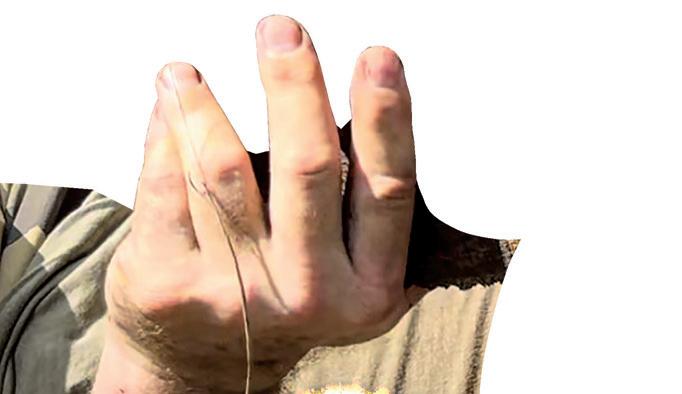
 Competitors in the third season of the show Surviving Mann, named after host Don Mann, a veteran of SEAL Team 6, were put through not only individual challenges, but also team challenges. Episodes begin airing this summer.
Competitors in the third season of the show Surviving Mann, named after host Don Mann, a veteran of SEAL Team 6, were put through not only individual challenges, but also team challenges. Episodes begin airing this summer.

A closer look at Don Mann and participants in season three of his competition show (part two).
Throughout America’s great special operations communities, the common denominators for all branches include the following: a positive attitude, selfdiscipline, and a high level of respect and understanding of the people they are supporting. The lifestyle is a total commitment to living with integrity and honor, accepting responsibility for your actions, and accepting responsibility for your job, your mission, your family, your children, your friends and your team, whatever that may be.
These common denominators can be applied in civilian life, whether in business, family or any other endeavor we pursue. The answer is not just a yes, but an empowering affirmation!
This is the whole concept of the television series Surviving Mann. The show is an outline for how to attack life. We are constantly at war with something or someone, whether in business, health, marriage, relationships or jobs. Whatever the case – maybe it is a never-ending battle, a struggle that we all can relate to – why not implement the same models that the special operations community uses for success in our own lives?
IN THE MAY issue of American Shooting Journal, we left off with Donn Mann’s key elements of success. To reemphasize those points, they are: 1) Get up every morning and do something that makes you physically stronger every day. 2) Do something to make you faster every day. 3) Get smarter by reading books on all subjects. 4) Every day, do something good for somebody.
In Mann’s book Reaching Beyond Boundaries – the blueprint for success in life’s endeavors and the backbone for his competition show Surviving Mann – he covers the combat mindset. This mindset is well defined at the start of Navy Basic Underwater Demolition/SEAL class and continues throughout a SEAL’s career. What is the combat mindset? Here is Mann’s definition: “It’s a state of mental toughness that enables you to shield out all distractions, including fear, doubt and pain, and perform to your maximum abilities under the most dangerous and high-stakes circumstances. It is nothing
americanshootingjournal.com 77
STORY BY PAUL PAWELA • PHOTOS COURTESY OF AMERICAN STORIES
...a state of mental toughness that enables you to shield out all distractions, including fear, doubt and pain, and perform to your maximum abilities under the most dangerous and high-stakes circumstances. “ ”
less than a prerequisite for success on the battlefield, in the boardroom or any form of physical undertaking or competition. It is a quality that some people are lucky enough to be born with; it is also something that the rest of us can learn through hard work, training, dedication and experience.”
Mann’s formula for setting goals for oneself involves what he calls macro and micro goals. Simply put, a macro goal is a monumental challenge, and micro goals are smaller objectives that must be achieved prior to reaching the bigger ones.
The ultimate goal of a warrior’s preparation for exhaustive physical

and mental training boils down to their skill set with their weapons. The founder of SEAL Team 6, the late Richard Marcinko, set a standard for each of his shooters to shoot at least 2,500 rounds a week, emphasizing every week. If the math is correct, that is 130,000 rounds a year, just in the individual’s weapons alone.
Once again, if one is seeking information about defensive pistol shooting, Mann also covers that in his book The Modern Day Gunslinger. It is endorsed by many celebrities, special operations people and world-class shooters; however, the best endorsement one could ever get
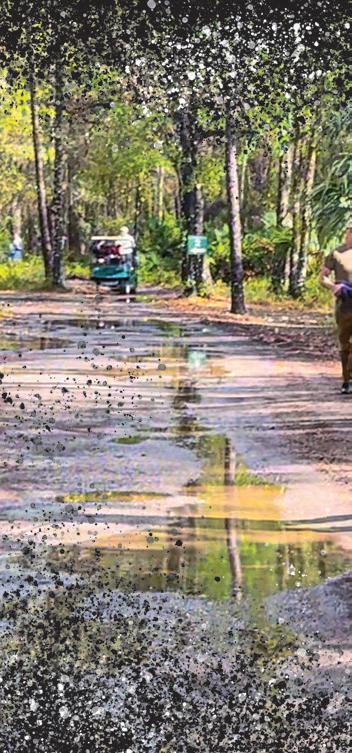

78 American Shooting Journal // June 2024
Don Mann.
Heavy rains early on in the competition did not have much effect on participants.
Competitors were put through some grueling individual challenges that tested both their physical and mental endurance.
combat mindset:
Don Mann on

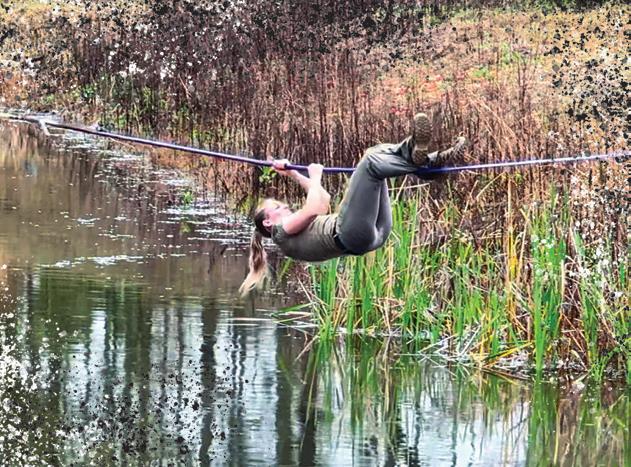
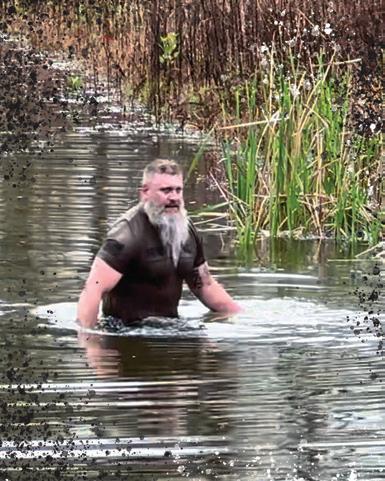
americanshootingjournal.com 79

would be from Marcinko himself.
Marcinko stated, “The Modern Day Gunslinger should be every shooter’s bible. It delivers a straightforward approach to what we all know or should know, setting it straight as it should be and serving as a daily reminder of our natural bad habits. It deserves to be on the bedside nightstand to peruse regularly, especially if you do not get to shoot often enough.” Once again, Marcinko was the founder of both SEAL Team 6 and Red Cell, which alone should say volumes about Mann.
ON SURVIVING MANN, the contestants are put to the test every day, both physically and emotionally, especially during the shooting events. Which firearm skills are exorbitant?
Most of the contestants were already established shooters in their own right, but Mann pushed them even more.
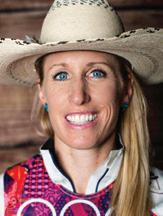
Here are a few of my observations on the participants, starting with Lanny Barnes. Not only is Barnes a three-time biathlete, but she is also the current 3-gun world champion. When it came to the shooting portion, everyone watched her with awe. When I asked her how she became so good at shooting, with a very poised, professional demeanor, her response was, “A lot of hard work.”
Then there is Caleb Christiansen. This young man is 19 years old, good-looking, and does everything almost perfectly. (I told his dad I disliked his son for these outstanding traits; of course, his dad laughed.) When I asked Christiansen what drives him to do these things, he said he always wants to push himself to improve at everything he does.
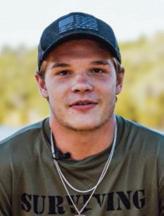
80 American Shooting Journal // June 2024
Contestants race to the top of a tree in this rope-climbing challenge.

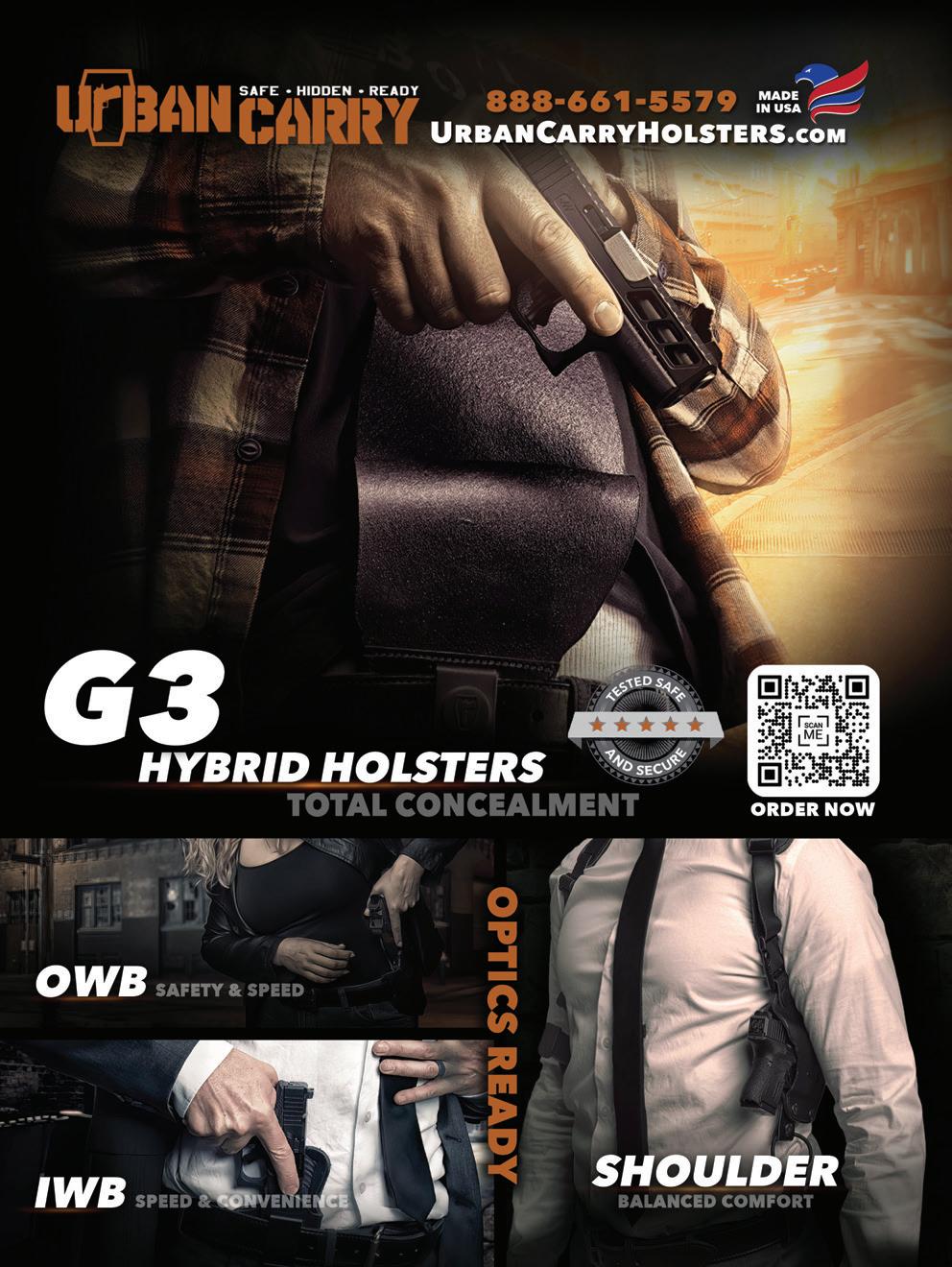
Beyond the physical tasks, the competitors had lots of shooting skills tests.
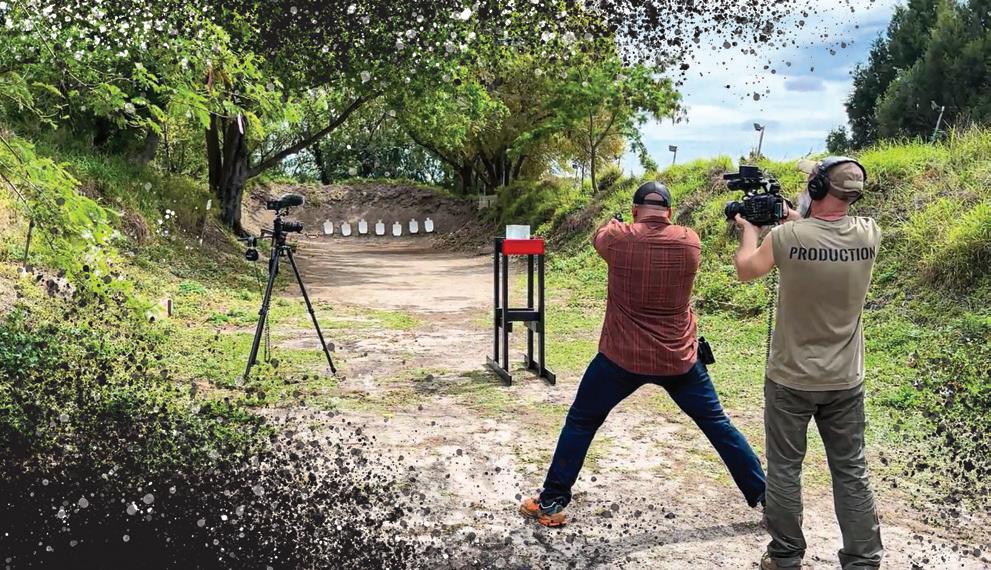
Danny Zacharias is a professional through and through. When I asked him what motivates him, his answer was simple: to be the best he can be and serve others the best way he can.


The heart and soul of Surviving Mann, Jenn Stankus has been a role model and inspiration to everyone she meets. Her take on life is that it is short; always do the absolute best you can, and when you are cheating death, always do it with a smile!

While James Wilkoszewski’s look says warrior all day, getting to know him reveals incredible gentleness and solid wisdom. His secret, be it his successful business or competing on Surviving Mann, is to surround yourself with good people; they will bring out the best in you, and you in them. It is all about teamwork!
Kyle Baker’s resume speaks volumes, and his shy demeanor speaks with loud confidence. How does he see himself? He is a servant to others, one who demands his ultimate best in all he does to protect others!

Having spent his entire life in physical fitness, in one form or another, Matthew Osborn wants to push himself to be better at everything he does. Osborn wants to set the bar high in all he does to inspire others to be the best they can be. He is both role model and team player.
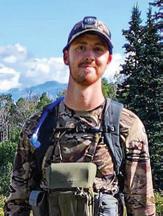
Stephen Erle is another example of what a role model should look like. He walks the walk, already instilled with what it takes to work in the special operations community. Having served in the Navy’s NAVSPECWAR for eight years, Erle leads by example in everything he does. Like all show competitors, he attributes his success to hard work for the love of God, family and country.
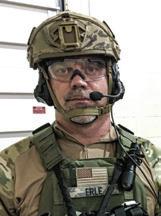
82 American Shooting Journal // June 2024


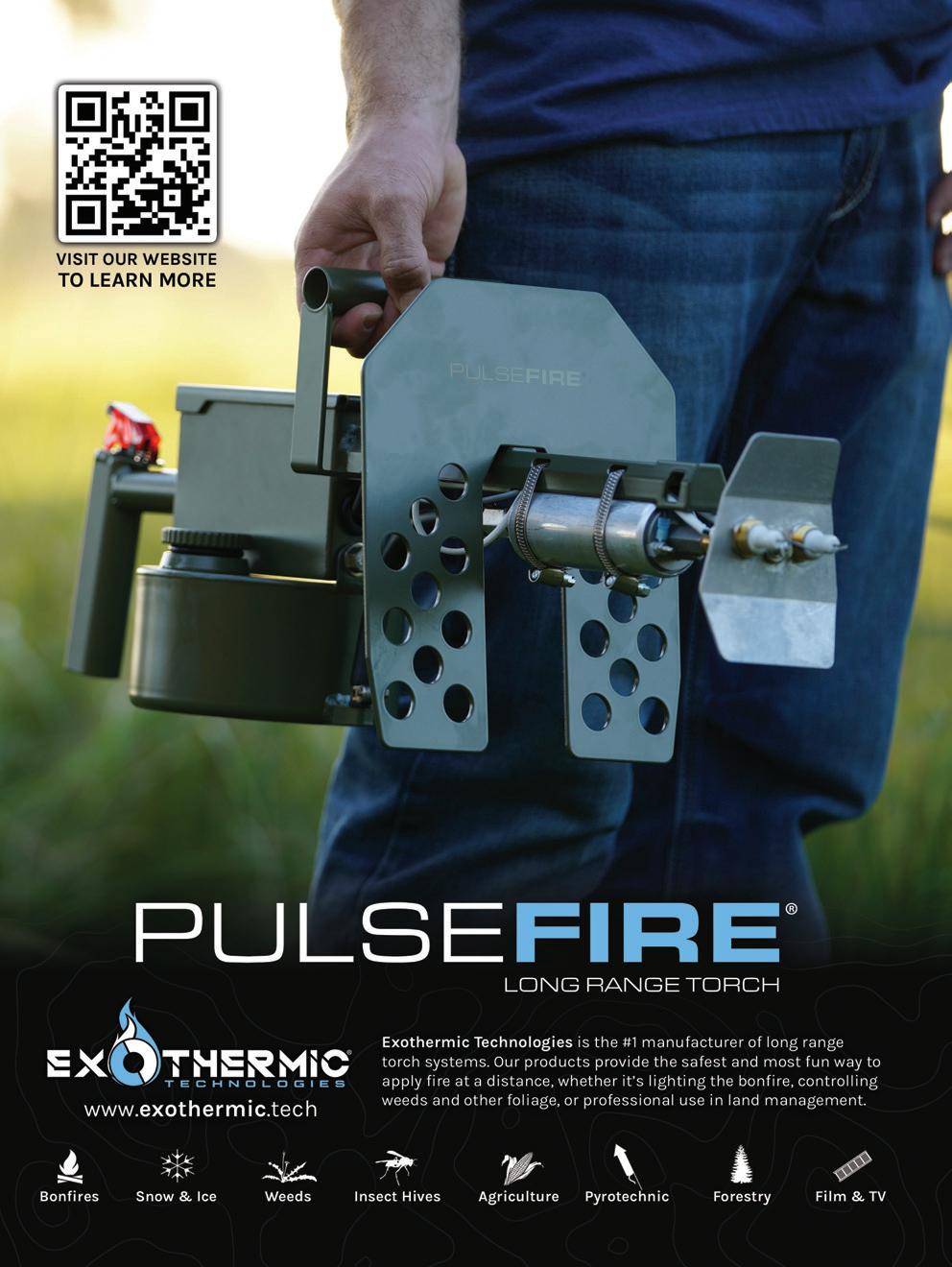
I HOPE THAT you, the reader, also see the common denominators of all these extraordinary Americans who competed on Surviving Mann, too, including the host, cast and crew. They are all 100-percent Americans who bleed red, white and blue. These people do not know the meaning of quit; it is not in their vocabulary. These



people are givers, not takers. They are the heart and soul of this country. They exude happiness, and yet, if push comes to shove, every one of them is very lethal.
The bottom line is that they are the kind of people you want around you in good times and bad because they have the grit to get you through
anything. Rest assured, I am a better human being for spending a week with these wonderful people.
And that’s my two cents!
On a final note, I would like to thank all the sponsors of Surviving Mann (see sidebar), many of which will be covered in future issues of American Shooting Journal. ★
















SUPER NUTRIENT


84 American Shooting Journal // June 2024
aggressor.com supernutrient.com genesisarms.com exothermic.tech urbancarryholsters.com freedomprotectivegear.com inergytek.com zaviarfirearms.com / t6firearms.com inthelighturns.com airguntitans.com ptr-us.com offgrid.co byrna.com athlonoptics.com viktos.com hybridlight.com betrulywell.com flagguard.net complianttechnologies.net crossfiremw.com contingencymedical.com blackacestactical.com
SPONSORS FOR SURVIVING MANN


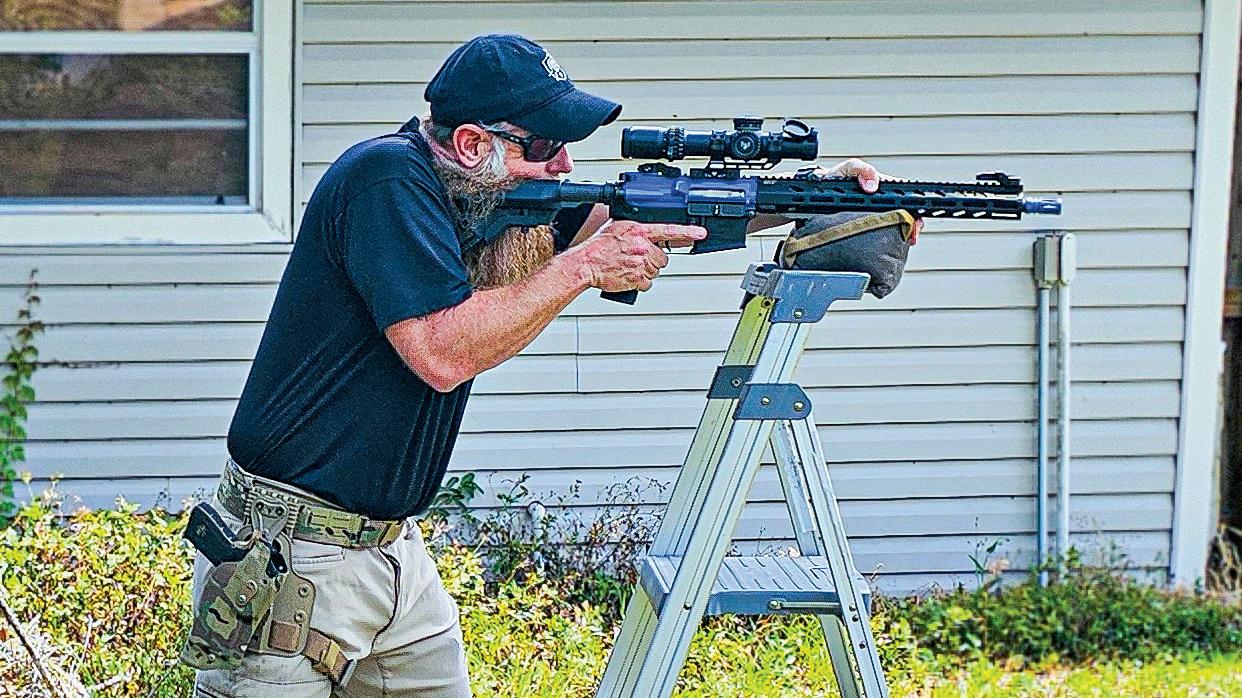
STABILITY IS KING
One expert’s body-as-a-tank school of rifle and handgun shooting stances.
Aiming is simple for most shooting, particularly closein work. If the sights are near the center of the target when the bullet exits the barrel, it will land there. What is hard, though, is the second part, and for this, stability is king. It applies to rifles, pistols, bows, slingshots and even rockets. It requires you to use your body and the environment to hold the tool on the same spot long enough for the shot to leave. Stability will minimize both the dreaded wobble zone and triggercontrol woes that most shooters

encounter, and lead to the fastest gains in your shooting performance.
In this article I am going to talk to you about how I build a body position focused on standing, which is the base in various situations, and hopefully relay it in a way that you can immediately apply. I can tell you right now that some will disagree, and my methods might not match your shooting style. This is a baseline and hopefully you will get something from it.
CHASSIS
In this example, the chassis is your feet, knees and hips. To start off on a good foot – pun intended – I build positions based on stopping movement. If you
look at reality, combat and many of the most popular shooting sports, you will either be stopping to do the shot, moving immediately after the shot or shooting on the move. This also makes it easy for you to figure out proper foot placement.
What I want you to do is start walking, then stop with your nonfiring-side foot forward. Look at your feet; this is where they go. They are facing the direction of travel, spread out properly and you are balanced. If they were not balanced when you stopped, you moved one of them without any mental effort. You learned this about the time you started walking and there is no special ninja technique
TACTICAL
americanshootingjournal.com 87
TRAINING
STORY AND PHOTOS BY ASH HESS
Author Ash Hess aims a Unit4 Training Rifle with relaxed, level and even shoulders.
TACTICAL TRAINING
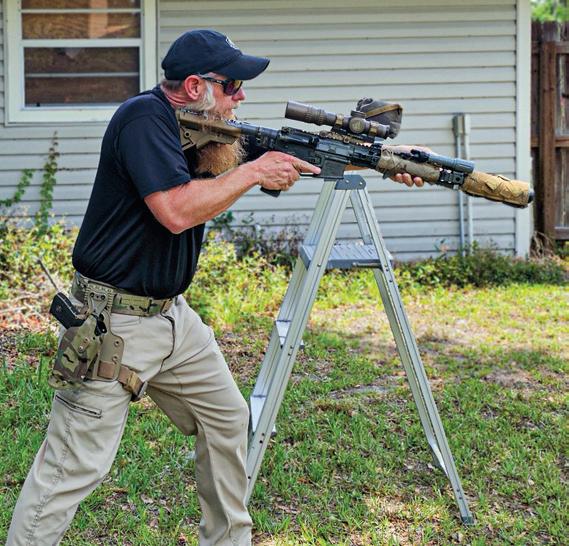
Notice that Hess’s shoulders, hips and knees are all pointed towards the target/direction of travel.
that is going to be faster to apply. This is the start of the body position.
Using that same technique, you will notice that your knees have a slight bend and are pointed in the direction of travel. Your hips are oriented the same direction. Just by stopping movement we have oriented the lower half of the chassis either in the desired direction or towards the target. We also made it something we do naturally and are already well practiced at. This makes it rapid and stable to assume.
TURRET
If your chassis is your lower body, your turret in my example is your hands, arms, shoulders and core. I start with the non-firing hand, as that hand is in the same position for both rifle and pistol shooting. If that hand is moving between the two, you are giving away stability on one of the tools. If you look at most people shooting pistols, the non-firing hand is fully extended with a slight bend in the elbow. It is also generally in the centerline of the torso if viewed from
the front. I use this same position for my hand on the rail of a rifle.
Another thing you will notice if you view from the side is that the non-firing shoulder is not forward of the other shoulder but in a neutral position. Many – too many – people push this shoulder forward so they can reach further onto the handguard of the rifle. This comes from bad information being presented either in person or on the internet. I will explain more when I get to the core, but for now, keep your shoulder back. While not necessary, I point forward with my non-firing thumb on both pistol and rifle. To see the value in this, point at something small or far away with that thumb. You will notice that while elevation might not be exact, you are pointed at the target. This helps with gross aim at a target and is helpful when transitioning targets. It, again, is using something you have been doing most of your life to aid in shooting.
The last job for your non-firing

88 American Shooting Journal // June 2024
Hips and shoulders oriented together, Knight’s Armament Company CQB in a ready position.

The Premier Manufacturer of AR Triggers
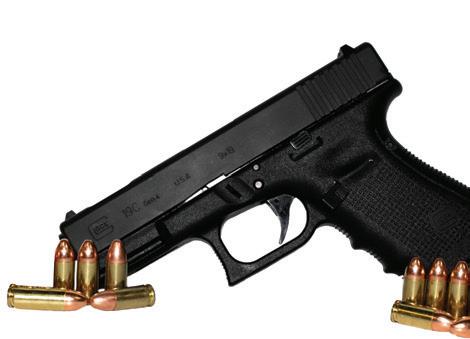
ELF Glock Trigger
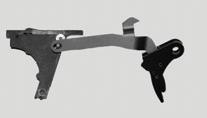

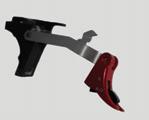

Introducing the ELF Glock Trigger, for Glock Gens 1-4. This advanced trigger is engineered for precision, featuring a short creep and a glass-like break that guarantees swift and accurate firing. With an adjustable pull weight ranging from 1 1/2 to 3 1/2lb, this trigger caters to individual preferences for a personalized shooting experience. The aluminum trigger shoe, available in sleek black or vibrant red, brings style and also ensures durability. Crafted from A2 steel, the ELF Glock Trigger delivers both longevity and reliability, utilizing the Glock’s stock firing spring and stock safety spring for full ignition. The Glock Slide will need to be milled which ELF offers as a service.
ELF APEX Trigger


The ELF APEX Trigger has been built for performance. Pull weight is so easy to adjust it can be done in seconds without removing the trigger from your lower receiver. A second-to-none AR-Platform drop-in trigger system that is strong and light, made of wire EDM machined, hardened A2 tool steel and lightweight aircraft-grade aluminum. Available with a curved or straight shoe along in black or red. It can also be purchased in our Pro Lock Threaded Mounting System.
The amazingly short take-up, glass-rod crisp break, no skip technology and our new adjustable sear lets you customize the over-travel can be compared to the finest custom 1911 triggers. If you are looking for the finest adjustable trigger for your AR platform, this is the trigger system for you.
The ELF-SE Drop-In Trigger maintains the Elftmann reputation for quality, craftsmanship and customer service in an affordable package. Extremely short takeup, clean crisp break and very short, positive reset. It has a brand new look and features such as, an adjustable pull weight being one of them! Available in our Pro Lock Threaded Mounting System.
Fits any and all AR platforms (large pin Colt available) with features including: Drop-safe, adjustable from 2 3/4 to 4lbs without removing from lower, Patented Double-Double torsion hammer spring, short pull and reset allows for rapid follow up shots, lightweight aircraft-grade aluminum and hardened steel construction, design of disconnector allows full 1/4” width eliminating possibility of wear and double-firing, adjustable aluminum trigger shoe (available in straight or curved, red or black)
ELF SE Trigger
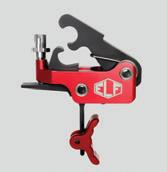

APEX-PRO-R-S APEX-B-C-FA
elftactical.com | elftacticalmarketing@gmail.com | 602-441-5007 SE-R-C-FA SE-PRO-B-C
TACTICAL TRAINING

hand is to enhance stability, either by providing grip strength, grabbing, slide or bolt manipulations, or anything else that needs doing outside functioning the trigger. Notice I have not called it the weak side. Words mean things and it is counterintuitive to say “Provide a crush grip with your weak hand.” Thus, I use firing and non-firing hand.
The firing hand will also be the center of the body, as the rifle or pistol is thin and we meet our hands in the middle. The elbow will be bent more when on a rifle or match the other elbow on a pistol. The hand should be as high on the grip as possible while keeping a straight line to the center of the trigger. Angles in the trigger finger will cause fatigue, odd trigger manipulations or other issues. The purpose of this hand is to manipulate the safety, the trigger and, on most systems, the magazine release. This tells you that this hand needs to be relaxed enough for movements.
A drill to check this is to make a loose fist, then move your thumb and trigger finger. Make a tight fist and do the same thing. You will notice a distinct difference between the two. The “proper grip” is as tight as possible, but you can easily manipulate your fingers.
The shoulders should be neutral and pointed at the target. If you can avoid pulling them in or doing the “tactical scrunch,” do so. If you watch a grand master pistol shooter, they are relaxed and their shoulders move together. By doing so, they stay centered on the core and the large muscles absorb recoil. Your back and shoulder muscles are symmetric and in a natural position, which reduces stress and fatigue.
You only need to lean forward enough for your balance point to be slightly in front of your hips. Think back to where your chassis is set up. A slightly forward center of gravity helps absorb recoil and acceleration when it is time to move. Odds are high, based on over a decade of observation, that the stop technique described above
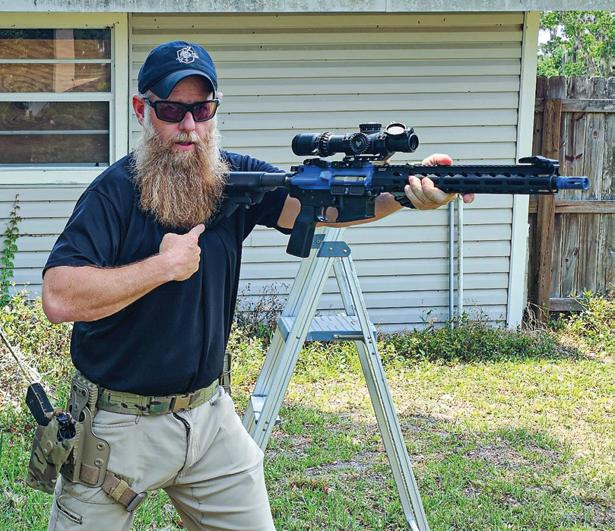
90 American Shooting Journal // June 2024
There should only be minimal differences between your stances whether aiming a rifle or a pistol.
If you can reach down the handguard when in the firing position, your shoulder is moving out of position and forward.




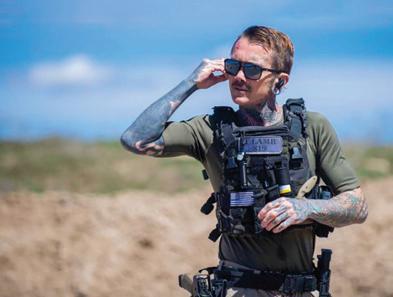



americanshootingjournal.com 91 locally owned • custom ars Virtual Training, Live Fire and safety training to all ages tatted tactical small town firearms dealer supplier in Burley, IDaho facebook.com/tattedtactical tattedtactical@gmail.com (208) 831-8253 One of the most accurate rifles in the world upgrade your firepower today www.hellerarms.com 503-397-9721
TACTICAL TRAINING
has positioned the shoulders slightly in front of your hip, but in the event that it did not, slightly lean forward. It is not about weight but center of gravity.
Your core provides balance and connects the turret to the chassis. It is most happy in a neutral position, meaning the shoulders and hips are pointed the same direction. This also provides the most strength. I understand that some shooting will be done with the shoulders misaligned to the hips, but we want to minimize this with foot work when time allows.
If you throw your shoulder forward to reach further on the rail, you purposely take your body out of alignment and sacrifice strength and durability, mostly to look cool on the internet. The further you reach, the worse it gets.
To check this, measure the distance between your shoulder and palm. Apply that same measurement from the end of the buttstock to the handguard. You
should be holding the handguard within an inch of that measurement.
NOW WHAT?
This should all be practiced until it can be assumed with no thought other than stop. The reason I use chassis and turret is that when we do add movement, you should look like a tank. The upper body should remain in the position described above yet independent of the direction of the chassis. Shoulders should stay in front of hips and at the same height, whether moving or stationary. People will get lower or higher when they move and shoot, which changes stability, feel of recoil and speed of movement. When it comes to shooting on the move, the obvious answer is move as fast as you can get your hits, but I like to add an actual mile per hour as a goal. You should strive for 3 to 4 mph walking speed on a torsosized target within 15 yards. This is
based on many years of conducting and teaching urban fighting. If the target requires more stability, slow down or stop.
The last thing I will speak about on movement is that when it is time to move, move. Go! If you are not shooting and just moving, go fast and smoothly stop in your firing stance. Do not stop and then assume the position. This saves precious seconds both in competition and in gun fights, which could be the difference between a win and a loss.
Editor’s note: Ash Hess is a highly seasoned combat veteran of 22 years with four combat deployments to Afghanistan and Iraq, totaling 52 months. His military training includes the US Army Master Marksman Trainer course, as well as rifle marksman instructor, urban combat leaders’, senior leaders’, army basic instructor, high-angle marksman and unit armor courses. He also wrote TC3-22.9, the Army’s marksmanship manual.
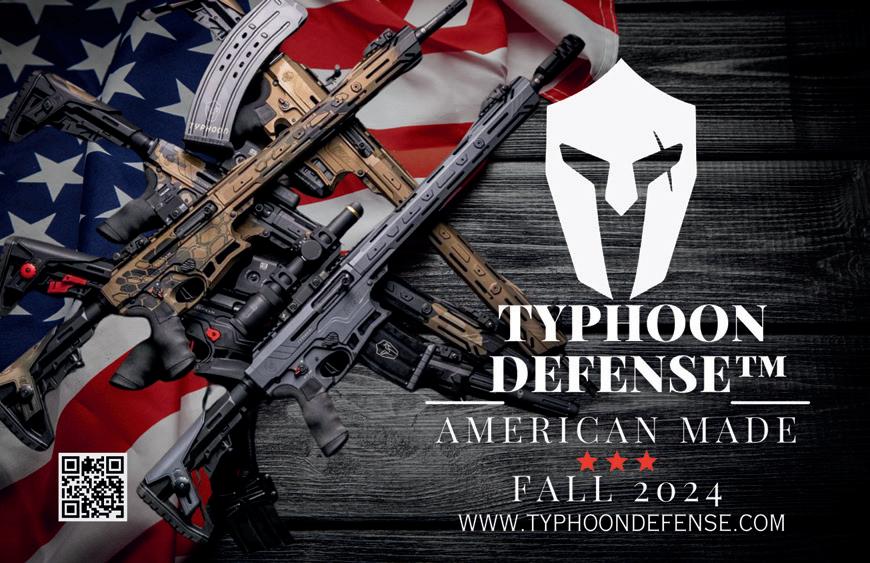
92 American Shooting Journal // June 2024

POSITIONAL SHOOTING
The most stable positions for making accurate shots.
STORY AND PHOTOS BY NICK PERNA
For most of us, we learned the fundamentals of accurate shooting as kids. I remember as a young ’un getting my first BB gun, the quintessential Daisy Red Ryder. Yes, I got it for Christmas, and no, I didn’t shoot my eye out. My dad taught me the basics of where to put my strong hand, my weak hand and how to line up the sights to get an accurate sight
picture. I later upgraded to a Daisy 880 multi-pump air gun and applied the same principles there.
Fast forward to later in life, I learned the “Army way” of shooting a rifle. In the late 1980s/early ’90s, this consisted mainly of shooting long distances from the prone position. Later in my military career, especially after 9/11, more emphasis was placed on advanced techniques based on
lessons learned in Afghanistan, Iraq and other places. I then honed my skills in law enforcement, spending even more time on tactical shooting. As a SWAT operator, I spent countless hours shooting from every imaginable position.
At the end of the day, the skills I learned with the old Red Ryder pretty much applied to all the firearms training and applications I had years
americanshootingjournal.com 93
enjoy
the best
Above:
Seated on a bench with the support of a table and bipod might be the most stable way to shoot a rifle,
but it’s rare to
such steady rests in real-life situations. That makes Army and law enforcement vet and longtime hunter Nick Perna’s ranking of
shooting positions good to know.

“Factors like location, terrain and equipment are going to dictate which position you shoot from,” says Perna, whether that’s (counterclockwise from top) standing, kneeling, seated with a bipod, or standing and supported by a tripod.
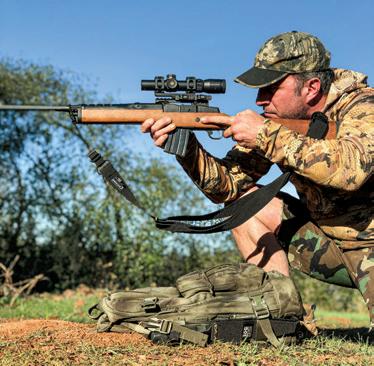

later. I believe it is important to review the basics every now and again, especially when it comes to different body positions.
I’m going to go from “worst to first” in this review of different body positions. Bear in mind, factors like location, terrain and equipment are going to dictate which position you shoot from, so you need to be proficient in all of them.
STANDING
“Worst” is a bit of a misnomer here,

but it’s safe to say it is one of the least stable shooting positions. Stability comes from a lot of things, but the main components are points of contact. More specifically, points of your body that contact the ground or some other stable surface. When you are standing, really the only points of contact are your feet. In an unsupported standing position, everything else can move, which causes missed shots. Hand, arm, neck and torso movement all affect where rounds will land.
The main advantage to standing while shooting is maneuverability. It is less of an issue on the range, but it is a big factor in the tactical world, being two parts of the “move, shoot, communicate” tactical triad. Bottom line, you have to know how to do it. Foot position is a personal choice. The bladed versus isosceles argument has eaten up as much internet bandwidth as 9mm versus .45 debates. Use whichever works for you. Just remember to keep those elbows tucked in for more stability
94 American Shooting Journal // June 2024

and less arm fatigue, as well as arch your back a bit.
The greatest piece of equipment to come about in the past few years to assist with accurate shooting is the tripod. Great for hunting, I always carry one when in the field. There are different models for every price range and, for maximum accuracy, the devices can be paired up with a mount that attaches directly to the rifle stock.
KNEELING
I have to admit to some bias here: I’m not a big fan of kneeling. I’ve never been able to find a really accurate kneeling position. That being said, there are a few key components to making it work. First, avoid boneto-bone contact. Your elbow bone shouldn’t be resting on your patella, or kneecap. I’ve heard the analogy that trying to do so is like trying to balance one marble on top of another. The elbow should rest in the thigh muscle. The other variation is to rest your tricep muscle on your kneecap. If you are flexible enough, you should have your buttock in contact with the back of your support side foot. I’ve had multiple knee surgeries so, for me, that ain’t happenin’. I use this position a lot while hunting.
When I do use a kneeling position in tactical situations, I go down on both knees at the same time. This flies in the face of what I’ve been preaching about stability and points of contact but, hey, it works for me. It works equally well with a rifle or handgun. I am an isosceles-position stand-up shooter, so I find kneeling on both knees to be a natural extension of that. The added benefit to this position is that it allows you to pivot at the waist to scan for threats.
SEATED
This is a pretty stable firing position. Like kneeling, you want to place your elbows in your thigh muscle, in this case the inner thigh. Pro tip: If you are going to use this position while hunting, make sure you let your legs relax as much as possible when not lining up a shot. Muscle fatigue is the enemy of good shooting positions. Do the same with your arms; keep your

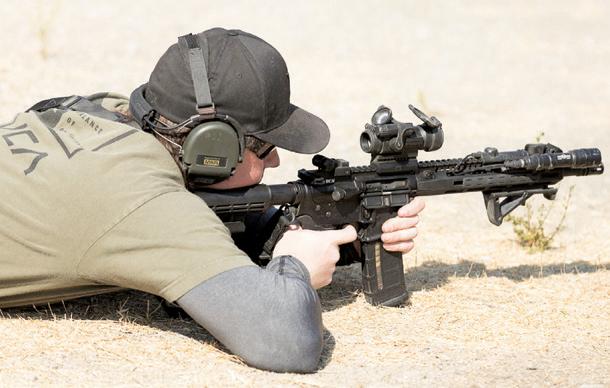
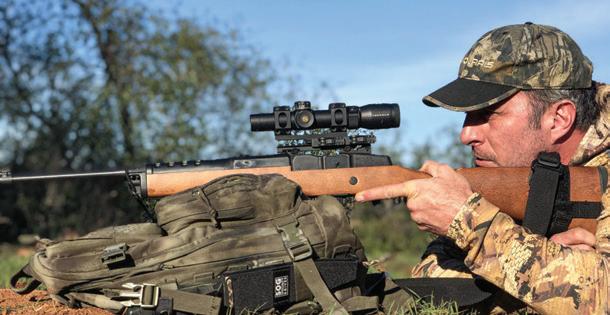
96 American Shooting Journal // June 2024
Squatting (top) is a good short-term position, but for prolonged comfort, prone is king, says the author. Adding a monopod – in this case, the rifle’s magazine – or even a backpack (bottom) can add even more stability.
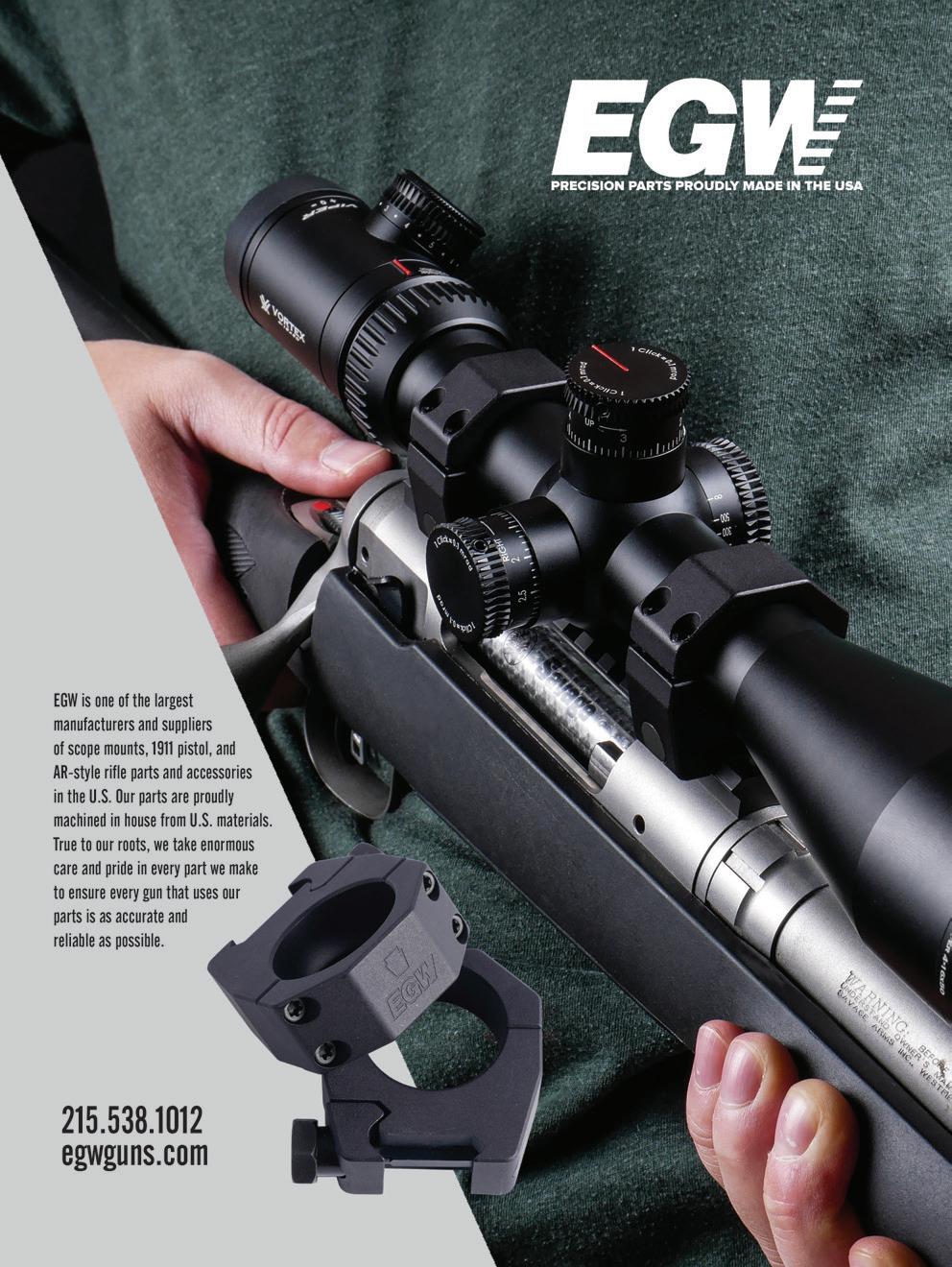
gun in your lap until it’s time to shoot. I usually have to bring my legs up a bit to make sure I get good contact between my elbows and thighs. You can cross your feet (or not) depending on what’s most comfortable for you. Another option while seated is to rest the rifle in the crook of your forearm. One lesson often learned the hard way is making sure the ground below is somewhere you want to place your butt. Puddles, fire ant hills, thistle plants and porcupines are on the short list of things you don’t want to sit on.
SQUATTING
The squat is a good, short-term position. It isn’t as stable as seated or kneeling, but you can get into it quickly and, if you are under 50 years
old, pop out of it quickly as well. You are going for contact between the triceps and the kneecaps (or elbows with thigh muscles) with your feet as flat on the ground as possible. One limitation with this position is you can only hold it for a short time.
PRONE
Prone is the king of supported firing positions. It basically turns the entire front portion of your body into one big point of contact. It is the most stable firing platform in use today. But it’s not without its limitations, the biggest being that you can only engage targets from your field of view. If you are up on a platform of some sort, that is increased, but if you are belly-down on terra firma on flat terrain, it’s quite limited. I’ve tried prone for hunting
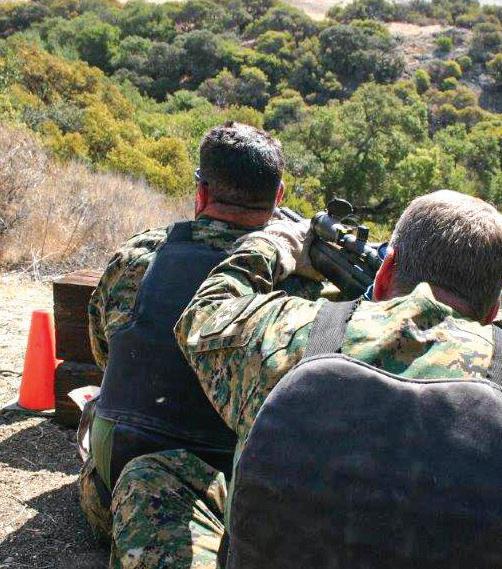
and generally find it difficult to use since you are so low to the ground. This is compounded if there is brush blocking your view.
Prone works best with a bipod or some other type of support. I prefer to use a backpack over a bipod. When hunting, I make sure my backpack is loaded evenly with a predesignated spot to lay the stock of my rifle.
Bipods are great, too, but are generally a little less stable. Try to avoid extending the bipod legs too much (if they are set up to do that). A good sniper trick is to “load” a bipod, where you push the rifle forward when the bipod legs are deployed. This takes a little bit of the movement out of the weapon and helps deal with recoil for quick followup shots.
Another good support for an AR-type rifle is to use the magazine itself as a monopod. This technique is unnecessarily controversial, as some tend to believe it can cause the rifle to malfunction. I’ve used this technique many times with no ill effects on the rifle’s ability to function.
ROLLOVER (SBS) PRONE
This is mainly a tactical shooting position, used to shoot under cover, especially cars. You lie on your side and fire the rifle, generally without the assistance of a backpack or bipod. If you get the chance to do this, 1) don’t shoot the car, and 2) be prepared to get some dirt in your face from the blast.
BUDDY SUPPORT
Snipers are taught to use their spotters as support. I’ll give it mention here, with the understanding that there are few places you can do this and you need to be extremely careful so as not to hurt your partner. I don’t recommend this unless there are no other options available. It clearly has some potential safety issues and a fellow human being will tend to wiggle around a lot, especially when they are bracing for a gun to go off.
So whether you’re talking about BB guns or .50-caliber Barretts, make sure to maximize points of contact to increase stability, which will result in more accuracy. ★
98 American Shooting Journal // June 2024
Though not recommended if other options are available, seated and using a buddy essentially as a bipod is another shooting position.
TRAINING

BETWEEN THE BATTLEFIELD AND THE BOARDROOM
A closer look at military and bodyguard training contrasts as applied to executive protection.
STORY AND PHOTOS BY GRACIELA CASILLAS
xecutive Security
EInternational offers a 28day executive protection course that culminates with a fourday firearms training session. As one of the firearms instructors working with ESI students, mostly

military veterans, I decided to explore the differences between military and civilian firearms training. I interviewed six military and nonmilitary executive protection specialists who also serve as instructors, past and present, including ESI founder Bob Duggan.
The objective was to understand some of the fundamental differences in training procedures between military
and civilian training. My goal was to uncover how military specialists adapt to and align with civilian executive protection regulations, and to get a better understanding of how the military process differs from that of civilian training.
To get to those answers, I interviewed several former military personnel including Marine Corps, Army and
americanshootingjournal.com 99
TACTICAL
Author Graciela Casillas interviewed military and nonmilitary executive protection specialists who also serve as instructors to get a better understanding of how the military process differs from that of civilian training. (SHUTTERSTOCK)
TACTICAL TRAINING
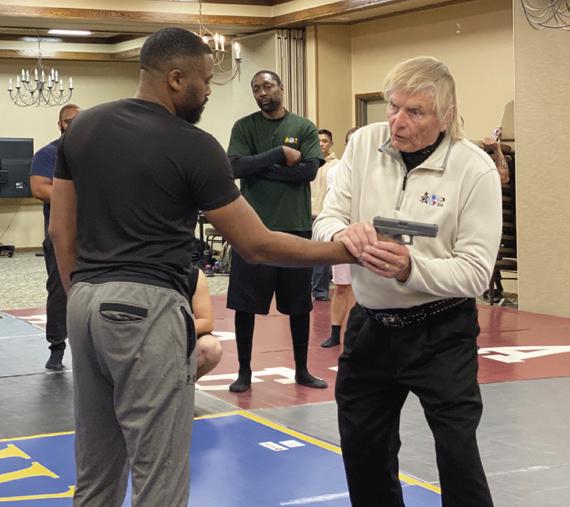
Duggan, Executive Security International founder (right), said, “The military approach is anonymous, technological. You’re relying on the total assets that the military organization can focus on a single target almost instantaneously or preemptively.”
Navy veterans, as well as two current executive protection specialists, or EPs. The answers ran the gamut from being direct and matter-of-fact to complex and prescriptive.
FIRST UP WAS Duggan, who had this to say: “The military approach is anonymous, technological. You’re relying on the total assets that the military organization can focus on a single target almost instantaneously or preemptively. Whereas with civilian, their engagement is very close and personal. And for the civilian, there’s always the shadow of the legal implications of what you do. There are consequences and that often is ignored in a crisis. But the consequences in military for making a good decision or a bad decision is very different. The clear distinction there is that there’s a military objective to everything you do, where the civilian, that doesn’t exist; it is survival largely.”
Julius Keith Buckner, a retired US Army sergeant major and range master at ESI, offered another perspective, indicating there is not a lot of difference between the two. “Both focus on
developing basic fundamentals of shooting and handling firearms,” he said. Buckner trains students going through the EP firearms program no differently than the hundreds if not thousands of soldiers he trained during his 32 years in the Army.
According to Buckner, “The primary difference between the two is that in the military they are trained to run towards the fight, while in executive protection, we are trying to get out of the fight as quick as possible without getting our principal hurt.”
Rich Kluck, who spent over 15 years as an instructor at ESI, brings a wealth of expertise to the table. Certified as an adjunct instructor for the state of Oregon’s Dignitary Protection Unit, which includes SWAT officers statewide, Kluck’s experience is both extensive and invaluable. His tenure as a drill instructor at the now closed Shutter Creek Correctional Institution in Oregon provided him with firsthand insights. Beyond his instructional roles, Kluck operates as an independent contractor, collaborating with prominent entities like the US Marshals Service, Secret Service and various jurisdictional agencies nationwide. His portfolio speaks volumes, encompassing the safeguarding of individuals, both foreign and domestic, a commitment he upholds to this very day.
According to Kluck, military veterans can be successful working in EP with proper leadership. However, he pointed out, “They’re going to have to adapt
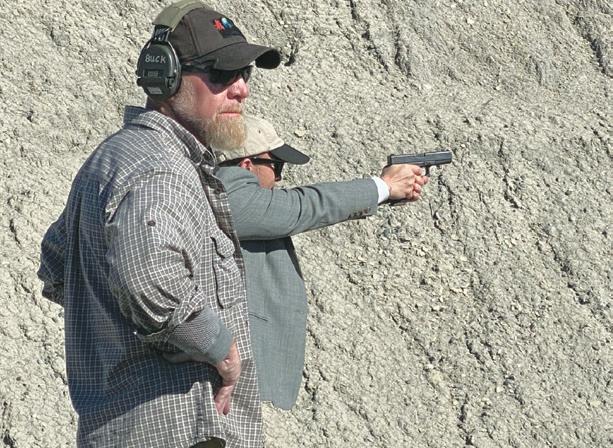
100 American Shooting Journal // June 2024
Bob
Julius Keith Buckner, a retired US Army sergeant major, said his firearms training program for executive protection, or EP, students at ESI is no different than what he taught soldiers over 32 years in the military.
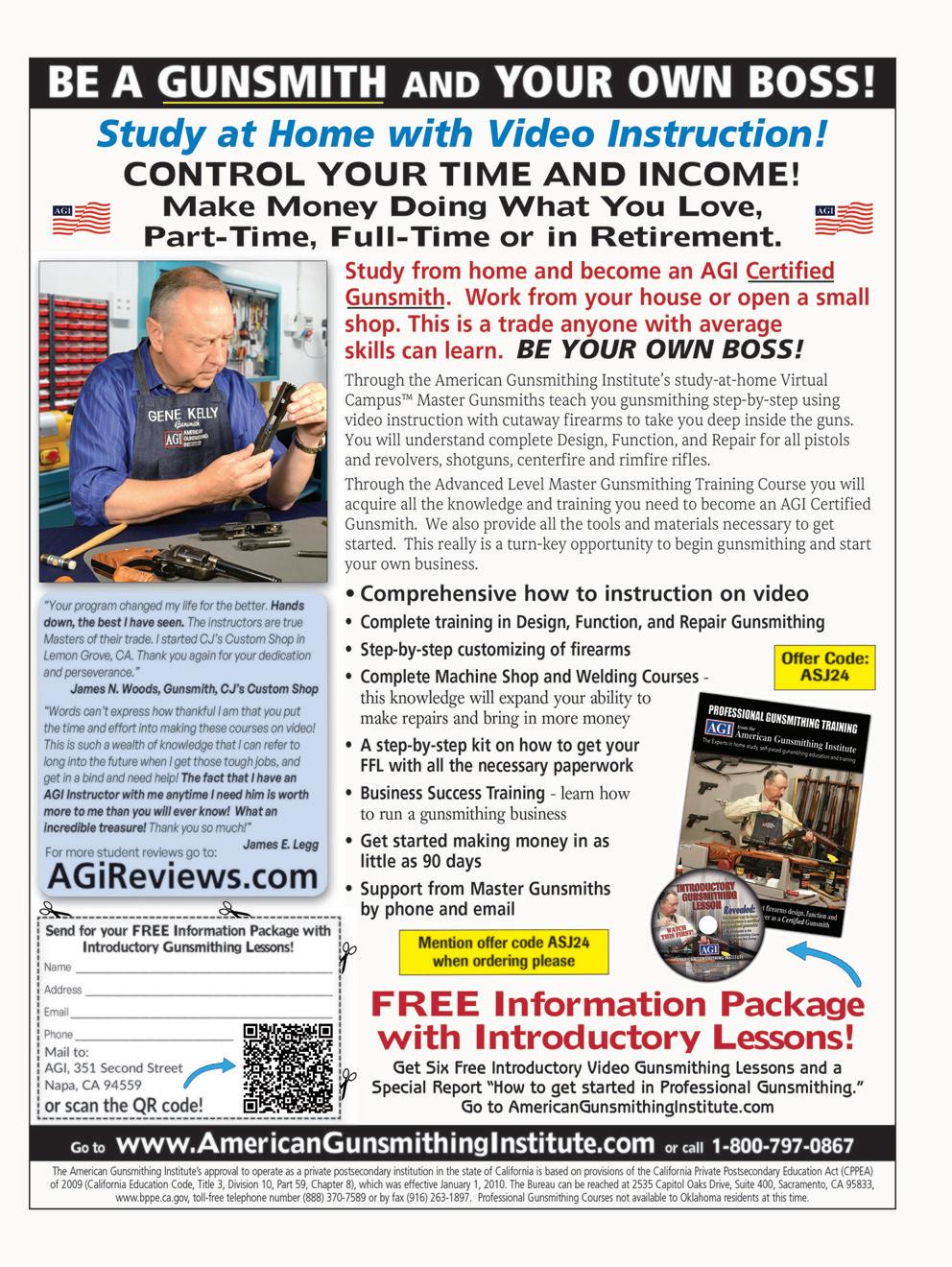
TACTICAL TRAINING
to the civilian ways and lose a lot of the aggression or aggressiveness that they’re taught in the military. It’s a thinking man’s game. It’s not going to be that deal where it’s, ‘OK, we’re going into this zone.’”
Kluck pointed out the importance of advance work. “For example, in a spontaneous attack, your first consideration is always the principal’s safety, and not going after a bad guy. It depends on a number of things. The number of your team, how well they’re deployed, is there an advance man or team, and do you have a counter assault team (CAT) and counter surveillance going on? Are you legally armed?”
“I would say that the military veteran who has some prior experience, yes, he could do very well on details, but he must blend into the civilians. It’s not going to be the same way as it was in the military, especially on foreign soil; if he’s coming back to work in the US, there


will be a significant difference.”
Ayden Singh, a Marine Corps veteran, sees the purpose and role of military training versus EP in a different light. “There’s no way around it besides saying that we are being trained to be as lethal as humanly possible against an enemy force, foreign or domestic. We are there to be war fighters and be professional at it. In the civilian world, the focus may be on defending yourself, your family, your friends, your client.”
Singh’s point is that civilians’ focus should be on de-escalating situations, whereas in the Marine Corps, it’s all about war fighting.
Cliff Silverstone, a Navy veteran, did not receive extensive firearms training during boot camp. After years of training and working in the security industry, Silverstone values ESI training methods because the curriculum includes various training scenarios, with the possibility of providing students options in developing their shooting skills, versus military training, which is highly structured and strict. Civilian trainers teach a variety of shooting methods, and it is up to the individual to
102 American Shooting Journal // June 2024
Expert instructors said some military veterans who have some prior experience could do very well at EP but must be able to blend in with civilian ways.
ESI training curriculum includes various training scenarios, with the possibility of providing students options in developing their shooting skills, versus military training, which is highly structured and strict.











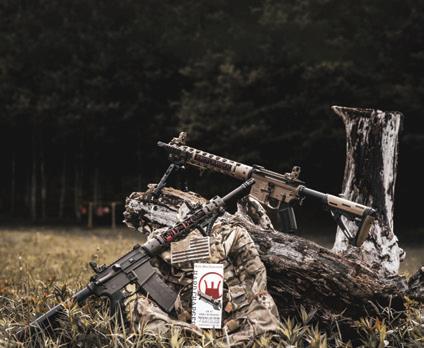
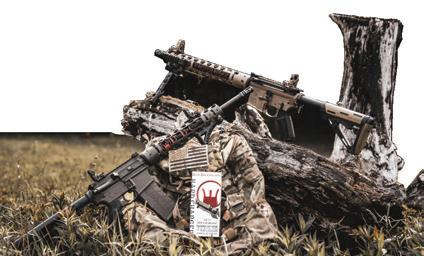

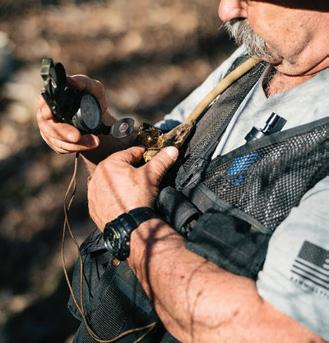
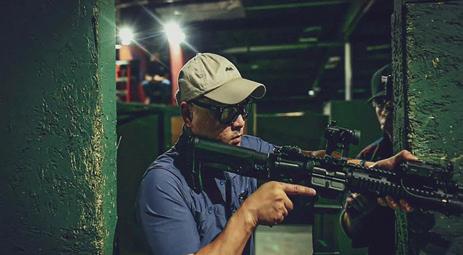



we bridge the gap between warriors and everyday heroes 8524 Neely Ferry Rd, Laurens SC 29360 Elite Training for Specialized Forces Empowering Civilians: Resilience and Preparedness sawmillttc.com864.677.5862 SEWN GOODS FOR THE SHOOTING COMMUNITY SLINGS | HARDWARE P.I.M.P. | MEDICAL EAR PRO WRAPS DUMP POUCHES 470-507-4624 flatlinefiberco.com Make it a SIDE CHARGER No Machining - No Modifications Developed from Decades of Experience in Military, SWAT & Law Enforcement DEVILDOGCONCEPTS.COM @SIDECHARGER 844-666-7244 • BETTER ERGONOMICS • NO TOOLS TO DISASSEMBLE • NO MODIFICATIONS TO INSTALL • MULTIPLE OPTIONS & HANDLES
TACTICAL TRAINING
decide what tactics work best for them.
I SPOKE TO Gabe Thompson, another Marine Corps vet, about his bootcamp experience, where there was a lot of rifle training and no pistol training.
“As marines, we were trained to be riflemen and trained to shoot up to 500 yards on a point target, learning to shoot silhouette-style targets and eliminate an enemy force. Upon completing our rifle range training, going to our combat schools, we would learn how to engage the enemy, close-quarters combat, roomclearing, but really, just how to work and take commands from a superior on fighting the enemy,” Thompson said.
“The only individuals who get pistol (training) off the get-go are going to be officers,” he added. “And then once you become an E-6 or higher, if you’re an MP (military police), or if you are in specific combat MOS (military occupational specialty) and you require a secondary, so machine gunner will have a pistol, corpsman or medics will have a pistol. In my case, I was lucky enough to train with handguns, but that was about eight months into my career when I became a firearms instructor.”
“I would say there’s a lot of civilians that once they take their first class, they think that now they’re experts and they’ll never come in for followup training. They complete a three- or four-
hour class, and they feel that they have enough training to carry that gun on a day-to-day basis and use it, which, in my opinion, they do not. They need to have followup training. Coming from a military background, we are pushed on those basics: finger discipline, safety, where to and to not point our firearm or how to carry it, and just respect that gun and respect those around us.”
Mark Westfall, an Army veteran, described his military training to me this way: “I would say it was fairly basic. A lot of rifle work, not very much pistol. It focused mostly on marksmanship originally when I joined, and then after 9/11, transitioned to a lot of closequarters combat and room-clearing techniques. On a larger scale, military training is focused against a more defined enemy, whereas with EP or civilian training, you must consider who is the enemy more often than not, as opposed to fighting a uniformed enemy.”
Singh added, “When I went through EP, I was fresh out of the military. After five years and three deployments, I got out, I went home for about three weeks. I give a lot of credit to all the cadre that were part of my EP course. I was fresh out. I was still in the grunt world, but they helped me alter my mindset, keeping my skills sharp, but altering it and tailoring it to be what the EP world is, (which) is that you’re not up front.”
“You’re not doing hard interdiction; you are doing soft interdiction. You’re diverting, distracting, getting a different mindset completely, but still maintaining the skills that you learned in the military of being a professional warfighter, a lethal person, being able to guard people as you need to, because it’s not like PSD (protective security detail) world. The EP world is a lot quieter, so to say. It’s a suit and tie. You’re respectful!”
AS I NEARED the conclusion of my interviews, I felt compelled to delve deeper into the nuances distinguishing various military divisions. My conversations led me to Christopher Druin, a seasoned veteran with a rich background in the US Army Rangers, Special Forces and as a Special Operations combat medic. What unfolded was interesting.


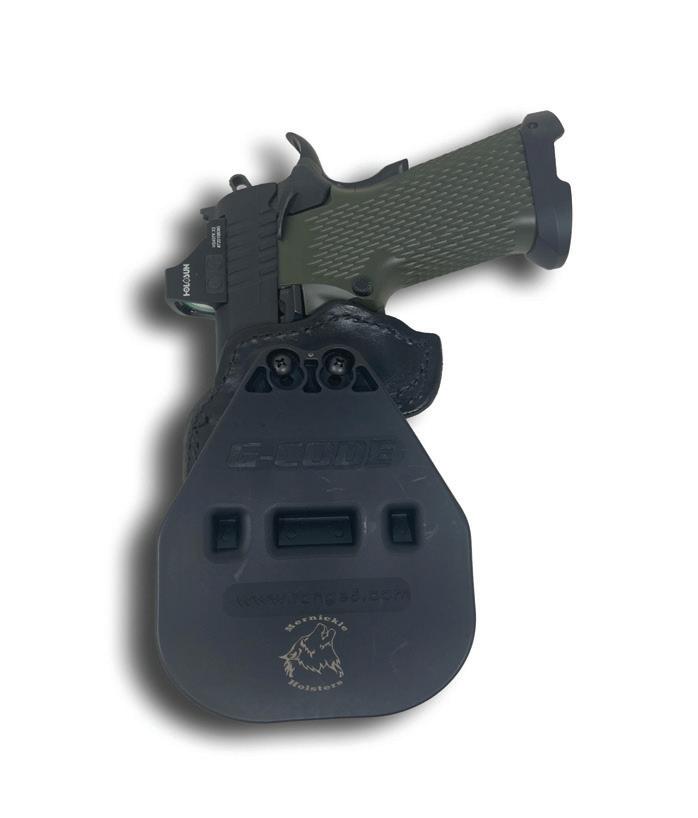
Druin described a significant contrast between the Marine Corps, conventional Army or Navy units, and the branch of Special Operations. He emphasized “our identity as ‘quiet professionals’ adept at seamlessly integrating into diverse environments and employing intellect alongside strength, eschewing mere brute force.”
These interviews uncovered significant insights into the dynamics and disparities between military and civilian firearms training in executive
104 American Shooting Journal // June 2024
“I would say there’s a lot of civilians that once they take their first class, they think that now they’re experts and they’ll never come in for followup training ... They feel that they have enough training to carry that gun on a day-to-day basis and use it, which, in my opinion, they do not, ” said Gabe Thompson (black shirt).
■ Embedded bar magnet for unmatched retention
■ Paddle backing for comfortable carry


■ Durable, custom molded leather construction
■ Enables smooth, one-handed draw

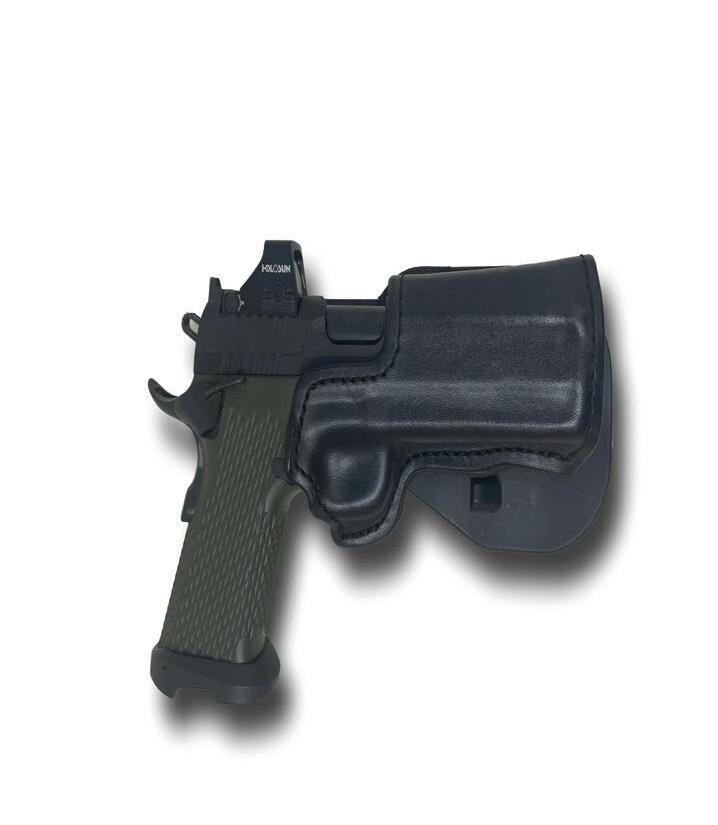

■ Precision fit for your pistol
■ Suitable for concealed or open carry
■ No straps or retention screws to get in the way
■ Works with pistols with steel frames
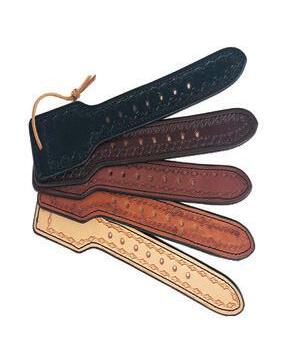
If you’re looking for a holster that keeps your pistol secure while allowing for a fast and smooth draw, the AlphaMag™ retention Holster is the perfect choice. The combination of magnetic hold and paddle design sets this holster apart, providing both next-level retention and comfort.
Black
Mahogany Brown
Gunfighter Brown
Saddle Tan Natural
The
CHOOSE
LEATHER
YOUR
1(800) 497-3166 MERNICKLEHOLSTERS.COM
TACTICAL TRAINING

“On a larger scale, military training is focused against a more defined enemy, whereas with EP or civilian training, you must consider who is the enemy more often than not, as opposed to fighting a uniformed enemy,” stated Mark Westfall (carrying clipboard).
protection. Though similarities exist in foundational shooting skills, the goals, ideologies and operational intricacies vary considerably between military and civilian contexts. Military veterans shifting into civilian EP roles must adeptly navigate these differences, drawing on their past experience while adjusting to the distinct requirements of civilian executive protection.
Editor’s note: Author Graciela Casillas is a certified personal protection specialist who works as a staff instructor with Executive Security International bodyguard school (esibodyguardschool .com). She is also an advanced firearms trainer and has worked with many world-class firearms instructors. She has authored many articles on the subject for various publications and holds a bachelor’s degree in law and society, master’s degrees in education and physical education, and lifetime teaching credentials in psychology.
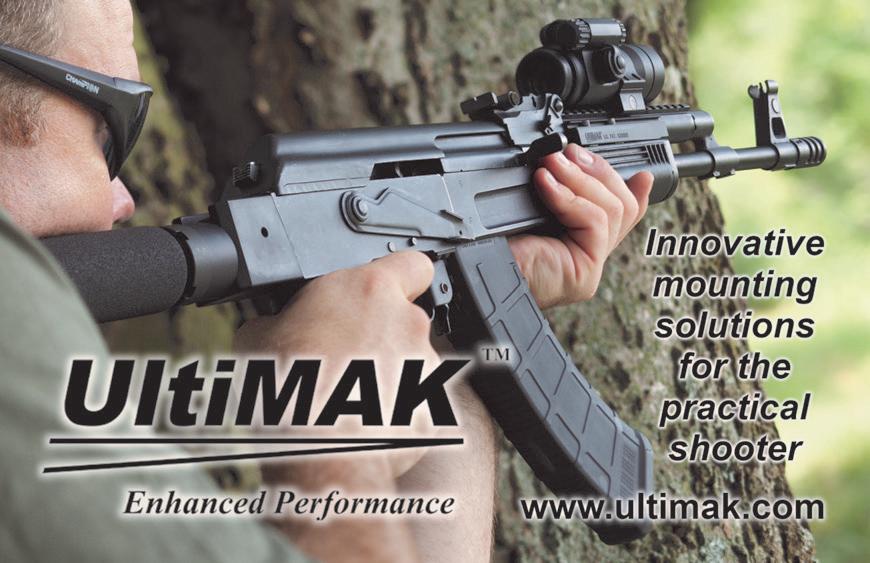
106 American Shooting Journal // June 2024

SAR9C: THE COMPACT 9MM THAT CAN SAY, ‘MY DAD’S IN NATO’
You can spend a lot more on similar scaled-down semiautos from bigger names, but this pistol ‘delivers the most value for the money.’
STORY AND
 BY FRANK JARDIM
BY FRANK JARDIM
108 American Shooting Journal // June 2024
PHOTOS
The SAR9C is a lot of 9mm pistol in a lean, lightweight package. The Streamlight TLR-8 AG combo green targeting laser and 500-lumen tactical light is a perfect fit on its tactical rail.
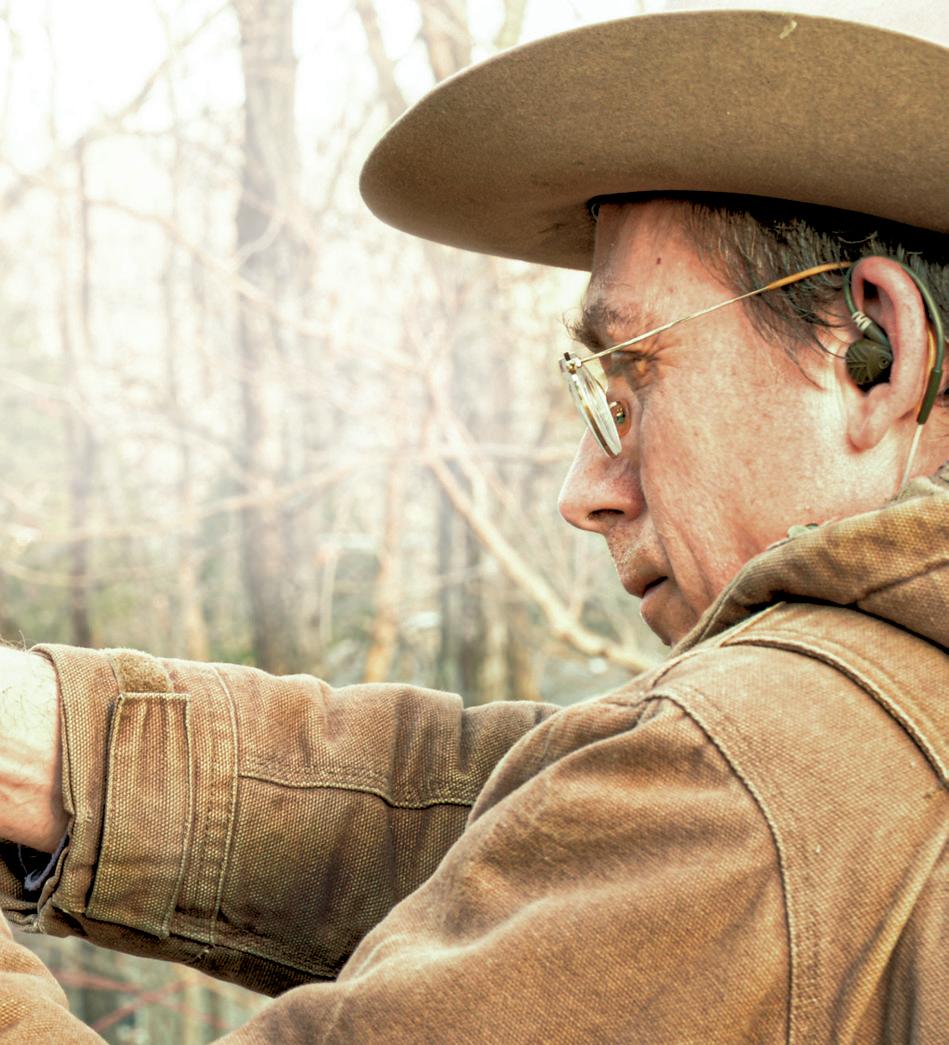
SAR USA’s product line is made by Sarsilmaz Firearms Corporation in Turkey. They’ve made arms for the Turkish military for more than 100 years and are to Turkey what Fabrique Nationale is to Belgium and Sig Sauer is to Switzerland.
The Sarsilmaz SAR9 pistol was selected as the standard-issue sidearm of the Turkish Armed Forces, beating out pistols from Walther, Glock, Sig, FN and Smith & Wesson in a competition that included a NATO 90,000-round live-fire endurance test. Sarsilmaz had no doubts about their pistol’s durability, since it had already successfully undergone a 150,000-round test by the factory and a 50,000-round test by the Turkish Police. It’s one tough, reliable and accurate gun.
americanshootingjournal.com 109
review
gun
gun review
I TESTED THE SAR9c, the compact version of the military SAR9, which has a shorter 4-inch barrel and grip frame that takes 15-round magazines instead of the standard military 17-rounder.
Being an original design of the Near East, the SAR9 series has a unique look with a deeply undercut trigger guard to seat it deeply in the hand and a 20-degree grip angle. I found the ergonomics great and appreciated that it’s no larger than it needs to be to do the job.
The design appears extremely durable and wearresistant. The barrel is rotary hammer forged and its crown is recessed to afford it some protection from accuracyrobbing dents and dings.
Concealed-carry-minded buyers will find a lot to like about the SAR9C. As striker-fired triggers go, it has one that’s much better than average. The overall pull is a bit over 5 pounds, and not overly long, half of its travel being take-up before you hit the wall where further pressure will carry it to break. In quick shooting you never even notice the wall. The trigger also has a red triangle molded into the rear portion that is fully exposed when the striker is cocked to serve as a cocking indicator.
The exposed extractor serves as a visible and tactile loaded-chamber indicator. Unlike the full-size SAR9, this compact doesn’t have a manual safety. The magazine release button can be switched to the right side for left-handers. The slide and magazine release are steel and textured for more positive thumb operation. The slide has deep gripping grooves forward and rear. The front of the trigger guard is also grooved to improve your supporting hand grip. There’s about 1 5 inches of rail on the bottom of the frame for the light, laser or combo unit of your choice.
Pistols come with two 15-round magazines, with a witness
Note the recessed muzzle to protect the barrel crown from damage and the slide’s tapered sides for easier reholstering, and its forward grasping serrations. All of these features appeal to author Frank Jardim. Less appealing to him is the single slot in the accessory rail. Fortunately, the Streamlight TLR-8 AG comes with several locating keys permitting you to shift it forward and back on the rail.

110 American Shooting Journal // June 2024
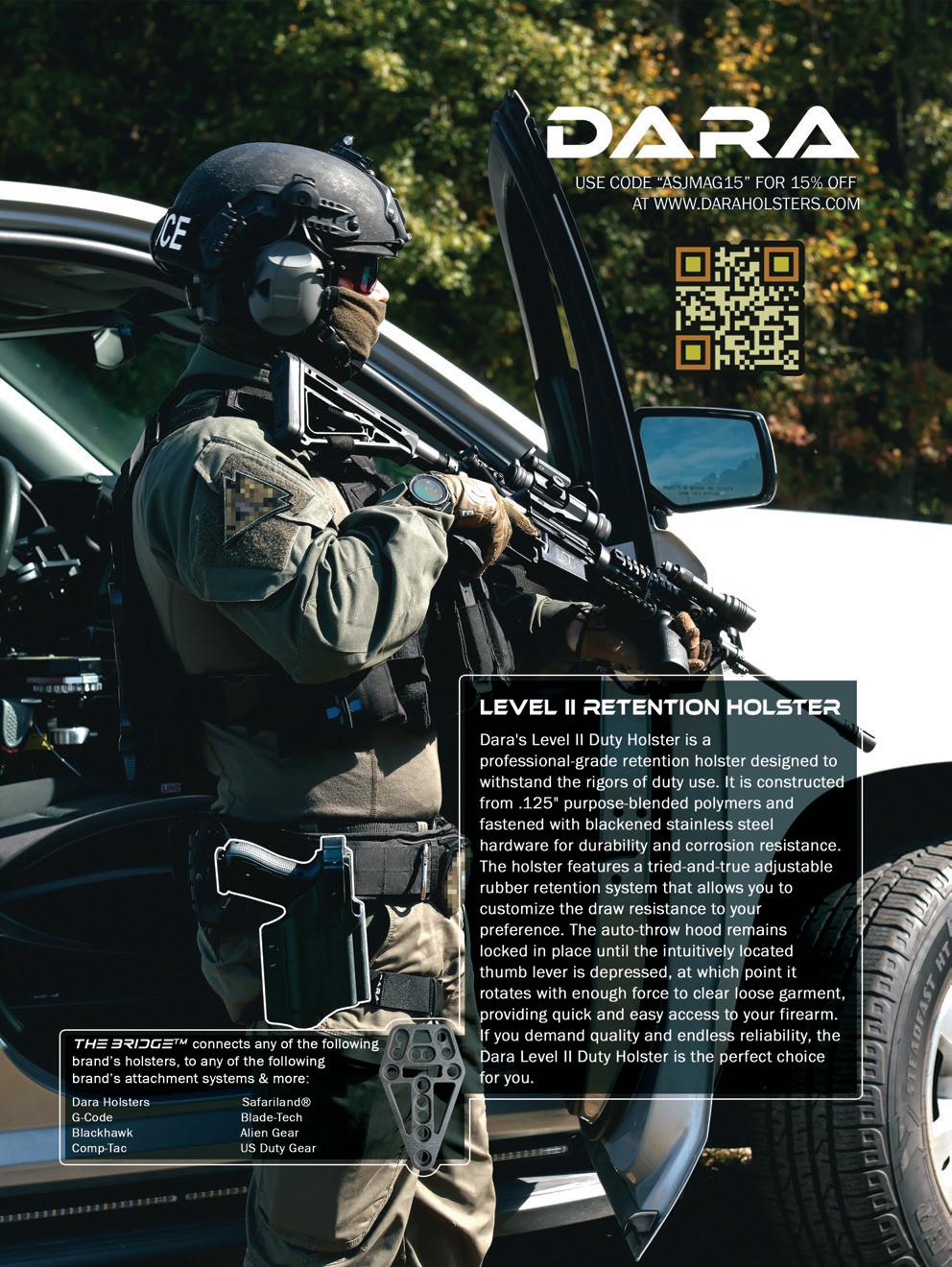
gun review
SAR USA SAR9C SPECS
Maker: Sarsilmaz Firearms Corporation, Turkey;
Caliber: 9mm;
Barrel: 4 inches;
Overall length: 6.9 inches;
Height: 5.16 inches with polymer-base magazine;
Width: 1 inch slide, customizable grip thickness;
Weight: 27 ounces unloaded;
Sights: three-dot, Patridge sights, windage-adjustable rear sight;
Material: polymer frame/steel slide;
Action: striker-fired;
Trigger: 5-pound pull;
Finish: matte black slide/black polymer frame;
Capacity: 15 (two magazines included); MSRP: $449.
hole for each shot so you’ll always know exactly how many rounds you have left. One magazine has a polymer floor plate and weighs 2 8 ounces empty. The second magazine is identical except for the thick steel floor plate installed for the sole reason of getting the overall height of the SAR9C up to the minimum required to allow its importation.
Because the SAR9C – and SAR USA in general – is pretty new to the American market, specialized holster support is lagging a bit. The allAmerican-leather Triple-K (triplek .com) Victor line (style No. 778) of OWB holsters is a good fit for the SAR9C. The XL-size holster will accommodate the gun with a Streamlight (streamlight .com) TLR-8 AG combo green targeting
laser and 500-lumen tactical light on the rail. The Streamlight fit perfectly snug up against the SAR9C trigger guard, using the 1913-4 mounting key included with the unit, and the fit in the XL holster was quite tight, the way you want it to be before you break the holster in. Without anything on the accessory rail, the large-size Victor holster is the better choice. The MSRP on the Victor line of holsters is $60.
ON THE RANGE, the SAR9C was surprisingly soft-shooting for a gun this light. Empty, it weighs barely 27 ounces. Fifteen 124-grain bullets in the lighter of the two magazines adds 6.5 ounces. The frame is designed with a cutout behind the trigger guard to get the top of your index finger a quarter-inch
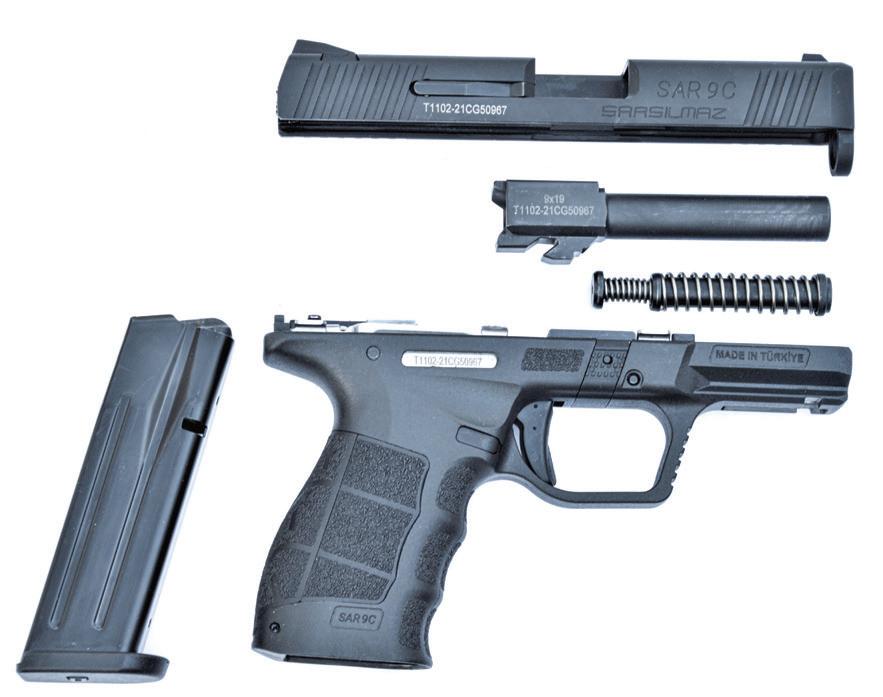
Field stripping is done with the familiar Glock-style pull-down latch inside the trigger guard. The SAR9C has widely spaced steel slide guides at the extreme rear of the frame and toward the front of the trigger guard. This would tend to stabilize the slide better in motion and return it to battery more consistently than guides more closely positioned.
112 American Shooting Journal // June 2024

gun review
closer to the bore axis for less muzzle flip, so you can get back on target faster for followup shots. This also gives you more surface area on the front grip strap to hold onto. The ergonomics were perfect for my average-sized hand. I had enough room for all three fingers. The three scallops molded into the front of the grip lined up right underneath each of my fingers.
The grip has texturing molded into the scallops along the front, the side panels, the backstrap and a small rectangle on each side of the frame above the trigger. Those little textured rectangles are apparently for the side of your supporting hand thumb.
A feature I especially like about this SAR is that you can customize the width
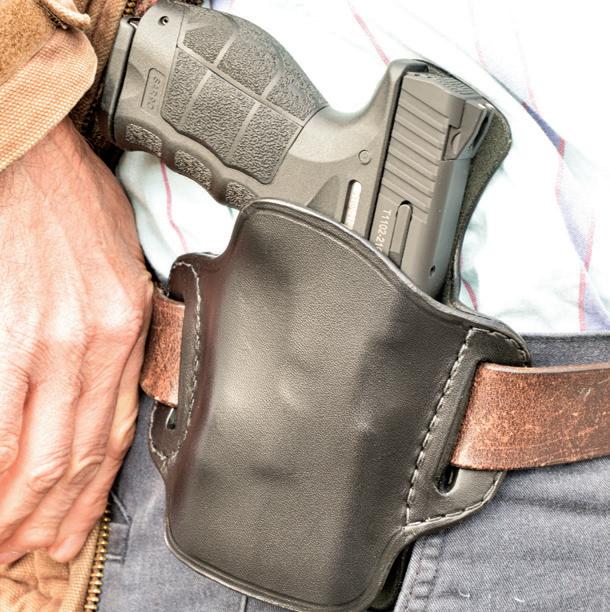
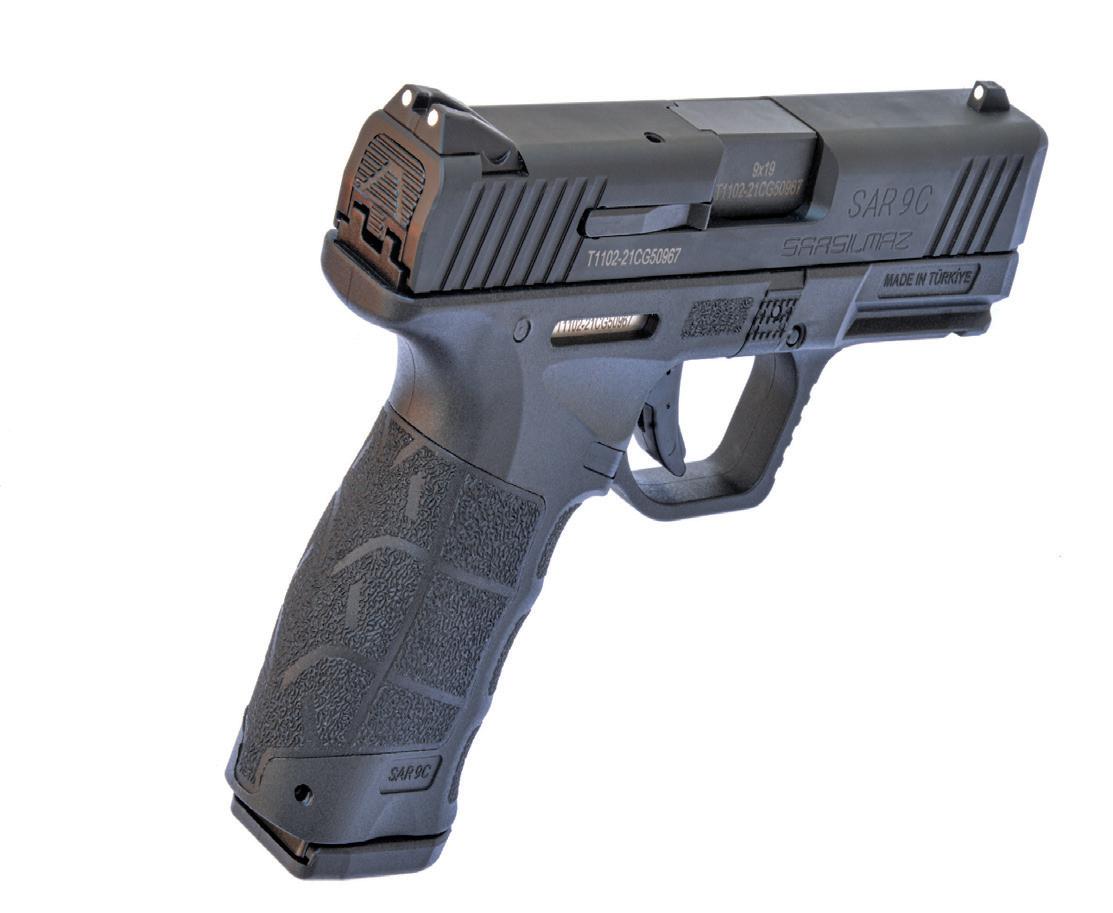
pushed the muzzle of the pistol upward in my grip. If you find the pistol pointing naturally high or low with one backstrap, try another to tailor it to your hand. In a personal defense handgun, the SAR9C’s customizable grip is a feature that could really make a difference.
I tested the pistol for accuracy from a benchrest, firing a series of five-shot groups at 25 yards and recording velocity with a Competition Electronics Pro-Chrono DLX digital chronograph 15 feet from the muzzle. It’s a nice surprise when you find a gun that shoots the
The author prefers a leather holster. An excellent and versatile choice is the all-American-leather Triple-K Victor line of OWB holsters. They can be molded or just broken in with use for a custom fit on a wide range of autoloaders.
A deeply undercut trigger guard, rear sweeping grip angle and high beavertail seat the SAR9C rather deeply in the hand compared to its contemporaries. Threedot combat sights are standard. The external ejector serves as a visual loaded-chamber indicator.


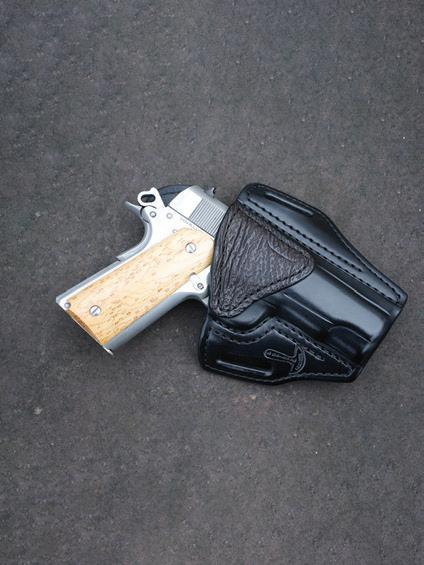




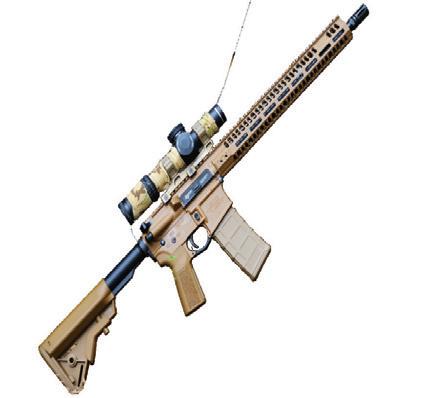




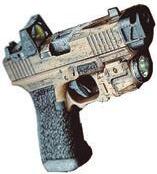






americanshootingjournal.com 115 kusiakleather.com 210.729.2777 TEXAN 2.0 IWB HOLSTER Quality Handmade Holsters, Knife Sheaths, & Accessories rgrizzleleather.com ryan@rgrizzleleather.com 706-265-0118
and
Specializing in performance aftermarket modifications
Crafted by: Ryan
Kay Grizzle
gun review
bargain ammo as good or better than the premium stuff. Steel-cased Barnaul 115-grain FMJ averaged groups of 2.34 inches center-to-center and 1,129 feet per second. Hornady’s 124-grain XTP JHP averaged 2.72-inch groups and 1,101 fps. Winchester Super-X 115-grain Silvertip JHP grouped 2.92 inches and 1,178 fps. At 25 yards, my groups were all centered 2.5 inches above the point of aim. With a mixed bag of loose 9mm range leftovers, I did some standing, two-hand-hold shooting at 7 yards on bull’s-eye targets and found the SAR9C could pile a full 15-round magazine into a ragged 1.50-inch hole.
Right out of the box, my test pistol functioned perfectly with all the ammunition tested. I found the threedot sights allowed precise shooting when the lighting conditions made it difficult to use the Patridge sights in the normal manner. The correct sight picture with the Patridge sights is reproduced when the top of the front
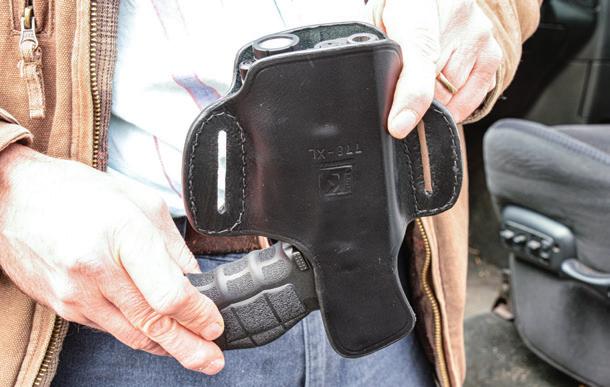
sight dot is level with the tops of the two rear sight dots. Both front and rear have sloped sides to prevent snagging, and are made of steel for durability. The rear is adjustable for windage and secured in place with an Allen screw.
You can spend a lot more on similar scaled-down versions of 9mm service pistols from makers with more familiar names, but the SAR9C delivers the most value for the money. Frankly, I’d take this over any Glock any day.

116 American Shooting Journal // June 2024
The Victor XLsize holster will accommodate the SAR9C with a tactical light installed.
MAKING THE CUT
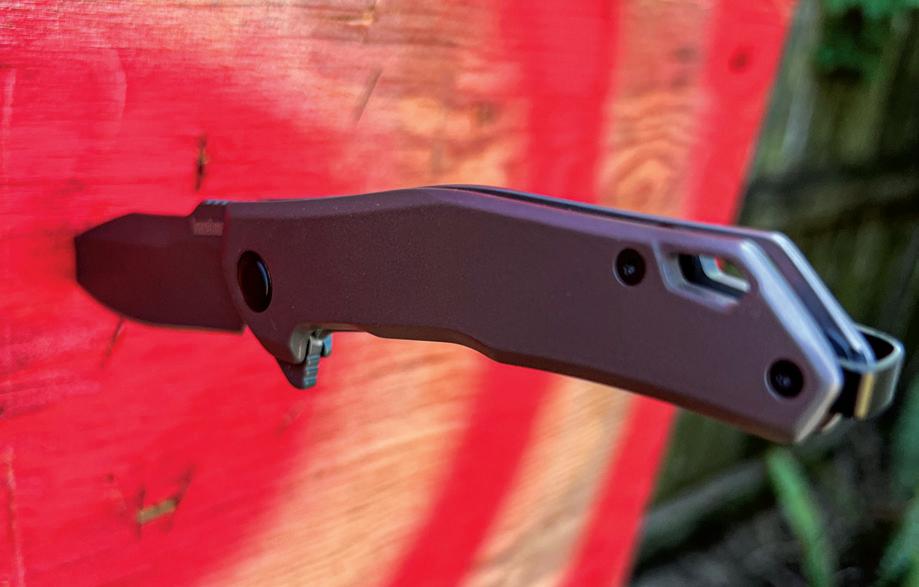
KERSHAW’S TACTICAL FOLDING KNIVES
Reviewing the reverse tanto Iridium and the Helitack.
STORY AND PHOTOS BY PAUL PAWELA
elcome to the brand-new column Making the Cut, covering blades, knives and anything with sharp edges. Throughout history, warriors and civilians alike have depended upon primary and secondary weapon systems – and their training in each – for both war and personal defense. From the Revolutionary and Civil
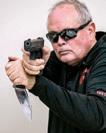
WWars in America to the current global war on terror, the fighting man has always had a primary and secondary weapon system; this can be observed in our modern law enforcement and military units.
Special operations personnel are well trained and armed with primary carbine rifles, shotguns or subguns and secondary small-bore semiautomatic pistols in either .45 ACP or 9mm. And one would also be hard-pressed to find any operators without a knife clipped or strapped to
some part of his body.
Similarly, as constitutional carry laws sweep across the United States, many concealed carry weapons permit holders, and those openly carrying, not only have firearms on their person, but also some type of clip knife. With so many clip knives on the market, it is a task to figure out which is right for us.
THERE ARE INDUSTRY guidelines to follow, and we will look at some of these to help us with our purchase.
americanshootingjournal.com 117
A good knife has been a critical tool and/or self-defense weapon since time immemorial and in this new column, contributor Paul Pawela aims to detail all things sharp-edged that meet the task.
MAKING THE CUT



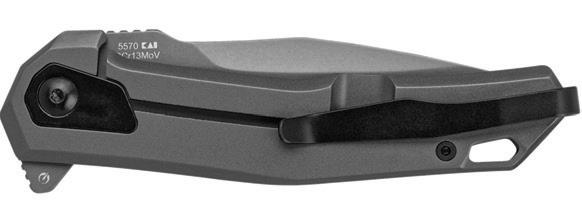
The ideal pocket folding knife will be used for both utility purposes and the possibility of self-defense. The knife should have robust construction, especially at the joint, because the folding “survival” knife may be required for extreme tasks such as cutting a good T-bone steak or through cardboard boxes. The knife should have a strong and reliable lock because the blade closing on the user’s fingers could cause disabling injuries, and in a survival situation could lead to infection and possible loss of fingers.
The knife should have a onehanded-open capability because the user may only have one hand available due to injury or simply having the other hand occupied. The knife should have a pocket clip because it protects the folder against loss and makes it readily available. For many, a welldesigned and executed folder with these features and a 3½- to 4½-inch blade has replaced the small fixed blade.
Michael Janich, master knife instructor, offers some other criteria to consider in a personal defense knife: “Is your carry knife design physically adequate for personal defense regarding blade length, shape and strength? Is the carry option compatible with all your dress styles?
Is the carry option consistent with the image you want to present? Is the knife comfortable to carry in that position? Is the knife easily retrieved one-handed with either hand? Is the knife accessible when you are seated in a vehicle in a disadvantaged position? If you carry your knife for utility and personal defense, does it adequately meet both needs? Are the legal consequences of carrying your knife more serious than you are willing to endure if it is found on your person? Does the knife work effectively with your personal knifefighting style?”
These are all very important items to consider. For me, another consideration is cost. If the knife is not at a reasonable price point, then all else is pointless (no pun intended).
SOME OF THE first knives we wanted to look at in the Making the Cut column are those manufactured by Kershaw (kershaw.kaiusa.com).
Pete Kershaw founded the company in 1974 at a cement plant in Lake Oswego, Oregon. In the beginning, he mainly created hunting knives. He wanted to design and manufacture tools that knife users would be proud to own, carry and use. Kershaw knives must be of the highest quality, regardless of whether they are
118 American Shooting Journal // June 2024
Kershaw Iridium. (KERSHAW)
Kershaw Helitack. (KERSHAW)
The Helitack features a reversible deep-carry pocket clip. (KERSHAW)
The reverse tanto Iridium opens via thumb stud and has a very smooth deployment thanks to KVT ball bearings. (KERSHAW)

MAKING THE CUT
used as a hardworking pocketknife, a hunting knife, a self-defense weapon or a special collector’s edition.
I have had my eye on the Kershaw Iridium for some time now due to its impressive design. Much to my surprise, Kershaw sent me two excellent knives to test and review: the reverse tanto Iridium and the Helitack.
We will first start with the reverse tanto Iridium, which is both practical and stylish for everyday carry. I found the blade to be very sharp out of the box, and the tanto style makes it easy to cut both everyday and hard-to-get items, including tie-down straps and plastic.
The reverse tanto Iridium opens via thumb stud and has a very smooth deployment thanks to KVT ball bearings. The ultra-secure Duralock technology locks the blade in place, and one can slide back or flip the blade out by using the side button on the handle. The knife also comes with a deep-carry pocket clip that is reversible on either side.
The reverse tanto Iridium folds down to 4 5 inches and weighs a mere 3 3 ounces. The blade is made of D2 high-carbon tool steel, which offers excellent edge retention and wearresistance. The knife won’t break the
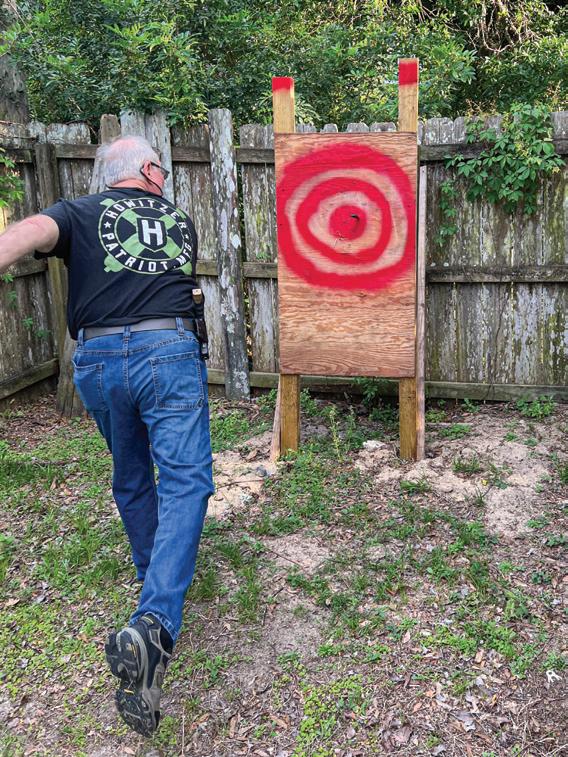
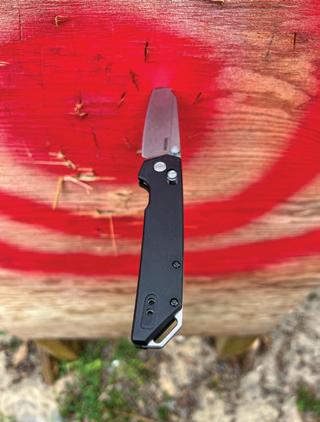
bank at $79 99
The other Kershaw tactical knife I tested was the Helitack. One of the great – and I mean great – features of the Helitack knife is its flipper for one-handed assisted opening. The knife is very safe to deploy with a secure frame lock and an overtravel stop. The Helitack blade is a little over 3.25 inches, and the reversible deep-carry pocket clip makes carrying the knife very discreet. The blade is 8Cr13MoV steel, which both takes and holds an edge. The Helitack can be purchased at the outstanding price of only $51 99
I PUT BOTH Kershaw knives through a grueling series of tests in the Florida elements, and I tried my best to destroy them. First, I threw both blades into my knife-throwing wooden target multiple times; the blade tips survived, and the blades did not break. Next, I used the blades to cut various materials without difficulty, and throughout my testing, the mechanics never failed. Both blades stood up to my test.
I also had Angelika Russo, a thirddegree black belt instructor at Russo’s Kenpo Karate, put the Helitack knife through its paces. When training her
120 American Shooting Journal // June 2024
Pawela put the Kershaw knives through a series of tests, including throwing both blades into a wooden target multiple times (top) and cutting various materials. Throughout his testing, the mechanics never failed and both blades stood up to the challenges.


americanshootingjournal.com 121
MAKING THE CUT
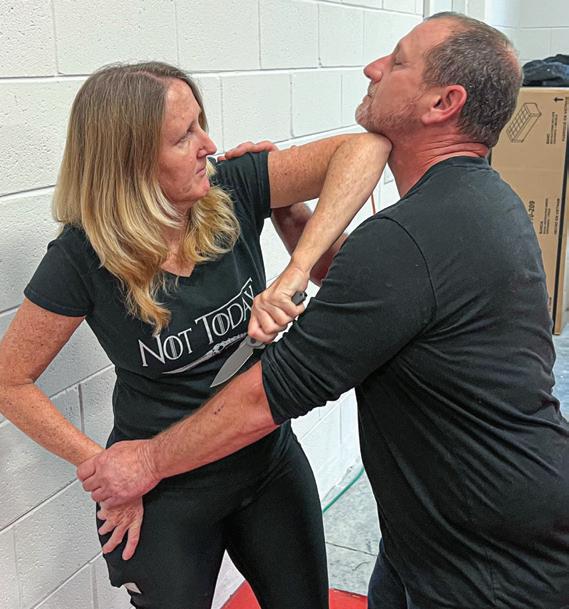

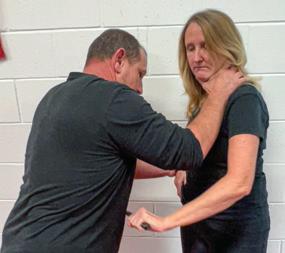
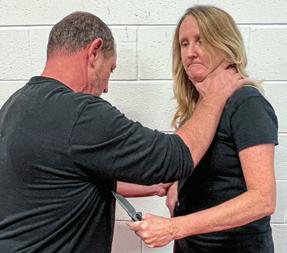

students, Russo knows very well that lives are at stake, so her subject matter must be spot-on! She tested both knives, carrying them as she does her self-defense tools, with a firearm on her right side and a backup on her left. The Helitack was her logical choice, as she was able to access and open the knife in about 1½ seconds.
Standing at 5-foot-2, Russo’s motto is “Not today,” meaning not today – or ever – will you attack, assault, rape or murder me! Armed with her firearm and the Helitack, she has confidence that she can teach anyone, male or female, a self-defense curriculum in less than an hour to defend one’s life for the rest of their life. It is fitting that, in part, Helitack means to attack.
With the outstanding features on both the Iridium and the Helitack, along with the warranty the company offers, can you afford not to have one of these great knives on your person? These Kershaw tactical folding knives definitely make the cut! ★
Editor’s notes: Author Paul Pawela dedicated this article to the memory of Maddie Soto, a Florida teenager who was recently found murdered. We at American Shooting Journal extend our prayers to the Soto family. Pawela is a nationally recognized firearms and self-defense expert. For his realistic self-defense training, see assaultcountertactics.com.

122 American Shooting Journal // June 2024
Angelika Russo, a third-degree black belt instructor in Florida, also tested both knives, carrying them as she does her self-defense tools. The Helitack was her logical choice, as she was able to access and open the knife in about 1½ seconds.
(SOTO FAMILY)

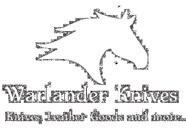













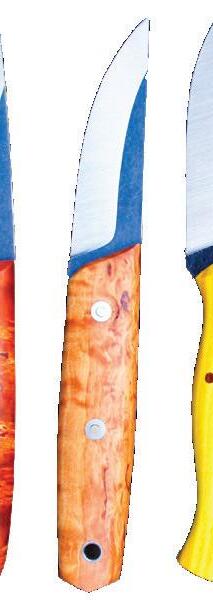






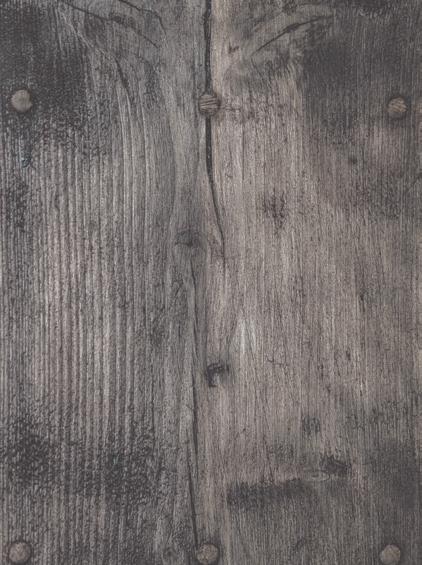

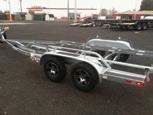





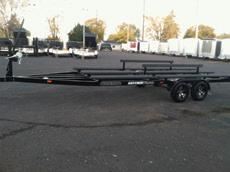
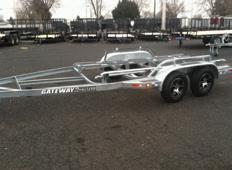
americanshootingjournal.com 123 Handcrafted Heirloom Quality Knives & Leather Goods made in america warlanderenterprises.com scan for more info warlander_enterprises crayoneatercoffee com Coffee for the Crayon Eater that wants to make something special (Roasted in a peanut/tree nut FREE facility) Reliable Quality Service & Craftsmanship For Over 50 Years! • NMMA Certified • All Steel Weld Frame, Fenders & Bunks • 2 YEAR WARRANTY Custom Boat Trailers 343 Thain Rd., Lewiston, Idaho • www.gateway-materials.com • 208-743-0720
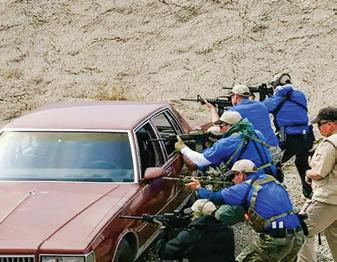
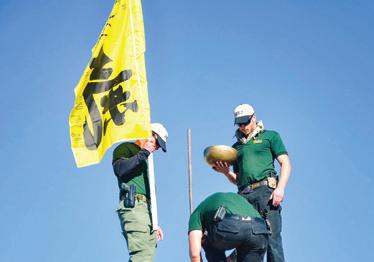
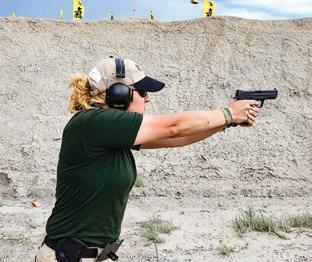


BEGIN YOUR CAREER IN EXECUTIVE PROTECTION OR CORPORATE SECURITY TODAY.


IN PRAISE OF PROACTIVE POLICING
How a missing license plate spotted by a trooper led to the capture of the Oklahoma City bomber.
STORY BY NICK PERNA
COURTESY
There are all types of police officers out there. Ones who like to do deep dives into investigations and make good cases. Those who do it for the adrenaline rush, the excitement brought on by a vehicle pursuit or a foot chase. There are the ones who give back to the community, coaching department-sponsored sports teams for disadvantaged kids and other community-based projects.

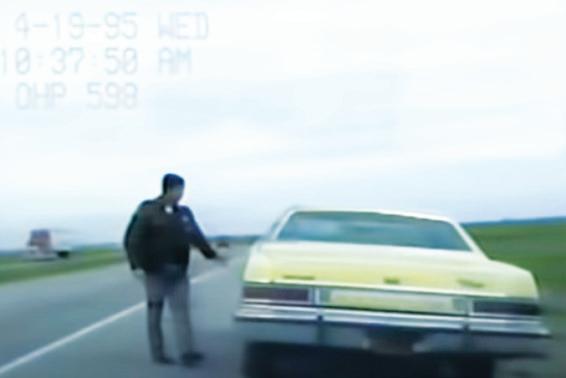
The one common characteristic seen in good cops is being proactive. Intentionally doing some aspect or aspects of their job to make the world a better place. Showing up for work with the intention of seeking out stuff to do.
For cops who work the road, this proactive behavior can take place in many forms, the most common of which is looking for violators, contacting them and taking a course of action. This course of action can be a warning, citation or arrest. For troopers, and many other cops, traffic stops are their bread and butter. They stop cars to change bad behavior like speeding and to root out drunk drivers and other crimes.
SOMETIMES IT’S A minor, seemingly unimportant violation that leads to a major arrest. Such was the case on April 19, 1995. For most, the date probably doesn’t hold any particular significance, but it was a terrible day for every American, with a win for one
proactive trooper.
On that day, a suspect parked a rented truck in front of the Alfred P. Murrah Federal Building in Oklahoma City, Oklahoma. The truck was loaded with over 2 tons of ammonium nitrate fertilizer and fuel oil. It was designed to blow up and when it did, it killed 168 people. Some of those killed that day were children who were in the daycare center in the building where their parents worked.
Oklahoma State Trooper Charlie Hanger was working the road that day. He observed a yellow Mercury Marquis on I-35 with a missing license plate. He pulled the vehicle over and observed a clean-cut young man in the driver’s seat, the car’s only occupant. At that moment he got the feeling that something wasn’t quite right. Maybe it was the heightened sense of awareness brought on by the events that had transpired in Oklahoma City just a little over an hour prior.
Maybe it was years of experience, “Spidey sense” or divine intervention; regardless, Trooper Hanger got a gut feeling and adapted his tactics accordingly. Instead of approaching the vehicle, he ordered the driver out. Trooper Hanger noticed a bulge in the young man’s jacket and recognized it to be a gun. Trooper Hanger drew his own weapon and took the suspect into custody. He arrested him and booked him on a concealed weapon violation.
In the coming days, the FBI was able to connect the dots between the Oklahoma City bombing and the suspect that Trooper Hanger had stopped a short distance away. As you probably guessed, the man behind the wheel was none other than Timothy McVeigh, the Oklahoma City bomber. After arresting McVeigh and prior to going out of service, Trooper Hanger searched his patrol vehicle. In it, there was some paperwork that McVeigh had
americanshootingjournal.com 125
L.E. SPOTLIGHT
OF OKLAHOMA CITY NATIONAL MEMORIAL AND MUSEUM FACEBOOK PAGE
PHOTOS
Proactive police work led to the arrest of the Oklahoma City bomber Timothy McVeigh by Oklahoma State Trooper Charlie Hanger, who noticed a car with a missing license plate the morning of the attack.
L.E. SPOTLIGHT
discarded that indicated he was trying to purchase dynamite.
McVeigh, a Desert Storm veteranturned-anarchist with anti-government sentiments, was eventually arrested by the FBI for the bombing. He was given the death penalty and was executed on June 11, 2001.
Given all that was going on that day outside of Oklahoma City, Trooper Hanger would have been excused if he chose to overlook that missing plate. But he didn’t, and the rest is history.
Editor’s note: Author Nick Perna is a sergeant with the Redwood City Police Department in Northern California. He previously served as a paratrooper in the US Army and is a veteran of Operation Iraqi Freedom. He also has a master’s degree from the University of San Francisco. He is a frequent contributor to multiple print and online forums on topics related to law enforcement, firearms, tactics and veterans issues.


126 American Shooting Journal // June 2024
Trooper Hanger went on to become the sheriff of Noble County, Oklahoma, located about an hour north of Oklahoma City and where he arrested McVeigh in April 1995. He retired at the end of 2020.




























 Spencer, Don Jr. and Donnie Trump start a morning off with smiles and fists full of feathers.
Spencer, Don Jr. and Donnie Trump start a morning off with smiles and fists full of feathers.




















































































































































 Competitors in the third season of the show Surviving Mann, named after host Don Mann, a veteran of SEAL Team 6, were put through not only individual challenges, but also team challenges. Episodes begin airing this summer.
Competitors in the third season of the show Surviving Mann, named after host Don Mann, a veteran of SEAL Team 6, were put through not only individual challenges, but also team challenges. Episodes begin airing this summer.














































































































 BY FRANK JARDIM
BY FRANK JARDIM








































































